Australian
and international
exploratory
performance and
media arts
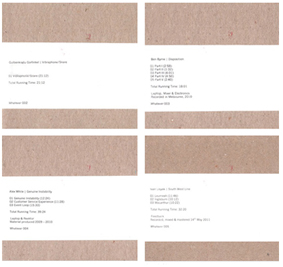
Avantwhatever 002-005
avantwhatever 002-005
www.avantwhatever.com
Avantwhatever is the organisation established by Ben Byrne to promote and publish his own works and those of his peers through concerts and also limited edition CDs. Matt Chaumont’s Linea started the collection in 2010 (reviewed here) with offerings by Arek Gulbenkoglu and Dale Gorfinkel, Alex White, Ivan Lysiak and Byrne himself coming out in reasonably rapid succession. While each of these artists has a distinctive approach, there is a shared sense of austerity—a serious, focussed and unadorned investigation into the essence of their materials—giving Avantwhatever a ‘house style,’ also reflected in the almost identical covers made from basic brown recycled paper.
002 gulbenkoglu gorfinkel, vibraphone/snare
Vibraphone/Snare, a single track running for just over 21-minutes, is an improvisational pursuit of vibration. Gorfinkel on prepared vibraphone and Gulbenkoglu on snare, are united in their love of small motors that they apply to their instruments (Gorfinkel also utilising the inbuilt motor of the vibraphone) and it is often impossible to tell who is generating which sound. The hum of insect-like motors underpins nearly everything, however the detail is in the changing pitches of the drives and the range of rattles, flaps and rumbles elicited from various applications. The materials dictate the structure, as new tones and hums, semi-regular rhythms and unforseen eruptions guide the players into the next moment. The recording (Rosalind Hall) is also unfussy, with a central focus, and not so much sense of the room in which it is performed. Small details play out on the edges of the stereo field, but never distract from the core of sounds in the middle. There’s no adornment here, only actions and sonic consequences blurring to create a kind of ascetic music.
003 ben byrne, disposition
Byrne’s contribution on laptop, mixer and electronics is the shortest of the selection running at 18-minutes. There is a clear sense of structure, both within the pieces themselves and the composition as a whole, divided across five distinct sections. “Part I” introduces Byrne’s sounds, dense with digital bleeps, spurts, glitches and fricatives always kept on the edge of chaos. “Part II” introduces a brief and elusive calm in the form of high, pinging, tinnitus-like tones. This is rudely swept away by “Part III”—the longest track and offered as a centrepiece of abrupt eructations, all angles and sudden shifts, with big fat squelchy sounds coarsely ground. “Part IV” maintains tension, and while never approaching figuration, seems darker and more urgent, with insistent longer tones and a clearer feeling of phrasing. Finally “Part V” seems to combine approaches from all the previous sections, somehow offering a simultaneous sense of fragmentation and sustain. While it’s a short set, the focus on structure makes Disposition satisfyingly intense.
004 alex white, genuine instability
The loudest and nastiest sounding of the collection, White’s CD Genuine Instability, made using Reaktor software, offers the most emotionally engaging listening experience perhaps because it’s the first of the series to use figurative track names. The title track, “Genuine Instability,” offers just that with signals pushed until they disintegrate; wide, dirty tones stretching and breaking across the stereo field; coarse granules disappearing into split second silences. “Customer Service Experience” is full of insistent, insect buzzes and heavy electromagnetic sounding hum. Phrasing is strong as sections shift in and out of focus, agilely scanning through the frequency spectrum and petering out to high impotent pings. “Event Loop” also delivers on its promise with a densely textured phrase that loops for over 15-minutes, but which invites an almost psychotic attention to detail as you start to hear minuscule shifts in the static. Best at volume, White’s work becomes visceral, curiously embodied despite its utterly digital origins.
005 ivan lysiak, southwest line
For this release, Ivan Lysiak works purely with feedback generated from guitar, amps and pedals. Each of the three tracks, named after train stations on Sydney’s south- west rail line, runs to just over 10-minutes with each exploring a different feedback pursuit. “Leumeah” works with a mid-range pure tone that develops octave harmonics devolving in to lower hums. Silence is allowed as signals falter and break, only to be built up again. Most surprising is a kind of trumpet-like repeated note that finally devolves into a flat nasal whine. “Ingleburn” works with a higher tone, over- and under-tones hovering on edges that eventually invade and morph into low flutters. The final track “Macarthur” surprises again with faster transitions between notes and a growing, crackly electrical interference that Lysiak shreds into ever-smaller units. South West Line is sparse, yet never static, with a constant sense of sound waves in motion, evolution and entropy.
Avantwhatever recordings are quintessentially and unapologetically difficult listening. Having heard all these artists play live, there is definitely something more satisfying in experiencing their works live and in the moment, no matter how much or how little gestural performativity is needed to make them. A large sound system and the collective listening experience better allows for the level of concentration required to really appreciate the impact of these sounds. However it’s important that these practices are documented, and Avantwhatever is creating a vital collection of some of the most interesting and challenging music currently being made.
Gail Priest
RealTime issue #105 Oct-Nov 2011 pg. web
© Gail Priest; for permission to reproduce apply to realtime@realtimearts.net
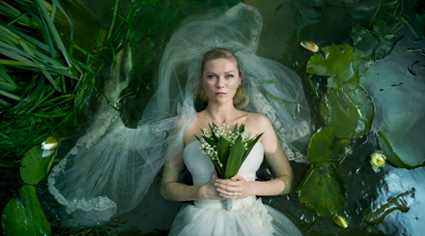
Melancholia, Lars von Trier
cinema exotica from home and abroad
For its 20th manifestation, the Brisbane International Film Festival is offering a range of exciting cinema experiences including Australian and world premieres. In terms of big draw cards there’s David Cronenberg’s A Dangerous Method, exploring the relationship between Freud, Jung and patient and pupil Sabina Spielrein. Provocateur Lars von Trier’s Melancholia starring Kirsten Dunst, which supposedly left the audience gasping in Cannes, will also be screening. Direct from Venice and Toronto Film Festivals comes an adaptation of John Le Carre’s Tinker, Tailor, Soldier, Spy by Swedish director Tomas Alfredson (Let The Right One In, 2008) with Gary Oldman as George Smiley and described by one reviewer as “at its best as a study in minimalist aesthetics and cool, sombre, low-tech interiors.” The festival will conclude with Pedro Almodóvar’s much acclaimed, The Skin I Live In, about an obsessive plastic surgeon (Antonio Bandera) who imprisons the object of his experiments (Elena Anaya).
There’s also a strong horror and sci-fi flavour to this year’s festival. Starting on November 12 and finishing in the wee hours of the 13th is the Horror Marathon including Guilty of Romance (see RT’s review from SUFF) and Mannborg by Canadian Z-grade director Steven John Kostanski, about a half-man, half-cyborg who fights Nazi vampires. From Argentina comes Nicolás Goldbart’s Phase 7 described as “slacker comedy meets bio-apocalypse” (website). Also from Argentina is Penumbra, directed by “horror cinema’s answer to the Coen Brothers” Adrián and Ramiro García Bogliano.
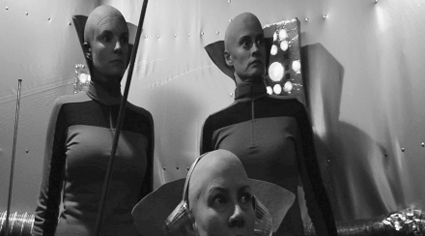
Codependent Lesbian Space Alien Seeks Same, Madeleine Olnek
The Drive-In program includes the impossible to resist Codependent Lesbian Space Alien Seeks Same directed by Madeleine Olnek as well as Trailerpalooza, a whirlwind tour of sci-fi and horror trailers from the last 50-years presented by Mark Hartley playing in a double-bill with 50 Best Kills (which needs no descriptor). Australian films include the premiere of Crawl, a feature debut by Paul and Benjamin China which channels “the tension of Hitchcock and the measured violence of the Coen Borthers’ No Country for Old Men” (website); and Kriv Stender’s Red Dog, where you are encouraged in fact to BYOD—finally the canine verdict on this runaway success!
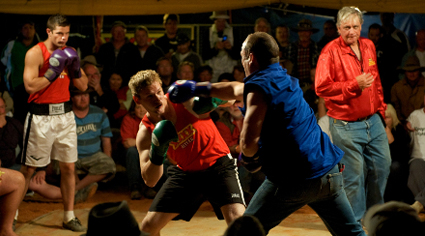
Outback Fight Club, Paul Scott
Also featured are a range of Queensland films and documentaries including two by Hungarian-born, Brisbane-based Peter Hegedus, My America and The Trouble with St Mary’s; Janine Hosking’s portrait of Chad Morgan (The Sheik of Scrubby Creek), I’m Not Dead Yet; Paul Scott’s Outback Fight Club, documenting the final days of the only touring boxing tent left in the world; Daniel Marsden’s journey into the art of the Torres Strait Islands, So The Clouds Have Stories; and Tony Krawitz’ The Tall Man, a reconstruction of the events surrounding the death of Cameron Doomadgee on Palm Island (see RT review of Adelaide Film Festival). Brisbane International Film Festival, various venues, Brisbane, Nov 3-13; www.biff.com.au/
arts fertiliser
Emerging artists and arts workers in South Australia looking for tips on how to sustain a life in the arts should check out How Does Your Arts Career Grow?, a free panel discussion organised by the Adelaide Festival Centre and Carclew Youth Arts. The forum will bring together leaders in arts and culture in South Australia with young and emerging artist to share thoughts and advice on how to develop and manage a career and how young people can shape the future of the arts. Key industry professionals involved are Christie Anthoney (Creative Director, Adelaide College of the Arts) who will facilitate the panel, Annette Tripodi (Operations and Program Manager, WOMADelaide), Brigid Noone (independent artist/curator), Edwin Kemp Attrill (Artistic Director, University of Adelaide Theatre Guild) and Ianto Ware (Project Manager, Renew Adelaide). Space Theatre, Adelaide Festival Centre; Oct 31, free; www.adelaidefestivalcentre.com.au/greenroom/how-does-your-arts-career-grow-2/
In Brisbane, Backbone Youth Arts is hosting the Future Voices Forum with a focus on “local needs and international trends” (website). Taking place in two parts the first will concentrate on Australia and the ‘Asian Century’ with panelists including Andrew Ross (Artistic Director, Brisbane Powerhouse), Cathy Hunt (Co-Founding Director, Positive Solutions) and Thom Browning (Artistic Development Coordinator, Imaginary Theatre). The second session will be an Open Spaces Dialogue led by Jim Lawson (Executive Director, Young People and the Arts Australia) taking off from provocations raised at the National Youth Theatre Summit at St Martin’s in September [http://www.stmartinsyouth.com.au/national-youth-theatre-summit/]. The Future Voices Forum is part of the 2high festival, a one-day invasion of the Brisbane Powerhouse by young and emerging performance makers and visual artists. 2high Festival, presented by Backbone Youth Arts, Oct 29, Brisbane Powerhouse; www.backbone.org.au/2high-festival/; Future Voices Forum, Visy Theatre, Oct 29, 10am www.backbone.org.au/artist/2953/
evolving fictions
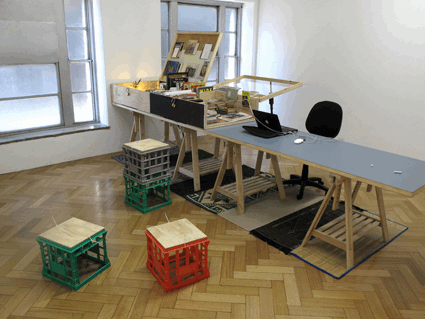
Adam Cruickshank, The Half Asleep Pilgrim, work space
courtesy the artist
Adam Cruickshank, The Half Asleep Pilgrim, work space
Over three weeks, multi-disciplinary artist Adam Cruickshank will reside in West Space writing and designing The Half Asleep Pilgrim. A collage of written and visual material will be drawn from conversations with visitors and from the vast range of books that will also adorn the Back Space, borrowed from libraries and collections of the artists’ friends. At the end of three weeks the book will be finished, determined by the activity of that day rather than a pre-determined narrative. Cruickshank’s residency is one of 14 projects presented by West Space across 2011-2012 under the title Today Your Love which seeks to find ways artists might inhabit their new venue (twice the size of the old gallery) with a focus on process and experimentation over outcomes. Projects yet to come include Then & Now—the office of fixed deferrals (Back in 5) by the ever-intriguing Patrick Pound featuring an archive of photos, before and after shots, postcards of floral clocks showing each hour and other photographic ephemera which form an “index not only of time’s relentless melt, but of chance connections in the shuffle of things” (artist statement). Starting in development in 2011 for presentation in March 2012 will be a networked performance, Stay Home Sakoku: The Hikikomori Project, by Eugenia Lim, Dan West, Yumi Umiumare and David Wolf. Adam Cruickshank, The Half Asleep Pilgrim, West Space, part of Today Your Love; Oct 17-Nov 5; http://westspace.org.au
creative non-fictions
Tashmadada, the organisation which recently brought ex-La Fura Dels Baus performer Younes Bashir (see Underbelly Arts review) to Australia, is run by director-producer Deborah Leiser-Moore. She’s teaming up with US quarterly publication Creative Non-Fiction to create an Australian issue. They’re calling for essays across all forms with the only stipulations being that the stories be true and the articles unpublished. Two prizes are on offer, with the best essay (regardless of country of origin) winning AUS$6500 and an extra prize for the Best Essay by an Australian Writer winning AUS$2500. The edition will be launched as part of the 2012 Melbourne Writers’ Festival. Deadline Jan 31, 2012; each essay requires a $20 reading fee. See Tashmadada for more info: http://www.tashmadada.com; www.creativenonfiction.org
at the end of the journey
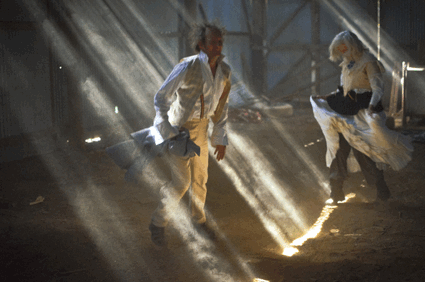
Homelands
photos James Brown
Homelands
Belgian director Hans Van den Broek (Compagnie SOIT) has returned for the third and final instalment of his collaboration with some of Sydney’s most interesting dancers and performance makers. In Settlement (2007) the group left civilisation to inhabit Track 8 in Performance Space/Carriageworks exploring ideas around utopia, communality and individuality creating a truly invigorating piece of dance-based performance. Nomads (2009), also in Track 8 focused on Diasporas, the group wandering away from one home in search of another. The final instalment, developed during an off-site Performance Space residency will be delivered as a video screening at FraserStudios and depicts the characters “held, floating like driftwood in time. They have found a fictional escape into life, hiding in a fantasy of fragmented theatre” (press release). Featuring Kathy Cogill, Nikki Heywood, Manu Louw, Clara Louw, Tony Osborne, Kirk Page, Anuschka von Oppen, Nalina Wait and Van den Broek with video by James Brown and Sam James. Homeland, video showing, October 27, 5pm, FraserStudios, 10-14 Kensington Street, Chippendale
Also nearing its end is the run of FraserStudios. Since 2008 Sam Chester and James Wynter and their team from Queen Street have done an amazing job managing these artists studios and rehearsal spaces in Chippendale, temporarily made available by the Fraser Property development group. The venture has had an immeasurable impact on the vibrancy of contemporary culture in Sydney (read about the studios in RT91). Running for longer than originally anticipated, it is now time to close the doors, but there will be one last open day on October 30 where you can see the artists at work, along with talks, demonstrations of digital fabrication technology by Assemblage Studio next door, and a barbeque. While it’s the end of an era, the impact of the initiative is tangible, not only as the Queen Street team have now taken on Heffron Hall in Surry Hills, but also as the range of commercial and government spaces now open to cultural activity is on the increase (see below). FraserStudios Open Day, October 30, 1-5pm, 10-14 Kensington Street, Chippendale; www.queenstreetstudio.com/fraserstudios.html
Breaking News: From 9 January-30 June 2012, Queen Street Studio and Frasers Property will offer NSW-based Visual Artists a “bonus round” of six-month open studio residencies. For more details go to www.queenstreetstudio.com/vis-arts-residency.html. Deadline Nov 18, 2011. Details of Performing Arts residencies will be announced shortly.
pop-up oxford street
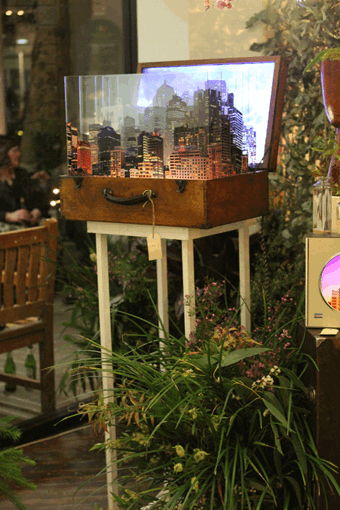
Rocks Pop-Up Projects, Perran Costi’s Personal Space: a living artwork, interactive exhibition, artists’ studio, bric-a-brac shop, teahouse and native garden
photos courtesy the artist
Rocks Pop-Up Projects, Perran Costi’s Personal Space: a living artwork, interactive exhibition, artists’ studio, bric-a-brac shop, teahouse and native garden
The range of ‘Renew’ ventures started by Marcus Westbury, kicking off in Newcastle and virally spreading to include Townsville, Adelaide and Geelong, has now been amalgamated under the Renew Australia moniker overseen by the Australian Centre for Social Innovation. In Sydney there’s Pop-Up-Parramatta and in the last six months The Rocks Pop-Up project has seen four heritage buildings turned over to artists studios and creative spaces for six months. (See image, Costi’s collaborative work Case Study was reviewed at Underbelly Arts.)
Now the City of Sydney is calling for tenders from artists, creatives and collectives interested in the short-term inhabitation of two retail shops and 14 office suites on Oxford Street—a unique opportunity to infiltrate the heart of the city! Deadline Nov 9, 11am, advertisements EOI 0811 and EOI 0911 can be viewed at http://www.cityofsydney.nsw.gov.au/Business/TendersEOIQuotes/CurrentListing.asp
RealTime issue #105 Oct-Nov 2011 pg. web
© RealTime ; for permission to reproduce apply to realtime@realtimearts.net
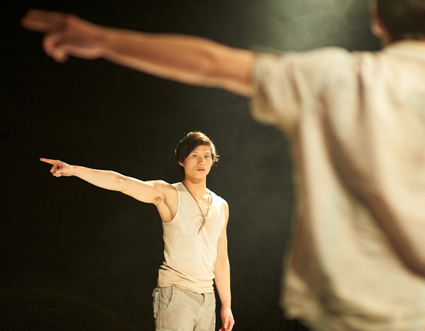
Hoa X, Guy, Simon, Lucky, IPAN
photo Robbie Pacheco
Hoa X, Guy, Simon, Lucky, IPAN
OVER THE PAST DECADE, NUMEROUS PERFORMANCES HAVE BEEN MADE BY, WITH AND ABOUT REFUGEES AND ASYLUM SEEKERS (SEE OUR ARCHIVE HIGHLIGHT). A CURRENT ESTIMATE PUTS THE AUSTRALIAN TOTAL AT APPROXIMATELY 40 PRODUCTIONS AND RISING. MOST RECENTLY, I SAW THE INTERNATIONAL PERFORMING ARTS NETWORK’S LUCKY, PART OF THE NEW THEATRE’S THE SPARE ROOM INITIATIVE FOR INDEPENDENT ARTISTS AND COMPANIES.
The character of the title, Lucky, never actually appears: he apparently set sail some time ago and has not been heard from since. Instead, the play, by Dutch author Ferenc Alexander Zavaros, focuses on his two brothers Dannybird (Hoa X) and Abduma (Guy Simon) whom we meet just as they too decide to flee. These opening scenes, ably directed by Sama Ky Balson, alternate between action and commentary, so that one actor says “I have to leave” and the other adds: “I tell my mother.” This device soon disappears, however, as the brothers board the raft with a third man, Mister John (Drew Wilson), who is their guide and people smuggler. Together the three men cross an unnamed sea towards an unnamed country, with little more than a container of water, a radio and some rope. We never find out if they arrive.
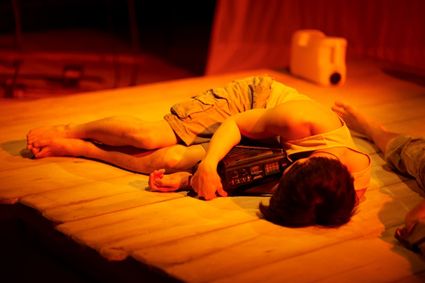
Hoa X, Lucky, IPAN
photo Robbie Pacheco
Hoa X, Lucky, IPAN
During this journey, the brothers reminisce about their mother whom they have left behind, and their brother who has left them. In language that sounds like a libretto they wonder where Lucky is, what he is doing and why he hasn’t written. Eventually it becomes clear that the other “birdboy,” as Mister John calls him, has probably perished at sea raising the possibility that one of the brothers may in fact be a ghost. Indeed sometimes their speech is strangely haunting while at other times it is repetitive; occasionally both—“my little brother forgets all that he has forgotten.” The people smuggler speaks in an elliptical, nonsensical English. Initially the device works to suggest the language gap, in a manner similar to a masterful scene in Brian Friel’s 1980 play Translations, but eventually it starts to grate.
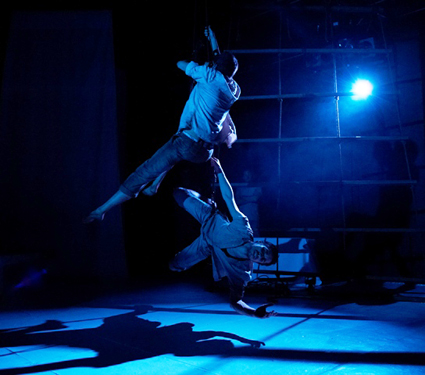
Hoa X, Guy Simon, Lucky, IPAN
photo Robbie Pacheco
Hoa X, Guy Simon, Lucky, IPAN
In fact the best parts of the production happen when speech falls away completely and movement (co-directed by Kirk Page) comes to the fore. Two of the performers (Simon and Wilson) do some beautiful rope work, hanging from the ceiling and bouncing off the vertical wooden frames that surround the white raft resembling a ship’s rig (designed by Sama Ky Balson). In one scene, there is a strikingly choreographed struggle and in another the performers seem to be spinning in the sea. Unfortunately this scene is hampered by low ceilings preventing them from attaining any real height or speed. Nor does the music help: while it is ambitious and the melodies pleasant, the vocals are too loud and the lyrics too literal: “I’m following the water/ Internally displaced people/ Generalised violence.” Similarly literal are shadows made by a fourth performer and singer (Conrad Le Bron): the characters see a bird and his hands flap behind the cream-coloured sails that hang upstage. In such moments the performance becomes less than the sum of its parts, with the music, text and movement working against, rather than with, each other.
While Lucky includes some poignant moments, it is also slow and often sentimental. A lack of specificity, rather than implying universality, reads as a vague and generalised attempt to tell “the” story of “the” refugee when no such thing exists—refugees, as a group, are as diverse and contradictory as any other. I try to encounter each performance on its own terms, but I can’t help comparing Lucky to Khoa Do’s Mother Fish—a magical, universal and yet deeply personal representation also of a boat journey. Both the theatrical and cinematic versions of Mother Fish were masterful. Alongside them and others in the genre, Lucky seems an apprentice work with a way to go before it can refresh the form.
International Performing Arts Network, Lucky, writer Ferenc Alexander Zavaros, director, set designer Sama Ky Balson, collaborative moment director Kirk Page, lighting Ross Graham, costumes Azure Chapman, musical director Karina Bes, sound designer, composer Joseph Nezeti, performers Guy Simon, Hoa X, Drew Wilson, Conrad Le Bron, New Theatre, Newtown, Oct 6-22; http://newtheatre.org.au
RealTime issue #105 Oct-Nov 2011 pg. web
© Caroline Wake; for permission to reproduce apply to realtime@realtimearts.net
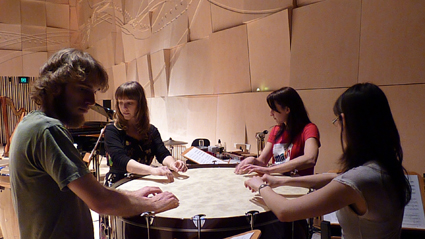
Chris Williams’ Il Pleut, Fresh Meat, 2011
photo Melody Eötvös
Chris Williams’ Il Pleut, Fresh Meat, 2011
THERE WAS A PALPABLE BUZZ OF EXCITEMENT AS ORGANISERS GLUED THEMSELVES TO MOBILE PHONES, ENSEMBLES REHEARSED LATE INTO THE NIGHT AND COMPOSERS FROM AROUND AUSTRALIA BOARDED BUDGET FLIGHTS IN THE LEAD UP TO FRESH MEAT 2011. PRESENTED BY MELBOURNE RECITAL CENTRE IN ASSOCIATION WITH THE NEW MUSIC NETWORK, THE EVENT SHOWCASED THE STRIKING DIVERSITY OF STYLES CURRENTLY BEING DEVELOPED BY EMERGING COMPOSERS. SIGNALLING A REFLECTIVE MUSIC SCENE, COMPOSERS COULD BE HEARD BALANCING TECHNICAL EXPERIMENTATION, METAPHYSICAL ANALOGY AND PROGRAMMATIC DEPICTION TO STARTLING AND THOUGHT-PROVOKING EFFECT.
the finite, the infinite & the infinitesimal
Melody Eötvös’ string quartet and Annie Hui-Hsinn Hsieh’s quartet for clarinet, violin, viola and piano were united by a Bartokian minor-mode lyricism and a rather sad metaphysics. In Olber’s Dance in the Dark based on Olber’s paradox—that the universe could not be infinite as then the night sky would be bright with an infinity of stars—Eötvös’ strident chords of increasing density gradually confirmed the universe’s finitude. A deflating proposition, until the increasing wonder of the chords’ harmonic invention leads one to contemplate the possibilities that are opened up by restriction, in this case the universe of tonal constellations.
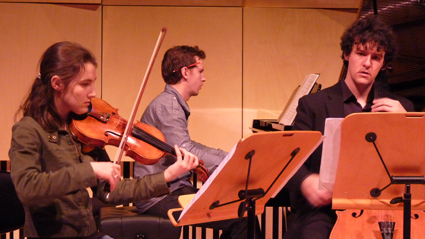
Hui-Hsinn Hsieh’s Towards the Beginning
Hui-Hsinn Hsieh’s Towards the Beginning conjures a Taoist, cyclic universe. However, the interest of this piece is not in the ABA form that arises from its subtext, but in the composer’s use of timbre. Multiphonics—combining a fundamental tone and a higher, harmonic tone—on the clarinet and strings produce an ethereal atmosphere from which a fragmented, modal dirge emerges. The coalescing snatches of melody are shattered by a chord from the piano, leaving the original shimmering surface in its wake.
Chris Williams’ percussion piece Il Pleut (based on Apollinaire’s poem) builds textures from infinitesimal points of sound. Through a sort of instrumental granular synthesis, washes of attacks build into blocks of sound that shift as the percussionists explore different instrumentation. As an examination of “the tension between the musical finite and infinite,” the piece was most interesting at the threshold between a sound and its parts, when staggered attacks were on train to coalesce or break apart.
sound encounters
Three works on the program looked at the way different instruments altered the same musical material. This idea is very, very old. At least until the advent of electroacoustic music the main way to discuss timbre was with reference to instrumentation. As such, musical ideas have always been subject to instrumental comment, even—I would argue—when instrumentation was not indicated in scores, at which times convention would have dictated the distribution of instrumental resources. It is therefore up to performers or a program to keep such naked exploration interesting.
Timothy Tate’s Departures focuses on sonic analogues between the clarinet, viola and piano. Viola pizzicati are interpreted as clarinet tongue slaps and plucked piano strings while glissandi become runs and arpeggios. With rapid question and answer phrases, the composition reminded me of a slapstick Loony Toons score, though this comic air was not to be found in the performance.
Alex Pozniak’s From the Formless, on the other hand, was hilarious. Favouring superimposition over juxtaposition, From the Formless has a crowded and chaotic texture. Simon Charles, Peter Dumsday and Jonathan Heilbron played up the comical energy of this pandemonium as the instruments, or rather the instrumentalists, simultaneously tried to make the scratchiest, burbliest, quackiest noises possible.
Such compositional devices do not always have to be humorous. Luke Paulding’s quartet for flute, clarinet, double bass and percussion combined juxtaposition and superimposition of timbres in graceful sound poetry. Titled In Her sparkling flesh in saecular ecstasy, the point of the work was not to find sonic analogues, but neighbouring sounds that lead the ear along the curves of a sonic sculpture: to be precise, the sonic sculpture that Paulding draws from Richard Wilbur’s poem “A Baroque Wall Fountain in the Villa Sciarra.” The largely impressionist sonic palette flows and splashes like Wilbur’s fountain: cymbal crashes and an arcing ejaculation from the clarinet release the cascade that rushes through rattling skewers and strikes of the double bass bow on the strings (“flatteries of spray”), shimmering woodwinds (“a clambering mesh of water-lights”) and a truly incontinent “ragged, loose collapse of water” played by all. The work concludes much as it begins, with the somehow obscene burbling of a clarinet mouthpiece in a glass of water.
percussive programming
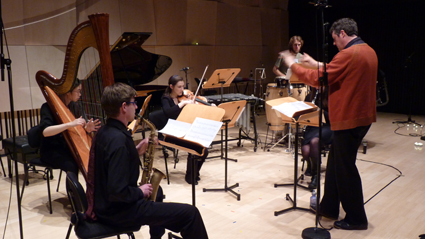
Amy Bastow’s Never OdD or Even, Fresh Meat, 2011
photo Melody Eötvös
Amy Bastow’s Never OdD or Even, Fresh Meat, 2011
Amy Bastow’s Never OdD or Even is a musical take on Obsessive Compulsive Disorder. Having suffered from OCD and Tourette’s Syndrome as a child I did feel a little uncomfortable when the ensemble entered the salon twitching and counting their steps. “Is this funny?” I asked myself. I suppose so, even if I couldn’t shake a certain sadness that stole over me during the performance. OCD is a living nightmare. The compulsion itself is less like a desire to be fulfilled than a pursuer in those dreams where you can’t run properly. Bastow brilliantly captures the persistent, exhausting nature of OCD. Right when it seems the driving rhythms, mockingly major-mode additive phrases and frenzied tempi have ceased they are back, louder and faster than ever. I particularly like Bastow’s wearied lyrical passages that express something of the beleaguered exhaustion proper to a day of obsessive counting, retraced steps and compulsive twitching. With a similar demonic force, Anthony Moles took the idea of small machines within larger machines to produce a driving solo piano piece, just as manically as mechanically performed by Peter Dumsday.
Invigorating works that would otherwise lie dormant in computer files, the performers’ commitment deserves special mention. In particular, clarinettist Karen Heath seemed to hold many of the performances together with the gestures and physical intensity proper to performing in small ensembles. The power of the performer was evident not only in the above works, but in the inspired execution of Joseph Twist’s jazzy Le Tombeau de Monk, Mark Wolf’s grotesque Hamarøy Troll, Mark Oliviero’s electro-acoustic memoir Tanox, and Nicole Murphy’s composition for ballet Eve.
Melbourne Recital Centre & New Music Network, Fresh Meat, 2011, composers Amy Bastow, Alex Pozniak, Annie Hui-Hsin Hsieh, Luke Paulding, Timothy Tate, Melody Eötvös, Chris Williams, Nicole Murphy, Anthony Moles, Mark Wolf, Mark Olivero and Joseph Twist; Salon, Melbourne Recital Centre, Aug 25
For more on young composers see review of Breaking Out at Totally Huge New Music 2011
RealTime issue #105 Oct-Nov 2011 pg. web
© Matthew Lorenzon; for permission to reproduce apply to realtime@realtimearts.net
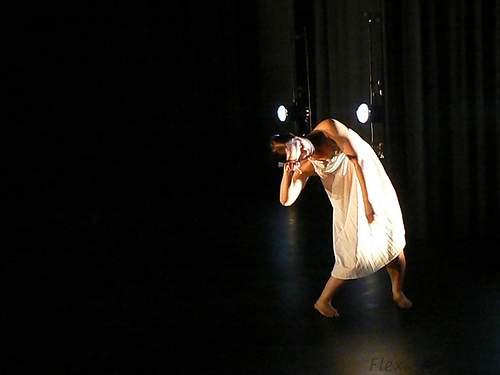
Katarzyna Sitarz, 2011 Tanja Liedtke Fellow
photo Flex
Katarzyna Sitarz, 2011 Tanja Liedtke Fellow
I SPOKE WITH KATARZYNA SITARZ, THE 2011 TANJA LIEDTKE FELLOW, AFTER SHE HAD SPENT TIME ON CREATIVE DEVELOPMENT WITH HER AUSTRALIAN COLLABORATORS IN MELBOURNE AND WORKING IN SYDNEY WITH CHOREOGRAPHER LUCY GUERIN, DIRECTOR SIMON STONE AND ACTORS AND DANCERS ON GUERIN’S COMMISSIONED WORK FOR THE 2012 BELVOIR SEASON. AFTER OUR MEETING SHE WAS ABOUT TO SPEND SEVERAL MONTHS EXPLORING AUSTRALIA. I ASKED HER ABOUT HER BACKGROUND, HER TRAINING, THE EUROPEAN ARTISTS SHE’S WORKED WITH AND WHAT ATTRACTED HER TO AUSTRALIA AFTER WORKING WIDELY IN EUROPE.
Where are you from originally?
From Poland—the northwest. I lived in a town called Szczecin, which is close to the German border, very close to Berlin. After finishing high school, I left to go to university to study Russian Philology, a mixture of linguistics and culture. I spent a year there and then I left for Holland to study dance and choreography.
That’s an interesting shift from Russian Philology.
It’s a bit far away, but at the same time not so far. I’d been dancing since I was really young but it was always just for fun. Basically it was my mum’s solution to make me exhausted at the end of the day because I was this restless, hyper kid. It was never really like a ballet school with a focus on being professional but about having a good time, developing in different ways but more for pleasure. I continued that from age three or four so I’ve been always dancing and always doing different things at the same time—I played a lot of sport; I played piano for eight or 10 years.
I never thought about dancing professionally because at that time the borders were still closed, it wasn’t really an option. Also, I was never in a ballet school so that path was closed for me. Then in 2005 when we entered the European Union, suddenly the borders were open and it was easy to travel. No visas, no green cards, all those crazy immigration procedures. Suddenly there were opportunities to go abroad where I knew there were schools where you could get a higher education in dance, choreography and performing arts. I had worked in the opera in my hometown and later I was dancing part-time in theatre. I realised hey I’m really enjoying it and thought, okay, if I want to do something about it, I have to do it now when I’m 18-19. That was my choice to move to Holland.
The school (Rotterdam Dance Academy which is now called Codarts) was considered at the time one of the best in Europe and I had some friends there so I knew that the school was pretty technical. This was a challenge because I wasn’t really sure I would be accepted. At the same time, I thought what I need is technical support and a professional approach. The Dance Academy is connected with the Music School. The dance school at that time had a dance performing department, choreography department and teaching department. In my second year I made a choice to study choreography. So I was kind of doing the whole program.
Did you keep dancing or did your focus shift to choreography?
Both, which meant that I spent in the school from the early morning till very late—like living there! I love to work for people and with people, to collaborate just to learn how they deal with things. At the same time I love creating myself and I like to have time where I can say, okay that’s my little project and I want to do what I want, to develop, to see what’s possible.
The academy, from a choreographic point of view, was very much based in movement, so our work was “movement-based” which wasn’t necessarily always our interest. But we all had very different projects. We had to create different pieces and in Media Technologies we were creating our own little dance movies. We collaborated with dramaturgs and with set designers and composers. It was a big openness. What I’m saying is there was a focus on working with concepts but not in a highly conceptual way.
What kind of things interested you conceptually?
A concept gives me a certain frame, a frame of mind and a certain interest—a theme that I’m interested in. For example, if I’m creating physicality on stage or even researching physicality, there is a certain approach. So I can establish some kind of physicality, which will be each time different. I’m really interested in movement research—which kind of body do I need as a performer, which kind of physicality, what are the qualities, where do they come from and why. Questioning. I try not to get stuck in one particular comfortable movement or quality that my body naturally has or some people that I work with naturally have—pushing the borders. I’m very interested in basically being uncomfortable. I find it now as I’m in a transition moment where I’m not really established but neither am I just starting out. I’m in this zone where there are lots of options and I’m a little like a sponge absorbing and seeing how does it feel.
You graduated in 2009. So you’re absorbing lots of things but are you also finding you’re developing a conceptual rigour that’s your own, or a stylistic vocabulary, or is this part of the reason you’re here? Can you see something emerging that is “you”?
Yes definitely. Even in absorbing things, there is a certain process of selection I’m making consciously or unconsciously just because I’m interested in some things. But in a way I know I have quite a particular way of moving or approaching things. At this moment I’m also trying to challenge that. So I think I’m escaping being labelled or labelling myself. Each time I get into this zone, I go “not yet.” I don’t know why that is, if I’m scared or…
What about influences? You’ve worked with some interesting people Rosas Ensemble, Rui Horta, La Fura dels Baus. Have these offered you a variety of experience or inspiration?
I’m trying to work with as different people as possible. That way I can get into many different places within myself also. The latest work I did with Rui Horta; I moved to Portugal for that. So apart from the artistic journey and our collaboration it was also my personal journey into that culture and discovering people and a certain mentality and country. Rui Horta is a fantastic artist and person so to work with him was just a great pleasure. He’s very open in his vision and his approach.
He is very appreciative of people and of the effort they make. He’s working on the potential of people. At the beginning I was surprised he was very positive and he just loved what we were doing and he was shaping it, but never from a very negative place. I found this a very beautiful way of working. I’d like to cultivate that kind of approach in my own collaborations.
What different kinds of demands do they place on you as a dancer?
I’m adapting. This is what I like about being a freelance dancer/choreographer/performer, at least at this stage not being with a particular company or choreographer. I empty myself each time I work with somebody new. Of course, I carry history and my background and I cannot escape myself but it’s like each time I would work with someone I try to empty the cup in order to have a place, time and space for things to come, to arrive, to fill in. This is kind of like a process. It’s not always comfortable or always something that I know exactly. It’s always this being lost and not knowing. But I find it a beautiful approach.
In the range of work you’ve done, how much of it is based on steps, or tight knit choreography? Or is it a much more expansive experience?
I’m not really good at remembering steps. Of course, there is choreography that must be learned and this is my job. I enjoy improvisational structures. With Rui Horta, there were huge theatrical aspects. I kept speaking on stage from the very beginning to the end, either to myself or louder to the audience. That work was very theatrical, very physical. Some works are based more on improvisations and constant composition while performing. Some are more musical—with Rosas Ensemble it was collaboration with musicians. We were even not so much dancers as performers. Different projects demand different approaches.
What drew you to come to Australia?
This is actually a very interesting story. Obviously, I applied for Tanja Liedtke scholarship. But just before applying, somehow, everywhere I went—I’m travelling a lot in Europe; I don’t really have a stable place—I would bump into Australians. And I would get along really well with them. I found some qualities of being and approaching life and co-existing, very special—unique. Some qualities maybe I didn’t have. So I started to question what is this land Australia that produces such a people? That was before I applied. Aside from this the scholarship program was amazing and really appealing.
What have you been doing here?
The application consisted of my CV, my motivation, why I find it interesting for my future development, what I can offer, what I can share. It’s a lot about collaboration and sharing. The Tanja Liedtke scholarship has two parts. One is running your own creative development, which can be anything—it’s a really open field. The second part is working on a creative development with a local choreographer, which in my case was Lucy Guerin. So I had to write my own concept, which was very much based around collaboration to develop a short work—a blind date.
Working with other dancers or other artists in general?
Other artists. My concept for that project is something new and it started from before coming Australia. It’s basically a concept of home. I was questioning it from different angles: what is home; what does it mean; is it a place; is it a mental state? I found actually coming here to Australia really interesting for the project because I would really be away from my zone, my field, my home, all the way to the other side of the globe, standing upside down! The other part of the concept would be collaborating with people I didn’t know—other artists, not necessarily dancers. Actually I didn’t work with dancers. I made a choice of working with a visual/media artist, a dramaturg/actor/writer and a composer. This team also came together step by step. I was open for whatever was available. So it was a ‘blind date’ organised by Shane Carroll from the Tanja Liedtke Foundation who was taking care of everything.
Did you get much time to work with these people?
With Zoe Scoglio the visual/media artist, we had three weeks together. With all of them, we kept emailing before I came. So I shared with them the concept, not necessarily what I wanted to do—I didn’t know what we were going to be doing because I try to keep it open…it’s a collaboration, not me imposing a work on somebody. We started from sitting and talking and getting to know one another. With Matt Cornell whom I met last year in Vienna, we’d spoken before but we had one week together in the studio in the last week. Meantime Josh Tyler is based here in Sydney. He’s an actor/writer and dramaturg. We were emailing a lot and he was also writing some text because I was working with text and some approaches to it…he was in the studio with us for two days. So I had different ways of working with these people.
Do you feel that’s come to a satisfying stage of development?
It was more an experiment to see how we could merge together. We had a presentation at the end of three weeks, which was a compilation of different ideas we were trying out. All the time now that I look at it, it was more about generating ideas, not necessarily developing them further. Because the subject is so philosophical and broad, we could go anywhere—there were still some places we didn’t go.
Can you give me an example of something that came out of it?
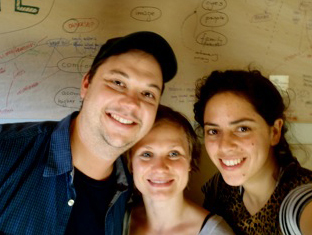
Joshua Tyler, Katarzyna Sitarz, Zoe Scoglio, Home creative team
photo courtesy the artist
Joshua Tyler, Katarzyna Sitarz, Zoe Scoglio, Home creative team
We narrowed down everything and divided our work into three major parts, one being Home as a Body. We had two different things between Zoe and me: me being actually physically a ‘home’ for projection. We were projecting little versions of me dancing and using the surface of my body as a landscape. Then we went in a different direction into Intimacy and Absence of the Body. Again we were working with projections on my body. Zoe would be finding different objects or using her own body, her own hands and presence being projected on me. We went into Navigations—directions, searching for home, partly because we were talking a lot about nomadic cultures. Then we were working with walkie-talkies on an idea of Here, Near and Far but still having one point of reference. One walkie-talkie section involved setting one device in a place where we ‘stored’ people—part of the room. We made an architectural plan of a house just using simple white tape. We made a house and we guided people into a little room or a big room, spaces with very abstract borders because home can contain very abstract ideas and agreements between people. I welcomed people and then I left. I continued the journey outside. Mark preferred to create a really interesting soundscape so we were playing this through the walkie-talkie to create different spaces and different journeys.
We also made a short movie about being in a house but being homeless. We decided a slug is a snail with a housing problem. It was more about that mental and emotional state when you are in a place but you’re not really there. So you’re kind of lost. And then we set the physicality where I would just be constantly shaking and being out of any kind of control.
Is this something you might work on in the future or do you see it simply as something that you’re glad you’ve done?
Oh, I definitely see a future for it. There is so much potential. We did so many really interesting things that I feel that I need to digest it because it was quite an intense process—three weeks of brainstorming and making and finding a common aesthetic language. I would love to carry on with it, especially as it’s a subject that’s very present in my life.
What about your experience with Lucy Guerin?
That was a really interesting process. She was working with three dancers and three actors. And I was an ‘extra’ doing whatever I could share or do. I was really very much part of it while the research was going on, trying out different options and tasks and possibilities. Once Lucy started to shape the work a bit more, I stepped out in order to observe it. I was really glad I could participate in the process from the very beginning. So it’s not that I was joining something already underway. And the other thing was that because of the collaboration Lucy is making with Belvoir and the actors, she wasn’t in her comfort zone, in her field where she’s super under control. I could relate to this just because of my own experience. It was interesting to observe how she was dealing with things, approaching the work, because it was also research; how she’s shaping it, timing it, which kinds of tasks she’s setting. Another beautiful thing is just the way she works with people. Just as I was saying about Rui Horta, Lucy Guerin is such an amazing, beautiful woman who appreciates people and their effort and the qualities they have. It was a pleasure to be with all of them. The group was really great.
And all up it’s been a good experience for you?
It was a great experience. I’m not saying it was the easiest one because I had to find myself here, in the Australian mentality, the Australian approach towards things, finding ways to communicate with people, to have a common understanding which wasn’t always an easy thing just because we could look at one thing from very different perspectives. We would be speaking about something and after a few hours there would be a sudden ‘Okay! this is what you mean!’ It sometimes takes time and energy and leads to some frustrations, but…What I enjoyed a lot was coming here and being a little bit like a blank paper. I don’t know the people; I don’t know who’s who. I’m not engaged in any political whatever or social structures. It was a pleasure to see work, to like it or not, with this kind of approach. For a long time I haven’t had this. I felt like a little bit like this innocent child.
It’s good that Dance Massive was on and there was so much for you to see.
That was really great. What I would like to add is how grateful I am for the opportunity and to all the people I met on my path and who supported the project. Shane Carroll was just an angel looking after everything—even making sure I looked in the right direction crossing the road! I found people very open and very supportive. The Arts House team were great for my collaboration. Whatever I asked, there was never a ‘no.’ Almost everything was possible. There was always trying, always options. I’m not used to working like that. Very often I work in surroundings that would be like “no, this is not possible” or “go and deal with it yourself.” So this is something ‘wow’ for me. Big support and very friendly community and very open people.
For information about the Tanja Liedtke Foundation and Fellowship go to http://www.tanja-liedtke-foundation.org.
RealTime issue #105 Oct-Nov 2011 pg. web
© Keith Gallasch; for permission to reproduce apply to realtime@realtimearts.net
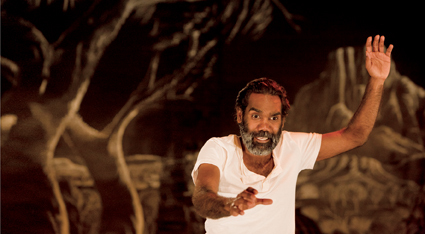
Trevor Jamieson, Namatjira
photo Brett Boardman
Trevor Jamieson, Namatjira
OF ALL THE AXIOMS BY WHICH WE EVALUATE A WORK OF LIVE PERFORMANCE, ITS SUCCESS IN MEETING ITS AUDIENCE SEEMS RELATIVELY IGNORED. I DON’T SIMPLY MEAN THE RELATIONSHIPS BETWEEN A WORK AND THE BODIES AND MINDS OF THOSE WHO WITNESS IT—THERE’S NO LACK OF DISCUSSION AROUND THE FOURTH WALL, IMMERSIVE THEATRE AND THE LIKE. BUT WHEN IT COMES TO THINKING THROUGH WHO IS ATTRACTED TO A PARTICULAR WORK AND WHY, IT WOULD SEEM A MATTER OF MARKETING RATHER THAN AESTHETICS. IT’S FOR THIS REASON THAT TOO MANY THEATRE-MAKERS, WHEN ASKED ABOUT THE ASSUMED AUDIENCE OF THEIR EFFORTS, CAN REPLY ‘EVERYONE’. WHICH TOO OFTEN AMOUNTS TO ‘NO-ONE.’
Four recent productions to grace Melbourne suggested more nuanced and considered answers, playing on audience expectation and knowledge and seeming to understand that a work that will appeal to a universal audience is as unlikely as the existence of a universal human. I’ve never come across an instance of art that hasn’t found its detractors; to acknowledge this is a primary step for artists, and to proceed anyway an act of essential, necessary bravery.
big hart, namatjira
Big hART’s Namatjira takes a bold stance in this regard. The work is an exploration of Australia’s most famous Indigenous painter, Albert Namatjira, whose art was among the first to gain widespread recognition in white Australia from the 1940s onwards. But far more than straightforward biography, Big hART incorporates a mode of direct audience address that denies its viewer the opportunity to experience the work as if through a one-way mirror. From the outset performer Trevor Jamieson speaks to his audience, but not just any audience: Namatjira assumes that its audience is white.
As a work with a heavy touring schedule, I can’t tell how this gambit would travel, but in the inner-city surrounds of the Malthouse it seemed disarmingly appropriate. Jamieson jokes about progressive white Australians who might want to give their children Aboriginal names, and wonders whether a service should be established to advise them on this. He prods at the white nervousness surrounding Indigenous protocols and anxieties about causing offence through sheer ignorance. Most of all, Jamieson subtly circles around the expectations his audience may have towards something we’ve come to call “Indigenous theatre”—what does that mean? Is it a label that liberates or confines? Can it do both?
If it has to be labelled, Namatjira might be thought of as postcolonial Indigenous meta-theatre; it doesn’t merely give voice to the history and experience of Aboriginal Australia but questions how that voice is heard, what conversations it is part of. It’s a rich celebration of a fascinating figure, but also one rife with irony: in recreating the painter’s rise and fall in heroic terms, Jamieson notes that this is “the story whitefellas want to hear… the only story people seem to remember.” Alongside this drama we are given counter-narratives, most obviously incarnated through Jamieson’s co-performer Derik Lynch and the descendants of Albert Namatjira himself who work on a massive chalk mural dominating the back of the stage throughout the piece. They are reminders of the presences which persist beneath any official telling of the past, of the continuities which cannot be captured through biography alone, since a biography must perforce end, while a life’s legacy is more complex.
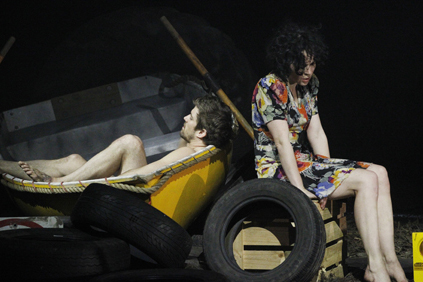
Timothy Ohl, Fiona Cameron, Look Right Through Me, KAGE
photo Jeff Busby
Timothy Ohl, Fiona Cameron, Look Right Through Me, KAGE
kage, look right through me
Another Malthouse production engages with the legacy of an icon who is still very much at work. KAGE’s Look Right Through Me took as inspiration the cartoons and drawings of Michael Leunig, an artist of whom no Melburnian would be unaware. But how to do justice to an oeuvre that carries with it the weight of many decades, and to an iconography that has very specific significances to the legion of fans Leunig has accrued over this time? To attempt an act of translation, in this sense, opens up the possibility of getting it ‘right’ or ‘wrong’ according to what meanings each individual reads into the artist’s work.
It helps that KAGE’s physical theatre methodology is very much based around images, but director Kate Denborough wisely avoids a literal staging of the Leunig with whom we are familiar. Rather, she has pieced together an independent narrative that seems to riff on the artist’s canon like a jazz take on a standard score; the cartoonist’s themes and characters rise and fall like a refrain, but the work itself doesn’t rely on recognition as its fundamental source of meaning-making. Of course, Denborough knows that in this city at least recognition will have its own potency, but this is a work that would make as much sense to an audience unfamiliar with its source.
On its own terms, Look Right Through Me has strengths and weaknesses. Some of its vignettes, which chart the course of an alienated everyman shadowed by his own childhood, are of unarguable impact: a rope swing dangling from a tree takes on the grim aspect of a noose; a patch of grass becomes both comforting bed and unsettling grave. It may be in the relationships between performers that Denborough’s work really shines here, and her choreography is both deftly athletic and emotionally charged, producing a very visceral realisation of the dynamics that connect and divorce humans from one another. At other times, such as an extended sequence of carnivalesque abandon, both the narrative and its emergent themes become more muddied, and it’s at these times that I found myself turning back to the artist and wondering if there was an element of his work that I was missing and which was vital to interpret the on-stage events. These were rare moments, however.
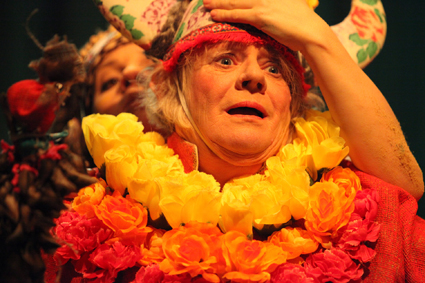
Mary-Helen Sassman, Liz Jones, Special, The Rabble
photo Marge Horwell
Mary-Helen Sassman, Liz Jones, Special, The Rabble
the rabble, special
The Rabble is a company equally interested in the power of image-based theatre, often producing far more disorienting results. In the case of Special, this isn’t a bad thing. For much of the shortish piece I didn’t really know what was going on, but this didn’t hinder enjoyment of it in the least. Mary Helen Sassman plays a belligerent, heavily pregnant woman harassed by her equally self-obsessed mother; they inhabit a strange space of hyperreal colour dominated by a massive mound of sand. Their interactions are fragmented, not quite nonsensical but obscure in nature, and the whole comes across like Beckett directing a children’s party. As their condition of static animosity plays out, however, a series of bizarre rituals is introduced whose intentions are left deliberately open to the audience, but which clearly possess an internal logic to which we are not privy.
With the slightest of changes Special could be wilfully obscurantist, an exercise in self-indulgence and a frustrating severing of signification and referent. But director Emma Valente somehow pulls it off marvellously, keeping her audience onside even while maintaining a constant distance between performer and viewer. She seems to acknowledge that we understand this mode of playmaking and expect more from absurdity than a basic deferral of meaning. Rather, the strangeness of what we see seems as real as any more rational presentation of plot and character; we may not understand the motivations that compel these figures, but how many of our own drives are unquestioned and equally odd, when put in the spotlight?
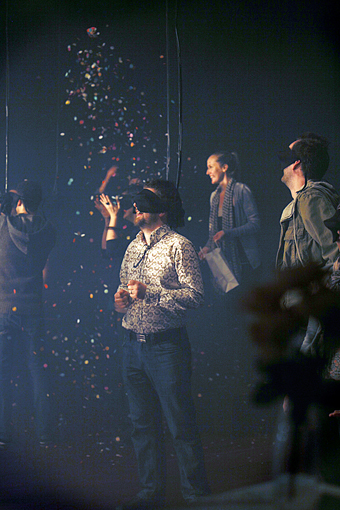
Thrashing Without Looking, Aphids
photo Ponch Hawkes
Thrashing Without Looking, Aphids
aphids, thrashing without looking
And into the spotlight is exactly where Aphids’ Thrashing Without Looking thrusts its audiences. Indeed, whether ‘audience’ is an applicable term here is moot. The work makes its participants both spectator and spectacle, simultaneously, as half the crowd is equipped with ingenious headsets that channel the footage being shot by a range of video cameras moving around the room. The other half direct the course of events, which are established according to the kitsch conventions of karaoke music videos—a romantic dinner for two, a turn at a pumping nightclub, a slow dance that ends in heartbreak. Those given the active roles are watching themselves at a distance while playing out each scene, and it’s a profoundly giddy experience. If the pleasures of classical cinema are of the voyeuristic kind, giving the passive viewer a sense of power over what is depicted on screen, this dynamic is up-ended when the gaze is directed back on itself.
Thrashing Without Looking was a short, sharp shock that managed to provoke questions about the place of the audience in a way quite rare these days. Hopefully it will go on to enjoy an expanded life in some form, as these are questions that deserved to be asked, and in this case at least, were a joy to be part of. (See also Jana Perkovic’s review)
Malthouse Theatre and Big hArt, Namatjira, writer, director Scott Rankin, performers Trevor Jamieson, Robert Hannaford, Derik Lynch, Kevin Namatjira, Lenie Namatjira, Michael Peck, Elton Wirri, Hilary Wirri, Kevin Wirri, designer Genevieve Dugard, composer Genevieve Lacey, costumes Tess Schofield, lighting Nigel Levings, sound design Tim Atkins, Malthouse. August 10-28; Malthouse Theatre and KAGE, Look Right Through Me, concept, direction Kate Denborough, creative collaborator Michael Leunig, co-devisers, performers Craig Bary, Fiona Cameron, Timothy Ohl, Cain Thompson, Gerard Van Dyck, composer Jethro Woodward, designer Julie Renton, lighting Rachael Burke, Malthouse. September 7-18; The Rabble, Special, director, Emma Valente, concept Emma Valente, Mary Helen Sassman, devisor-performers Liz Jones, Mary Helen Sassman, lighting, sound, composition Emma Valente; La Mama Courthouse, August 4-21; Arts House and Aphids, Thrashing Without Looking, creators Martyn Coutts, Elizabeth Dunn, Tristan Meecham, Lara Thoms, Willoh S Weiland, producer Thea Baumann, sound designe Alan Nguyen; Arts House, North Melbourne Town Hall. 3-7 August
RealTime issue #105 Oct-Nov 2011 pg. 29
© John Bailey; for permission to reproduce apply to realtime@realtimearts.net
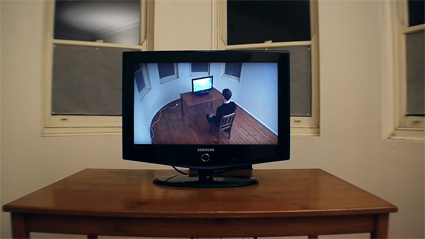
John Tonkin, Metacognition
courtesy the artist
John Tonkin, Metacognition
STEPPING OUT OF THE LIFT INTO THE NEW BREENSPACE GALLERY ON LEVEL THREE OF A CONVERTED WAREHOUSE BUILDING, IMMEDIATELY BRINGS YOU INTO THE PENUMBRA OF THE GALLERY SPACE. RANGED AROUND THE WALLS ARE FRAMED IMAGES LOOKING CONTEMPORARY AND COLLECTABLE, FLICKERING WITH MOVEMENT, RATHER THAN MADE STATIC WITH PAINT. JOHN TONKIN IS A SEASONED MEDIA ARTIST WHO LIKE OTHERS, IS PROBING THE TASTES, DESIRES AND WALLETS OF THE COLLECTORS.
Can ‘progress’ be made in this endeavour, or is interactive moving image work the genuine ephemeral article claimed (but rarely delivered) by earlier movements of art makers?
The four works presented, like Tonkin’s earlier work, break ground in an amusing and convincingly stable way; while interactive multimedia installations can be plagued by inadequate technology or buggy preparation, not so here. He begins by renaming the phenomena “responsive video,” thus avoiding troubled histories and focusing on the predominant contemporary art form, video. Approaching one of the floating frames causes the flickering image to animate, to run forwards or backwards, or to in some way change its appearance, or cut to another shot.
The pieces are developments from Closer: eleven experiments on proximity seen at Performance Space, last year (RT100). Those interactive encounters were more casual than the current show, tucked away in various corners of CarriageWorks; prosaic images of a rolling drink can caught at the top of an escalator, or a boiling kettle, all controlled by our movement into confined stall-like spaces. Emphasis is on the ordinariness of that physical activity and its effect on the perceived image.
This is a novel and profound ability, to influence the quality of motion in the image; it is an extension of Deleuze’s ideas of the time-image and its perception: “A flickering brain, which re-links or creates loops – this is cinema.” No longer is the motion picture confined to analogue and linear sequencing; in the digital domain, as many of us have been pursuing, sequence is determined frame to frame by the participant selecting, knowingly or not, from a database of moving image files. The artist determines the rules and the materials applying to the collection that the participant will explore.
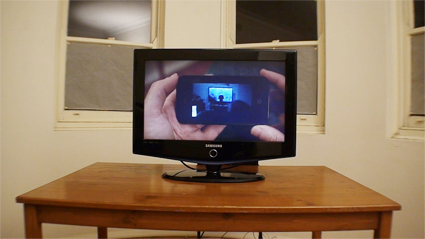
John Tonkin, Metacognition
courtesy the artist
John Tonkin, Metacognition
A biology of cognition, the title of one of the pieces in the exhibition, is key in providing the only shock in the show—approaching the screen causes a large face to suddenly appear from the murk to stonily eyeball the viewer while intoning briefly, mumbled and indistinct, phrases related to the title (referencing the 40-year-old seminal essay by Chilean biologist, Humberto Maturana). Attempts are made by the participant to devise various choreographic strategies and clarify the utterances. Is there a narrative, a sequence meaningful to what is not present here? A conclusion, if there is one, cannot be drawn, other than bringing to mind the considerable research developed since the essay’s appearance. Andy Clark, among others, more recently described the external environment, actively structured by us, as a source of cognition-enhancing ‘wideware’ containing external items such as devices, media, notations etc, that scaffold and complement without replicating biological modes of computation and processing.
Tonkin floats these ideas, leaving meaning beyond the immediate experience of the work in abeyance: avoidance for some, completion for others.
Closing the loop of fractions of time caught in memory cycles—suddenly recalled as thresholds are crossed, as proximity is shortened—is simulated as we approach the image of a window frame in Selective Attention. Focus changes to the plane of the glass and then to the rain falling beyond, then on retreating, returning to the ‘warmth’ of the interior. Subjectivity comes to the fore and the window through which we stare is the mirror of past events. Perhaps these feelings are the reinforcement sought by collectors, who are prepared to forgo the tenuous material basis and investment potential of their artefact?
As an artist who is also a programmer, John Tonkin’s long term engagement with novel interfaces for visual databases goes back beyond the 1990s and currently explores the recent addition of the Kinect sensing device to the tools available. Titles of the works, however, emphasise the theoretical underpinning of the ongoing investigations: Direct realism is like a still image of light refracted through glass and vegetation that begins to twinkle in movement as you draw near. On approaching the image of a seated person gazing at the screen before him in Metacognition, a street scene on the screen expands to be replaced by an image of feet walking in the bush, or a garden. It becomes possible (if the game is played) to enter different spaces within the work, to keep up with the walker; the framing of these adventures becoming the description of cognitive function being applied, from moment to moment.
John Tonkin, A Biology of Cognition, Breenspace, Sydney, July 1-30; www.breenspace.com
RealTime issue #105 Oct-Nov 2011 pg. 28
© Mike Leggett; for permission to reproduce apply to realtime@realtimearts.net
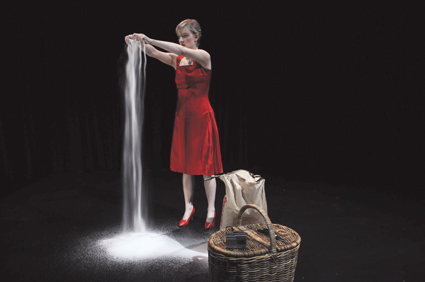
Noni Cowan, Gestures, Theatre & Performance Studies Honours Project Performance, UNSW
photo Heidrun Löhr
Noni Cowan, Gestures, Theatre & Performance Studies Honours Project Performance, UNSW
IN PART 1 OF THIS SURVEY OF AUSTRALIAN CONTENT IN THE CURRICULA AND SYLLABUSES OF COURSES IN AUSTRALIAN THEATRE AND CONTEMPORARY PERFORMANCE IN TERTIARY EDUCATION, IT WAS CLEAR THAT THERE WERE SOME VALUABLE RESOURCES AVAILABLE IN PRINT AND ONLINE FOR TEACHERS AND STUDENTS, BUT ALSO MUCH THAT WAS MISSING.
I concluded that “there was a strongly felt need to be able to understand and teach Australian performance on its own terms but within the framework of national and international perspectives that this country has struggled so long to attain.” Here are further responses to my query to academics about how and where Australian content fits in their courses.
university of melbourne
Peter Eckersall, Associate Professor of Theatre Studies in the School of Culture and Communication, University of Melbourne, wrote to me that his subject, “‘Live Art Beyond Theatre,’ addresses many contemporary Australian artists and practices (and the RealTimeDance portal is a remarkable and helpful teaching resource). Our teaching tends not to be based on ideas of national arts practices, however, and Australian artists are discussed alongside, in comparison to, and in collaboration with developments, events and trends internationally. We also have Master of Arts and PhD students who are working on contemporary Australian performance. Some of these projects are focused on historical practices from the 1960s-1990s. Others are focused on contemporary performance works. A number of these projects have been/are being undertaken with creative components.” Eckersall identifies “a tendency to think about arts practices more regionally, locally and conversely more globally. Australian artists and practices have become so diverse that we often discuss them with a focus on more specific, or more diverse, analysis and critique. I would say that it is not the arts practices that are elided, but the notion of an ‘Australian artist’ and what this means is more complex and sometimes less meaningful.”
Eckersall also believes that “there is a need for more publishing on contemporary performance. There are many more research articles and documents than books …There are some good resources such as Ausstage and RealTime but there is a need for more perspectives and more ways to disseminate findings.”
murdoch university
Helena Grehan, Senior Lecturer in the English and Creative Arts program at Murdoch University in Western Australia, writes that the work of Australian artists is important “as the work reflects (often) issues and themes that are of interest to our students and the work is also often inspiring in terms of identifying what can be done in a constrained environment (fiscally).”
Grehan’s own teaching focus is “primarily on current practitioners (or at least from the last 20 or so years).” As for written resources she “directs students to available books but also RealTime (I use it all the time with my students), Australasian Drama Studies, Performance Paradigm (www.performanceparadigm.net) and About Performance (Department of Performance Studies, University of Sydney), which are all very useful, as are blogs. There could always be more but l’d like to focus on quality rather than quantity. Alison Croggon’s Theatrenotes is, for example, outstanding.
university of sydney
Laura Ginters, lecturer in the Department of Performance Studies at the University of Sydney writes, “Contemporary artists and their practices are central to what we teach and research in Performance Studies at the University of Sydney. While we don’t create work with our students, and nor do we train artists, the Rex Cramphorn Studio is filled, year round, with our artist-in-residence program and the work of these artists feeds directly into our teaching and research. For example, the 3rd Year Honours entry courses, Rehearsal Studies and Rehearsal to Performance, are based around a project where students observe, document and analyse two weeks of a rehearsal or creative development process taking place in the Rex. In 2011 the students observed My Darling Patricia at work on a new piece; last year it was Version 1.0, developing Table of Knowledge.
“In researching the company whose work they will observe, RealTime is often a valuable resource for students. Our Honours students also sometimes undertake their professional placement—they observe and analyse a full-length rehearsal process, then write up a casebook on the experience. This can be with one of the artists or groups of artists working in the Rex—or they will undertake such a placement with a company or artist outside the department: this could be anything from Tess de Quincey Co to Opera Australia. We also offer an Honours level course in Contemporary Performance (which is heavily focused on Australian artists), and this will sometimes include a practical workshop component for the students with a practising artist like Barbara Campbell.”
In second year, students commence performance analysis, seeing live performances and writing about them. Other courses—Embodied Histories, Theories of Acting, the Playwright in the Theatre, Playing Politics, Cross-Cultural Performance and Gender and Performance—”use the work of contemporary practitioners in dance, contemporary performance, performance art, and theatre and other genres. In my own Dramaturgy course in third year my students have had the opportunity to observe a director, actors, writer and dramaturg developing a new work for performance. And while we’re not training practitioners we’ve got a long history of practitioners coming to us for postgrad study—enjoying the chance to reflect on their own practice or a related topic.”
Study in this department is advantaged by having a large archive in print and video of performance documentation. Ginters is appreciative of RealTime, Currency House’s Platform Papers “and (a very few) good bloggers—like Alison Croggon and James Waites for “delivering interesting commentary and reviews of work I can’t see myself and/or won’t see reviewed elsewhere. Our own journal, About Performance, also often includes analyses of the work of contemporary practitioners: recent editions have included essays on ‘refugee theatre,’ the work of Back to Back Theatre, Marrugeku, Pork Chop Productions, Australian Dance Theatre and the Gathering Ground project in Redfern’s The Block, to name just a few.”
Ginters would like more books on contemporary practitioners, “and indeed their forebears: I’m writing a book on drama activities at Sydney University in the late 1950s and early 1960s has made me very aware of how little has been written about the pre-1970 era.” Often, she says, the primary material exists—”the ausstage project is a great example of this; so is the National Library’s Trove search function. Having more of RealTime’s earlier editions also available would be a terrific addition. Personally I’d also be thrilled if I could get access to the Sydney Morning Herald archives online after 1954 without having to visit the State Library in person!”
university of new south wales
Clare Grant, Lecturer in the School of English, Performing Arts and Media at the University of New South Wales, tells me that, “artists of late 20th and early 21st centuries such as The Sydney Front and Jenny Kemp are specifically studied in John McCallum’s survey course, Staging Australia, along with earlier Australian artists. In his Program and Repertoire course, close attention to current performance programming forms part of the curriculum.” The Introduction to Theatre course “refers to several contemporary performance makers such as Deborah Pollard, and from an earlier era, Ken Unsworth.” In Reading Performance and Multi-Media production, artists include Australian drag performance (eg The Kingpins), both live and mediatised, William Yang, Stelarc, Tony Schwensen, Australian dance companies, Mike Parr, version 1.0, Back to Back Theatre, Marrugeku, Guillermo Gomez-Pena’s Museum of Fetishized Identities, as well as local festivals.”
In the practical courses Grant teaches, students also see performance works— including media art, live art, ‘documentary’ performance, site-based work—in Sydney, “many of which involve the students or ex-students themselves…The work of Australian artists is vital to the department of Theatre and Performance Studies, especially as the work of students forms part of the contemporary performance milieu in Sydney. Many of the students work with practising artists through PACT Centre for Emerging Artists and Shopfront Theatre, often undertaken alongside their studies at UNSW.”
For 12 years Grant has produced an annual student devised work for the public. This year, however, she says the process “will shift to a number of smaller group shows created through contemporary performance-making practices. As well, each year a class of up to 35 solo performance makers publicly present their works.”
As for resources recommended to students, there are “extracts from Richard Allen and Karen Pearlman’s Performing the Un-nameable (Currency Press with RealTime, 1999) in various courses; Edward Scheer’s book on Mike Parr (RT102, p47); John McCallum’s Belonging: Australian Playwriting in the 20th Century (Currency Press, 2009); plus Marrugeku’s Burning Daylight in DVD and booklet form. But we always need more; any new documentation is taken up quickly and used; Australian work with the physical and the documentary could use more attention. Streaming options, which Artfilms is working to develop soon, are valuable and probably more economical. Many of us teach the works we happen to have on DVD courtesy of the performance makers themselves.”
The evidence in Parts 1 and 2 of this brief survey provides clear evidence of commitment of teachers to Australian performance content in their courses, not only turning to print and online resources but, in various ways, putting students in touch with artists in residence, encouraging them to see productions, teaching analysis, developing dramaturgical awareness, making works and placing Australian work in the larger contexts of overseas works and the issues of the day. Most teachers would welcome books on contemporary artists (as more commonly happens in the visual arts) as well as stronger, more available video documentation. The emergence of contemporary performance from the 1960s to 80s warrants particular attention.
artfilms
A very special resource is the Melbourne based artfilms (www.artfilms.com.au/) with its growing collection of Australian performance works and documentaries on DVD. Artists and companies include Jenny Kemp, Stelarc, 5 Angry Men, Trevor Jamieson (Nothing Rhymes with Ngapartji, a documentary about Big hArt’s Ngapartji Ngapartji), Melbourne Women’s Circus and others alongside their international peers. In the dance realm, Artfilms has works available from Chunky Move, Lucy Guerin Inc, Chrissie Parrott, Igneous, Bangarra Dance Theatre and Meryl Tankard. The company’s latest project, director Kriszta Doczy tells me, is its Australian Avant-Garde series featuring Nigel Kellaway, Mike Mullins, Ken Unsworth and the experimental films of Gary Shead with work currently progressing on a DVD about the Sydney Front. Artfilm’s director Doczy eagerly encourages Australian artists to make documentation of their performances available to universities, schools and individuals. You can read more about Artfilms in the December-January edition of RealTime.
Another valuable resource is the National Library Oral History Collection’s interviews with leading theatre professionals Peter Oysten, Richard Cottrell, Richard Murphet, Nicholas Lathouris, Alan Seymour and others conducted by James Waites. Waites has been conducting these “whole life” interviews with a variety of people in and outside of the theatre business (http://www.jameswaites.com/) since 1996.
Theatre/Performance education part 1 appeared in RT 104 – see article.
RealTime issue #105 Oct-Nov 2011 pg. 30
© Keith Gallasch; for permission to reproduce apply to realtime@realtimearts.net
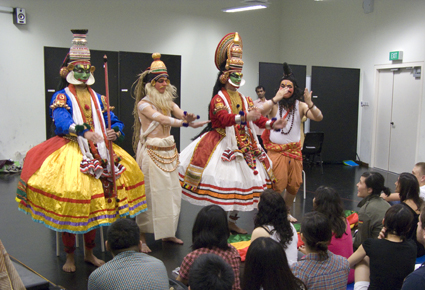
LASALLE acting students learn Kathakali performance skills
photo Crispian Chan
LASALLE acting students learn Kathakali performance skills
PROFESSOR PETER BOOTH, SENIOR DEPUTY VICE-CHANCELLOR AT THE UNIVERSITY OF TECHNOLOGY SYDNEY WAS RECENTLY REPORTED ON THE FRONT PAGE OF THE SYDNEY MORNING HERALD AS SAYING OF AUSTRALIAN ‘STAY-AT-HOME’ STUDENTS: “WE AS A UNIVERSITY THINK IT’S QUITE SAD AND WE’VE MADE A LOT OF EFFORT. IT WOULD BE BETTER FOR AUSTRALIA TO HAVE MORE POSITIVE PROGRAMS TO ENCOURAGE STUDENTS TO DO SOME OF THEIR STUDY OVERSEAS” (SMH, SEPT 14).
If you have ambitions in the performing arts and a strong interest in intercultural performance Singapore’s LASALLE College of the Arts might be the place for you with its embrace of Asian and Western traditions, excellent facilities and teacher-student ratios, as well as a related media arts faculty and film school.
For many years Australian universities have relied financially on a steady flow of overseas students, mostly from Asia. Although, after USA and Britain, Australia has the third largest take-up of foreign students globally, some 22% of the Australian university population, numbers have dropped by 9.4% in 2010-11. This is for a variety of reasons: fears of racist violence, the high Australian dollar, foreign student management scams outside of the university sector and, given new visa restrictions, decreasing opportunities for students to stay on in Australia after graduating (the Australian Government has recently relaxed somewhat the visa and post-study work restrictions to help universities sustain numbers and income). Another reason is the growing attractiveness of universities and other tertiary education institutions within Asia itself, particularly as the region plays a growing role in the world’s economy and develops its tertiary education sector.
Focusing on fine art, design, media and performing arts in a culturally rich island state LASALLE is located in Singapore’s cultural centre. Equipped with one theatre and two black box spaces, its Faculty of Performing Arts was spearheaded by Aubrey Mellor, a leading Australian theatre director, formerly Director of NIDA. Mellor was the Dean of the Performing Arts 2008-2011 and is now a Senior Fellow at LASALLE. The faculty has long had connections with Australia through a number of teachers working there over many years, for example composer Lindsay Vickery (now returned to Perth), virtuoso saxophonist Timothy O’Dwyer, NIDA alumnae Edith Podesta and a former concert soloist with the West Australian Symphony Orchestra, Bronwyn Gibson.
What LASALLE offers students is a rich cross-cultural, practice-based curriculum in the performing arts with a very attractive and highly competitive (not least for Australian universities) ratio of one teacher per seven students.
Venka Purushothaman, LASALLE’s Vice-President (Academic) and Provost, and Acting Dean of the Faculty of Performing Arts, says, “Singapore is at the ebb and flow between the west and east. LASALLE is therefore able to capitalise on the rich and diverse groups of visiting artists from North America, Europe and the Asia-Pacific. Through its link to UK film producer David Puttnam supporting the development of young filmmakers in Asia, The Puttnam School of Film, part of LASALLE’s Faculty of Media Arts, has also been instrumental in growing the creative talent base for the film and video industry.”
Wolfgang Muench, Dean of the Faculty of Media Arts, writes, “The philosophy within LASALLE is to encourage students to collaborate on interdisciplinary projects in order to learn new skills and sensibilities that will stand them in good stead when they enter the real world. Many of the Media Arts students have collaborated with dance and acting students on performances that showcase the diversity of the range of talents that are developed here.”
Aubrey Mellor likewise emphasises a diversity of experience and interaction: “In the Diploma in Dance, contextual studies support the understanding of distinct stylistic features, but dance practice and dance skills take precedence. The aim is a versatile and flexible dancer, equally at ease with any choreographic demand from popular, ethnic and period dance. Essentials of classical ballet, contemporary dance and physical theatre are used but are not specialisations.” As for music training the focus is on “knowledge of style, rhythm and cultural sources and the inclusion of cross-disciplinary subjects such as Performance Art, Film and Video Collaboration and Southeast Asian Cinema that accord students with the scope to exercise versatility and to think and practise across artforms and cultures.”
Timothy O’Dwyer, who heads the School of Contemporary Music within LASALLE’s Faculty of Performing Arts, elaborates: “In the popular music oriented Diploma in Music, students rehearse in small groups and perform every week. They learn how to improvise, have lessons on their instruments, learn music theory, compose their own songs and learn about the history of music from some of the most experienced performers and educators in the region. The BA(Hons) Music covers classical, jazz and popular music as well as composition and music technology. Taught within a western musical discourse, the programs introduce a diverse blend of ideas found in Asia, Europe, Africa and the Americas—and schools students in a range of contemporary musical practices, in both practical and theoretical contexts.”
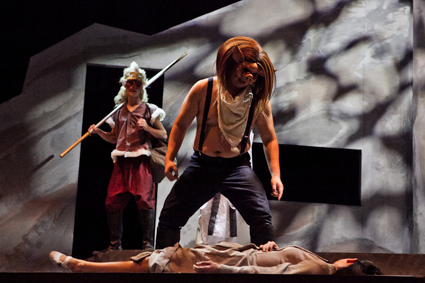
LASALLE students perform Journey To Nowhere
photo Crispian Chan
LASALLE students perform Journey To Nowhere
For students undertaking the Diploma in Performance, the first year course in acting, improvisation, voice, movement and script analysis is framed within the history of the performing arts and visual culture. The second year focuses on musical theatre, with the experiential work underpinned by lectures and seminars in Southeast Asian performance traditions as well as dramatic writing and dramaturgy. The third year involves acting work in LASALLE’s Screen Acting Unit and studies in Southeast Asian Cinema.
For the BA(Hons) Acting, through classes, projects, workshops and productions, the course develops students’ abilities to work in an ensemble environment and with awareness of their own imaginative resources. The program collaborates with other faculties, specifically The Puttnam School of Film in the Media Arts faculty and offers rich training within a wide cultural and historical context. For students from non-Asian cultures an attractive feature in Level 1 is the Asian Theatre Project plus intensive stylistic workshops, from Commedia to Kabuki. In the final year, Level 3 operates as a theatre company, with ensemble members experiencing a range of roles, styles, genres and disciplines.
Recent First Class BA(Hons) Acting graduate Walter Hanna, who hails from Perth, feels privileged to have been given the opportunity to experience different forms of Asian theatre practices during his studies at LASALLE. Hanna says, “From the very beginning, we were trained by very experienced practitioners who are skilled in Kathakali, Chinese opera, and Indian martial arts. The Asian Theatre Project in our first year of acting school gave us a wide spectrum of learning opportunities and allowed us to be schooled in traditional Asian artforms. This is something that I would not have had the chance to experience if I had studied in Australia.” Hanna participated in a LASALLE production, Journey To Nowhere, in 2010—a tongue-in-cheek take on the famous Chinese epic Journey To The West. “Before doing this show, I had absolutely no idea about Chinese myths and cultural beliefs,” says Hanna.
The distinctive BA(Hons) Theatre+Performance degree with its orientation on leadership is intended for theatre devotees who do not wish to work onstage or backstage. Aubrey Mellor writes, “Graduates are equipped to initiate theatre-making or writing and find employment collaborating with creative leaders locally, regionally or internationally. It engages with traditional and contemporary theory and current and traditional methods of both the East and West are valued. Emphasis is placed on developing the leadership skills for those students wishing to become directors, playwrights, dramaturgs, critics or drama teachers. Level 3 includes advanced studies in inter-cultural theatre practice, developing a specialisation and a major personal production and thesis.” The BA(Hons) Musical Theatre is the first of its kind in Asia designed to prepare students for professional careers in musicals, plays, cabaret, film and television. Numerous graduates from both Musical Theatre and Acting programs have found employment around the world.
There are also Diplomas in Technical and Production Management and in Audio Production as well as a BA(Hons) Technical Theatre, where stage management is central and students can specialise in scenography, lighting, sound and production management. These programs deliver to the huge number of fully produced plays and musicals as well as dance and music shows. Graduates are in high demand from the rapidly growing performing arts, both nationally and regionally, with another 39 new performing spaces brought on line in Singapore.
There is emphasis throughout on a solid grounding in performance administration and financial management as well as professional theatre internships and periodical performance projects. In all diploma and degree courses, leading directors, conductors and choreographers from the region and beyond are involved in the creation of productions.
Bronwyn Gibson, Program Leader for Musical Theatre, says, “LASALLE offers a unique opportunity for Australian students to receive internationally-recognised tertiary education while developing the self-sufficiency and personal growth that comes with living in a foreign country. Student life is enriched by the constant cross-cultural dialogue and learning opportunities derived from peers of diverse backgrounds. Singapore is an inherently multi-racial country and offers an excellent introduction to the dynamic potential that Asia has to offer on a global scale whilst positioned in close geographical proximity to Australia. LASALLE offers the Australian student the best of both worlds.”
According to a recent OECD report, Education at a Glance, there are “24 international students in Australia for every one national studying overseas. The ratios for both the US and Britain are 1-11” (SMH, Sept 14). Certainly, given the impact of traditional Asian dance and theatre traditions on Australian performing arts, you’d think more young Australians would take up opportunities that combine both their own Western and increasingly familiar and pertinent Asian traditions and innovations in performance.
LASALLE College of the Arts, Faculties of Performing Arts & Media Arts, www.lasalle.edu.sg
RealTime issue #105 Oct-Nov 2011 pg. 31
© Keith Gallasch; for permission to reproduce apply to realtime@realtimearts.net
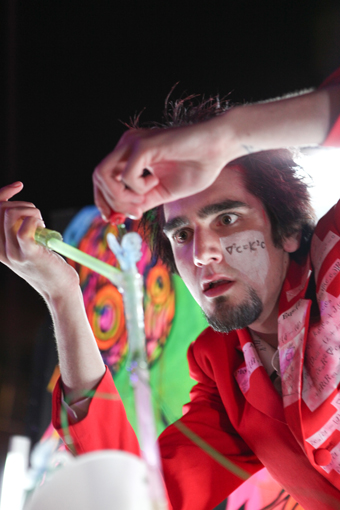
Tom Christophersen, Machine Atlas
photo Yaan Audic
Tom Christophersen, Machine Atlas
THE TITLE OF SHOPFRONT’S LATEST PRODUCTION, MACHINE ATLAS, SUGGESTS SEVERAL POSSIBILITIES. FIRST, IT CONJURES AN ATLAS OF TECHNOLOGY, AN IMPOSSIBLE COMPENDIUM OF ALL THE MACHINES EVER MADE. SECOND, IT MAKES ME THINK OF AN ATLAS FOR A MACHINE—A VAST MAP OF ITS MYSTERIOUS INTERIOR—AS AN ALTERNATIVE TO THE BORING MANUALTHAT USUALLY ACCOMPANIES A PURCHASE. THEN OF COURSE, I WONDER WHETHER THE ATLAS ITSELF COULD NOW BE PUBLISHED AS A MACHINE. UNTIL I REALISE THAT IT ALREADY HAS BEEN, IN THE FORM OF GPS DEVICES. MACHINE ATLAS SETS MY IMAGINATION FIRING BEFORE I EVEN LEAVE THE HOUSE.
The evening begins on a Kogarah footpath in Sydney’s south in front of six screens roughly two metres high. Through a combination of projection and backlighting, a series of silhouettes emerges. The shapes suggest that machine-human hybrids are hiding on the other side: there are some recognisably human profiles and limbs, but also some suspiciously odd-looking additions and protrusions. This is followed by a magnificent monologue from one of the young performers about the long and complex history of humans and their machines.
The screens are moved to the side and we are invited to enter a mall where a “mysterious night market of mechanisms” awaits us. To the left, a man is distilling a “truth serum”—a complicated process that involves a member of the audience, several cups full of coloured fluids (red for love, green for envy, yellow for innocence) as well as some shredded paper and a sieve. Eventually a tiny vial of truth serum emerges to much applause. Further along we enter the Reanimator, constructed from black sheets and glow-in-the-dark stickers and with the casual and wayward look of a living-room fort. Winding our way through we soon meet a young man, who asks us who we would like to reanimate. We’re feeling scientific so we say Francis Bacon. He types the name onto an old typewriter and produces an old computer mouse, which he claims belonged to Bacon.
When we exit the Reanimator, we come across the Machinist Photobooth (really a small stage with a performer operating a digital camera). This is a great hit with the younger audience members: resplendent against a backdrop of rainbow stripes and fairy lights, they are photographed for posterity. Next to the photo booth there is a large screen with black and white animations made by and about school students. Nearby you can interact with Robosoft Windows, which places an individual performer in a clear box and the audience in control. When the spectator selects a tool such as the pencil, eraser or roller the performer enacts each of those actions.
While I can’t bring myself to interact with Robosoft Windows (too close to home for someone who spends her days on a word processor), I can’t resist entering the Biomechanics Booth. Here I am asked my age, birth gender, current gender, how long it takes me to power up in the morning and down in the evening, and when I had my last upgrade and service. The performer, looking a little like a manga cartoon figure with her blue wig, then asks me to close my eyes while she inserts a new chip into my wrist (bandaged on) before sending me on my way.
Every so often this mechanical carnival is interrupted by a siren or whistle, signalling another more theatrical interlude. Early on we are invited onto the street to see a boy dancing in and on a car. Later we stop to watch the human-machine hybrids perform a weird waltz in the middle of the crowd, while we step awkwardly out of the way. If it reads like chaos, it sometimes is—but it’s also exciting and there is a constant sense of anticipation.
As with technology itself—will it liberate or enslave us?—the dramaturgy of Machine Atlas is not always clear. It opens strongly but then seems to grind to a halt as we stand about waiting to access individual installations. Other times it lurches into action and we have to move fast in order not to miss it. One of my viewing companions comments that he’d like to see a human emerge at the end and put all the machines away, perhaps evidence of the almost irresistible desire to reassert human agency. But maybe this ambiguity is okay and more importantly, maybe it is a more accurate reflection of our relationship with machines. This prompts one last thought about the work’s title—what if we are not mapping but rather being mapped by our machines? What on earth would an atlas of humanity look like and where, for that matter, would actors fit in?
Shopfront Contemporary Arts & Performance, Machine Atlas, director Caitlin Newton-Broad, outreach director Sarah Emery, performed by members of Ensemble 2011, movement, Victoria Hunt, sound Michael Moebus (Meem), lighting Stephen Hawker, video Sasha Cohen, design Robin Whitmore, costume design Katja Handt; Kogarah, Sydney, Aug 26-28
RealTime issue #105 Oct-Nov 2011 pg. 32
© Caroline Wake; for permission to reproduce apply to realtime@realtimearts.net
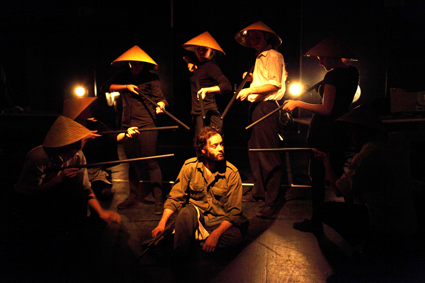
I Feel Awful, Black Lung and Whaling Firm a
photo Ponch Hawkes
I Feel Awful, Black Lung and Whaling Firm a
THE SETTING IS THE PRODUCTION OFFICE OF THE BLACK LUNG THEATRE AND WHALING FIRM COMPLETE WITH POT PLANTS. THE COMPANY NAME ALREADY CONNOTED A CORPORATE SPOOF IN CONGENIAL TERRY GILLIAM STYLE.
But what to make of a show where a portrait of Zionist military icon David Ben-Gurion crashes to the ground, Theodor Adorno’s famous statement that after Auschwitz there will be no more poetry (no more comedy?) is enunciated by the character Aaron who opportunistically proclaims his Jewish heritage in the context of appropriating someone else’s script—“It’s all about me”—followed by the outrageous remark that the office was run like a concentration camp, only with more (or was it less?) discipline. What to make of this confusion of signs (and the obvious lacuna of Palestine)? I didn’t take it, as some others did, as a comment on anti-Semitism. Semitic/anti-Semitic? Stop/Go?
Part surreal review or a series of brilliantly crafted, satirical skits on film, television and theatre in the Swiftian sense of being often grotesque and graphically disturbing (Thomas Wright covered in blood as the aftermath to a ritual bacchanal of hysterical male rage), it was also reminiscent of pre-digital pastimes in more innocent, stoned days, where by switching channels on the TV set we sampled our own reconstructions of the public narrative.
On a naturalistic, ‘real life,’ level of presentation, it was like a more offensive version of The Office which belongs to the vein of 21st century comedy that gets much of its mileage from making the audience cringe. In this case, the all-male, apparently misogynist ensemble of The Black Lung exploit and sexually harass the tribe of young Brisbane performers (beautifully integrated into the mature ensemble) whom they are supposed to be mentoring as work experience students. The degree of subtly portrayed power plays and the complete ignorance of having crossed boundaries on the part of the perpetrators was appropriately squirmacious. But these young people were wised up. There was the facsimile of a palace revolution, but I was moved by the young woman who declared, “I don’t know what to do now” (an echo of the Russian revolutionary Lenin’s pamphlet “What is to be Done?”).
A narrative conceit of the demise of Michael Gow, the former artistic director who commissioned the work I Feel Awful for the Queensland Theatre Company, seemed part affectionate tribute, part celebratory slaying of the father. His memorial portrait also suffers a similar fate to that of fallen idol Ben-Gurion as theatre flats crash to the ground signalling the ultimate collapse of the societal (and theatrical) structures we are all implicated in preserving. The fractured lesbian fairytales provided by comical (mis)readings from Gow’s works caused some ire, but again I read it as this company’s anarchic concern to explode implicit binarisms wherever they exist in the minds of the audience.
There seems to be a salutary awareness on the part of this company that they are fatally involved in an industry of distraction. They appeared to be resisting the homogenisation that implies a classless, genderless world that is the result of media technologies that dematerialise, de-individualise, de-centre the subject and to have re-invoked the notion that, as the French Situationist Guy Debord put it in the Society of the Spectacle, “everything that was directly lived has moved away into a representation.” But as a theatre of revolt to wake us from liberal dreams, it seemed compromised by its own situation as part of the Brisbane Festival.
Black Lung Theatre and Whaling Firm and Queensland Theatre Company: I Feel Awful, writer, director, designer Thomas M Wright, performers Liam Barton, Gareth Davies, Aaron Orzech, Vaczadenjo Wharton-Thomas, Thomas M Wright, Courtney Ammenhauser, Finn Gilfedder, Will Horan, Tiarnee Kim, Mary Neary, Essie O’Shaughnessy, Charlie Schache, Nathan Sibthorpe, Stephanie Tandy, design consultant Simone Romaniuk, lighting Govin Ruben; QTC Billie Brown Studio, Brisbane, Aug 22–Sept 10
RealTime issue #105 Oct-Nov 2011 pg. 32
© Douglas Leonard; for permission to reproduce apply to realtime@realtimearts.net
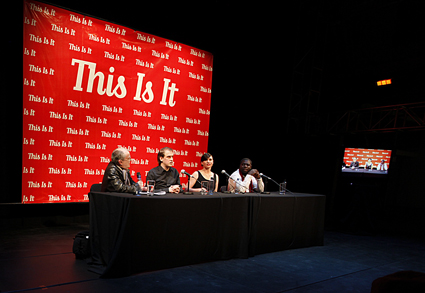
This Is It, Team MESS
photo Ponch Hawkes
This Is It, Team MESS
THE STAGE IS SIMPLY BUT STYLISHLY SET FOR A PRESS CONFERENCE. BEHIND THE LONG BLACK TABLE WITH DESK MICROPHONES AND GLASSES OF WATER IS A RED AND WHITE WALL POSTER WITH A BOTOX-INJECTED FONT REPEATING LOUDLY “THIS IS IT.”
Entering the PICA performance space, the audience have been given a press kit for a fictitious film of the same name as the show, but not much time to read it. When the lights go down we are shown five short cinematic trailers, each one laden with suspense, desire and danger: a woman’s fingernails plunge into eroticised back flesh; a man discovers a buried suitcase while walking in a grim Australian forest; and a cloaked, menacing figure is silhouetted by tongues of fire.
Shot in distinctive art house style but also with unashamed cliché, these suggestive glimpses prepare us for the press conference to follow, the format on which the rest of the performance is based.
The charismatic media presenter for the PICA performance season is special guest Mark Naglazas, a journalist from the West Australian newspaper, acting for all the world as if the audience are also members of the press who will soon be in possession of the roving microphone. Promoted thus to industry colleagues, we all applaud when Naglazas introduces the faux celebrities onto the stage. As they gesture regally to the paparazzi, we take in the elegant Natalie Kate Randall, who plays Caroline the smouldering vamp and victim; a slightly goofy Malcom Whittaker, the naive hero Jim, Caroline’s devoted lover; and Frank Mainoo, an Olympic silver-medalist boxer turned actor who is the villainous kidnapper in the film. Just as the five trailers were an excessive introduction the actors also deliberately take their time waving, smiling and loving their audience loving them. When Naglazas kicks off the questions we hear vague and seemingly articulate accounts of working with a risky, mad director (Dara Gill, also the director of the performance), coping with the demands of largely improvised shoots (writer credits actually go to Simi Knezivic) and dealing with the on and off-stage sexual tension between cast members. The performers have a strong and relaxed rapport, even if their stage presence is not always amped or magnetic.
The show intensifies when a complicit audience starts to fire the questions, introducing themselves as official representatives from real or fake radio stations, newspapers or magazines. It is an intimate crowd, and some are known local performers (not plants) who take on the mantle of the press club expert with relish and comic sensibility. This foray into multiple authorship and improvisation adds a frisson and live-ness to what has now become a choose-your-own-adventure story. Open to any twist or turn that questions and answers may take, the film’s narrative and its behind-the-scenes antics build in horror, humour and sordidness. On this particular evening, the implied gratuitous violence and sexual antics involving Caroline are especially disturbing, mirroring the same morbid fascination that television has for dead or compromised women. We cannot know if the same stories emerge in other performances or if this trajectory is as provisional as everything else in This Is It.
This is a cheeky show that delights in playing with art and artifice. Rather than competing with the film genre, it confidently exploits that genre’s codes and celebrity culture to make participatory theatre. Renewing itself and its possibilities with every run, audiences are invited to speculate, enter into dialogue with and, potentially, reflect on what puts the pop in our popular entertainment. In Baudrillard’s terms, this is a work that perpetuates “the simulation of something which never really existed,” giving the title its sharp irony.
For some, this performance will have interrogated the vacuousness of our increasingly marketing-driven and fame-obsessed existence, and our mythologising of artists. For others, it will have been as unmemorable as the gossip and scandal in yesterday’s trash magazine. Those who loved the fun, confusion and masquerading of it all may even have hung around after the show to collect signatures on the dedicated autograph page at the back of the film’s deluxe brochure. With its foundation of illusion and spectacle, This Is It can flicker in and out of all these readings and more.
This performance is the work of Team MESS, an energetic and interdisciplinary collective of emerging artists (mostly graduates from Wollongong University) who are worth keeping an eye on. Enabled by the development and presentation programs of PICA and Performance Space, they have spun a playful ruse entangling truth and fiction with art and identity.
This Is It, created and performed by Team MESS, Dara Gill, Sime Knezevic, Frank Mainoo, Natalie Randall, Malcolm Whittaker; PICA, Perth, July 13-16
See also Jana Perkovic’s review of Team MESS at Artshouse.
RealTime issue #105 Oct-Nov 2011 pg. 33
© Julie Robson; for permission to reproduce apply to realtime@realtimearts.net
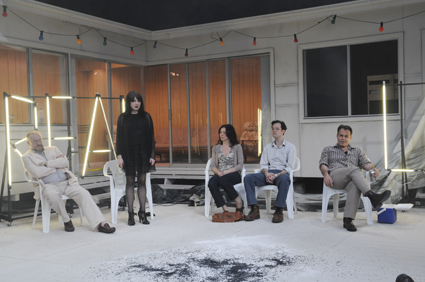
The Seagull, Belvoir
photo Heidrun Löhr
The Seagull, Belvoir
PERHAPS IT’S THE MOOD I’M IN BUT THE PRODUCTIONS I’VE SEEN OVER THE LAST FEW MONTHS, ALTHOUGH HAVING THEIR SHARE OF EVERYDAY UNHAPPINESS, ALSO SUGGESTED VARYING DEGREES OF MELANCHOLY—A CONDITION THESE DAYS REGARDED AS SOMEWHERE BETWEEN SADNESS AND DEPRESSION AND CAPABLE OF DEEPENING INTO THE LATTER. COINCIDENTALLY, IN THE FINAL PARAGRAPH OF HER REVIEW OF THE 2011 EUROKAZ FESTIVAL, JANA PERKOVIC IS CRITICAL OF WHAT SHE SEES AS A CURRENT WESTERN PROCLIVITY FOR MELANCHOLY PERFORMANCE ALONGSIDE APOCALYPTIC CONCERNS.
belvoir: the seagull
The plays of Anton Chekhov are melancholy writ large: sad, wise reflections on constrained lives, dreams unrealised, love lost and empathy thwarted by deeply engrained defense mechanisms. Benedict Andrews’ version (from a literal translation by Karen Vickery) of Anton Chekhov’s The Seagull gently transposes the play’s setting from a late 19th century Russian country estate to a fibro holiday shack on an Australian rural property in our own 21st century. Somewhat pared back and brush-stroked with touches of Australian English and a smattering of contemporary references, production and text are faithful to the spirit and much of the significant detail of the original play. For an Andrews’ production this is an unusually but aptly relaxed affair, taking the requisite time to establish mood, the informal comings and goings, incidental encounters and the emotional flash points so common to family holidays.
Designer Ralph Myers’ L-shaped cream painted shack is an immaculately neat imitation of the real thing, with an open space before it where much of the play unfolds. Although appropriately furnished inside, the house outside is not aged—not touched up with rust or rot or fringed with weeds or shaded by trees. The playing space is equally stark. But as part abstract and calculatedly liminal as this design is, Damien Cooper’s lighting makes the most of its blankness to glare or haze in intense summer light and glow warmly at night. The outdoorness is emphatic. Of course, it’s where Konstantin’s experimental play is staged—with Nina reciting from inside a glass box (perhaps Andrews is mildly parodying his own productions of Eldorado and Who’s Afraid of Virginia Woolf? or Belvoir’s The Wild Duck). The box, framed by the words REAL LIFE spelled out in neon, subsequently becomes a handy metaphorical device, but as an instance of 21st century avant-gardism the transposition from the 19th isn’t easily made.
In this space a strong cast realises The Seagull with an easy sense of ensemble. Judy Davis as the ageing actress Irina is elegantly volatile (no wonder she takes exception to her son Konstantin’s play; not only is it “pseudo avant-garde”, it embraces mortality) and wickedly comic at moments; David Wenham’s deadpan Trigorin is scarily manipulative; Bille Brown’s cheerily mellow Dorn, the doctor, has sympathy for Konstantin but not enough insight to save him; John Gaden’s frail Sorin, the owner of the property, is a self-contained comedy of regret and Emily Barclay’s Masha is a blunt, joint-smoking Goth. As Konstantin, Dylan Young faces the play’s largest challenge, one he almost meets—to convey sufficient emotion and complexity in the course of the play to warrant our belief in his suicidal destiny, not least when it’s Nina who gets, as it were, the last word centrestage, desperately struggling to express her fate: “One day, a man comes along, sees her, and having nothing better to do, destroys her. An idea. For a story. No, that’s not it. What was I saying?” Maeve Dermody vibrates with Nina’s continuing passion for Trigorin but knows she must leave, regretting lost innocence, reciting the very words she had spoken in Konstantin’s play, about a world dying, and then rushing away. The last vestige of Konstantin’s fantasy of a life with Nina evaporates, his belief in himself as a writer already shattered. The melancholic aura of incomplete lives (even the successful Trigorin describes writing as obsessive-compulsive), of life-sustaining delusions and semi-conscious cruelties is ruptured by suicide—a step too far, into either pathos or tragedy.
version 1.0: the table of knowledge
You wouldn’t expect anything melancholic of version 1.0’s The Table of Knowledge. It’s a scathing, straight from the horse’s mouth account of astonishing corruption within the Wollongong City Council and the local business community (for details see the interview with David Williams). It’s riotously funny in its judicious selection of verbatim material, in its deployment of a mock injunction to shut down the show and having blocks of the audience play out the dodgy council property development approval process. But as the second act progresses the mood shifts into darker emotional territory when the woman at the centre of the scandal, Beth Morgan, realises at the inquiry that she has been betrayed by her partner in crime—this at the very time she has found the whole sexual and financial adventure beyond her capacity to manage. Her isolation is profound. But as with the whole production, conventional acting is not version 1.0’s tool. Here Kim Vercoe as Morgan brings just enough emotional intensity to the role to suggest not tragedy but a degree of pathos, drawing from us empathy for someone caught in their own machinations. Equally, version 1.0 are careful not to make the sexual favours, so focused on by the mass media, the centre of their investigation.
Characterisation is otherwise broadly brush-stroked, largely played straight to the audience and with the performers adopting multiple roles against screens that constantly, even relentlessly reveal the unfolding visions of developers’ dreams—architectural fantasies of an anonymous high rise regional city. Late in the second act as the scheming collapses, the waves that break on Wollongong’s shores turn suggestively pink as if bloody. The Table of Knowledge is richly inventive, a feast of appalling information, revelations about criminal cunning and stupidity in equal parts (two men pretending to be ICAC investigators blackmailed the “table of knowledge” conspirators). If it wasn’t so funny it would be depressing, but by the time we watched on as Beth Morgan and her former lover Frank Vellar stood alone and apart and one time Council General Manager Rod Oxley lectured us about the impediments of regulation to innovation, we knew we would leave the theatre feeling more sad than angry—a degree more helpless, a little more worldly.
Version 1.0 made great comic play on the uniqueness of this story of corruption to Wollongong while presenting a litany of the many other councils that have likewise fallen across the country. This is a production that should be seen widely as councils play an increasing role in our lives—from fleecing us to building our arts centres. The fact that Wollongong’s citizens turned out in droves to see The Table of Knowledge, extending the season, speaks both of the work’s relevance and the power of an idiosyncratic theatricality, largely new to this audience, that they wholeheartedly embraced.
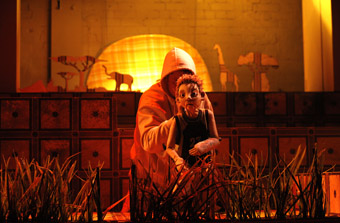
Africa, My Darling Patricia
photo Jeff Busby
Africa, My Darling Patricia
stc next stage: africa
In My Darling Patricia’s Africa, three children—two sisters and a neglected boy from the neighbourhood—immerse themselves in an African fantasy world, identifying themselves with particular animals and even setting out for the airport to make the journey to a land “where chips grow on trees” and “animals talk.” As in the events in Germany that inspired this work, the children are returned to their home by the authorities. But My Darling Patricia takes the story further, into the dark territory of parental neglect and sexual abuse.
The power of Africa comes from its vivid and detailed realisation of the children’s fantasy world, made especially potent by its use, principally, of puppetry in the Bunraku tradition, intricately generating expression (including the mouthing of words) and movement—not least with characterful ways of walking and dancing.
The children’s room is a cleverly designed tiered set with spaces between each level for the puppeteers to move freely. The topmost level reveals only the legs of adults (actors, not puppets) in their world apart, dancing, drinking, fighting—it’s comic at first, threatening later. Eventually the adults enter the children’s room: a devious male bearing gifts and a less than fully caring mother who transforms into a snarling lion when the man transgresses. In the end, the mother must move her family, leaving the boy behind. For a moment it appears that he will be able to sustain the children’s Africa on his own—long leaves of grass sprout from the floor, but then sink and disappear, the collective fantasy lost. It’s a deeply sad final moment in a now otherwise bare room—the sheer volume and density of toys and enacted fantasies gone forever. The puppeteering, design, music (making fine use of toy piano and accordion), props and projections are seamlessly integrated in a production that is endlessly inventive and emotionally demanding, if often very funny. The ending resonates with a line uttered by one of the children after the police have brought them home: “People like us don’t go to Africa.”
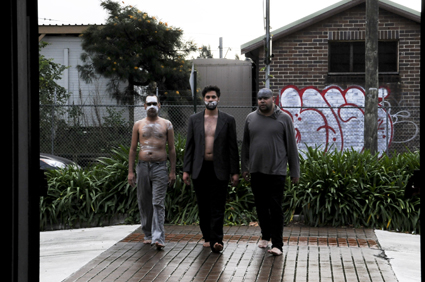
Sonny Dallas Law, Bjorn Stewart, Colin Kinchella, Bully Beef Stew, PACT
photo Heidrun Löhr
Sonny Dallas Law, Bjorn Stewart, Colin Kinchella, Bully Beef Stew, PACT
pact: bully beef stew
At the commencement of Bully Beef Stew, a performance commissioned by PACT Centre for Emerging Artists, the three Indigenous male performers announce that this will “not be a variety show” while everything they do suggests it well might be. It’s certainly funny. However as it progresses, Bully Beef Stew becomes an engaging and moving meditation on reconciliation—between fathers, who have passed away, and sons. Director Andrea James and performers Sonny Dallas Law, Colin Kinchela and Bjorn Stewart embrace a variety of simple means from solo testaments and song and dance to the inventive deployment of a toy train set (the adult becomes child again on a tiny chair), packing tape, a boxing glove, sound design (a speeding car roars like a jet engine) and projections. What emerges from this playfulness is melancholic: these young men miss their fathers, wondering what they’ve inherited from them, what might need to be forgiven, and what it means to be an Indigenous man: “can I be beautiful”…”am I spiritual?” They are not sentimental, some of the lines are tough: “You’ll never be my equal, just my father.” The world they have inherited and might duplicate is suffused with alcohol, abuse, neglect and deaths in custody. As one of them asks about his father, “Is he me?” But ultimately Bully Beef Stew is about acceptance, forgiveness and reconciliation, the mood sombre and physically shared with the audience as the performers gently reach out to touch our hands. This production reveals the considerable promise of the performers and the potential of the work.
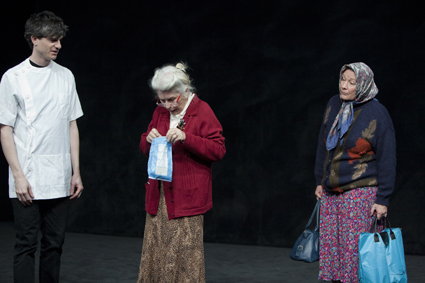
Stefan Gregory, Robyn Nevin, Kris McQuade, Neighourhood Watch, Belvoir
photo Brett Boardman
Stefan Gregory, Robyn Nevin, Kris McQuade, Neighourhood Watch, Belvoir
belvoir: neighbourhood watch
Lally Katz’s Neighbourhood Watch is a whimsical fable with melancholic and even darker undercurrents; with a subdued melodramatic structure; and characters living on if almost over the edge of neurosis. The setting is Australian suburbia, the design two vast, overlapping grey walls cradling a performance space that becomes the everyday only by dint of costumes, occasional props and the opening ritual of the weekly placement of rubbish bins on imaginary footpaths where isolated neighbours are otherwise unlikely to meet. It’s a liminal space where past and present, reality and fantasy can likewise overlap at a word or the turn of a revolve.
Ana (Robyn Nevin), one of two central characters is a Hungarian immigrant—child of an uncaring father who dies young; near teenage victim of a serial killer; a nurse during World War II; prisoner in post-war detention camps for 14 years across Europe; and the literally imprisoned wife of an Italian in Australia. On the upside, she travels into Russia on behalf of a legless soldier she met in hospital and her marriage, in Australia, to a Serbian has been a happy one—until his death from cancer, from which Ana herself is also dying. This challenging life is revealed piece by piece across the duration of the play, building a complex character, exquisitely realised by Robyn Nevin, who oscillates between paranoia and brusque friendliness, often comically phrased in her broken English. She now lives alone with Bella, an aggressive Alsatian and constantly rejects the friendly approaches of an elderly Serbian woman, Milova (Kris McQuade), whom she regards as a spy, and treats her doctor appallingly as a murderer who seduced her husband: “You deliver first the news of my husband’s death and now of Ana’s. You kill us both.” Despite her paranoid disposition she chats amiably with a neighbour, Christina (Heather Mitchell), another cancer survivor, the local pharmacist and especially Catherine (Megan Holloway), a would-be actress in her mid 20s lamenting the loss of a lover, Martin (Ian Meadows).
The play’s momentum is predicated on the developing relationship between the older and the younger woman. Ana’s belief in her own sixth sense, her own “ultrasound,” is what she would like to instil in Catherine—a capacity to be distrustful of the world, while at the same time encouraging her, very conventionally, to find a relationship, or open up about the one she might have. She makes little headway. Ana, however, gives much to Catherine, a willing fantasist who slips easily into Ana’s role as the Hungarian woman’s past is played out—the revolve turns and the characters walk back in time, even to comic effect as Ana magically has Catherine and those she encounters speak in her odd English. But it can’t be said that Ana reciprocally draws Catherine out; this is a problem. Late in the play Ana learns that Martin is dead, a suicide, a ghost; in the meantime we’ve witnessed Catherine’s encounters with a returned Martin as real; she is more of a fantasist than we thought. Catherine’s closed life is echoed by that of her housemate, Ken, a diabetic in his 30s and would be filmmaker whose friends are online game-players. These two thinly support each other emotionally, although that falls part, each knowing the other can’t face reality.
While Ana is an idiosyncratic force to be reckoned with, Catherine is a simpler figure whom I wished had more character (despite Megan Holloway’s best efforts), brittleness perhaps, flights of fancy about her acting career, moments of giving way just a little to Ana’s probings. In the end Ana, Milova and Catherine come together; it’s a redemptive moment of a kind for Ana, conceding to see the film Mamma Mia with the two women and to have coffee at Milova’s home. In that very moment she collapses and presumably soon dies. Catherine and Ken are re-united, Ken has found a producer for his film, Catherine might have a role in it and they share the house with Ana’s dog. It’s an all too easeful crowd-pleasing ending, difficult to equate with the intensifying melancholy and the revelations of the play’s progress. But Katz and Nevin nonetheless create a powerful, complex stage force in their realisation of Ana.
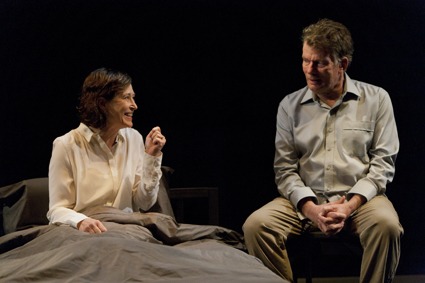
Linda Cropper, Russell Kiefel, No More Shall We Part, Griffin
courtesy Griffin Theatre
Linda Cropper, Russell Kiefel, No More Shall We Part, Griffin
griffin: and no more shall we part
A potential suicide in Tom Holloway’s And No More Shall We Part comes in the form of euthanasia, as a middle-aged wife, Pam, decides to end her life rather than endure the agonies that will come with her dying months. In her final hours as she waits in bed for the drugs to take effect, she and her husband converse with inevitable awkwardness, intimacy and moments of recollection. Scenes from previous weeks are interpolated into this grim night-watch, revealing Pam’s determination to die at a time of her own choosing rather than surrender to her husband’s accusations of selfishness or his fanciful suggestion of a trip to Switzerland for legal euthanasia—or, he hopes, advice there to abandon it. Don is progressively revealed to be something of a fantasist, not fully comprehending his wife’s need, clinging to a togetherness that cannot last. The play offers a gruelling experience not least in its disturbing, indeterminate conclusion.
Russell Kiefel as Don and Linda Cropper as Pam deliver subtle, sympathetic performances, passionate in the flashbacks, tentative and tender in the present, although Pam does not spare Tom her criticisms of his character. The sombre mood is occasionally if blackly alleviated, for example Don wondering if he goes to the toilet he’ll miss the moment of Pam’s dying. Amidst all the moral complexities, the overriding mood is one of sadness, not simply with regard to an impending death but because it’s the significant differences as much as the similarities between these two fairly ordinary people make them the couple they are. And sadder, Pam reveals herself to be something other than ordinary in her clarity of purpose and preparation without ever rejecting Don’s love. Sadder still is the alarming ending when Pam’s determination is defeated, but for how long? The mood however is somewhat undercut by the playwright’s insistent use of short lines of dialogue that overplay the tentativeness of the situation, adding too heavy an air of artifice. Holloway’s idiosyncratic stage language is usually much more effective; here it is in constant danger of locking into fixed rhythms. The set design is also somewhat awkward, alternating between bedroom and, behind it, dining room, making me wonder about the logic of the play’s flashback structure. But the calibre of the performances and the topicality of a demanding subject made for sustained if melancholy reflection long afterwards.
performance space: the harry harlow project
The Harry Harlow Project, a show from Melbourne written and performed by James Saunders and directed by Brian Lipson is a considerable challenge to one’s sense of empathy. The American psychologist (1905-1981) set up an experiment placing baby rhesus monkeys with surrogate ‘mothers,’ one a piece of terry cloth to show that the need for touch was critical and, the other, a wire structure that provided food—even then if the cloth was available it was preferred. But Harlow went further, torturing baby chimpanzees in his “pit of despair” for up to 24 months, driving them into psychosis by isolating them, depriving them of real maternal affection. Radically, he was out to prove that ‘love’ should be in the lexicon of mainstream psychology and that touch and nurture were crucial to the emotional and cognitive development of children. It’s almost impossible to believe that this was not a cultural given in the first half of the 20th century, but it wasn’t—intimacy was seen as spoiling the independent growth of the child.
The Harry Harlow Project reveals a man in decline, presumably at the end of his career, in a pit of despair of his own. The play creates a purgatory for Harlow, punishing him for his sins—his indifference to animals, his multiple marriages, his unscientific language (a forced mating device he named a “rape rack,” the wire mother an “iron maiden”). He feels nothing, loves nothing, he disconnects his phone, the shadow of a cage falling across his bed. Earlier, he lectures us, appears on TV, embraces a huge toy monkey and then crushes it. He inhabits a large white room. On the walls are dimly projected images of his monkey victims, but he declares, “I have no cloth…I am not a monkey.” His focus has been on what he can learn about human children via monkey behaviour, a desire “to save 100 million mistreated children, not monkeys.” While Harlow apparently changed attitudes to child raising and is much lauded for it, the means were appalling. That other scientists enacted similar torments on children makes Harlow no less a villain. Ironically his experiments are regarded as a trigger for the evolution of the animal liberation movement.
If you didn’t know who Harlow was then finding your way into The Harry Harlow Project could have been difficult: it’s a work that commences rather surreally, requiring considerable attentiveness as Saunders’ American-accented rendering of Harlow’s tirades and panics frequently hit the one note. But by the end the picture is clearer if complex. Are we supposed to pity this man in his living hell?—it’s a hard call. You leave the theatre curious, as if having watched a quite unfamiliar animal for the first time, but above all saddened at the inflicting of suffering on one species to reduce the pain of another.
Belvoir: The Seagull, writer Anton Chekhov, a version by director Benedict Andrews, performers Emily Barclay, Bille Brown, Gareth Davies, Judy Davis, Maeve Dermody, Mel Dyer, John Gaden, Anita Hegh, Terry Serio, Thomas Unger, David Wenham, Dylan Young, designer Ralph Myers, costumes Dale Ferguson, lighting Damien Cooper, composer, sound designer Stefan Gregory, Belvoir Upstairs, June 8-17; version 1.0 & Merrigong Theatre, The Table of Knowledge, devisor performers Arky Michael, Jane Phegan, Yana Taylor, Kim Vercoe, David Williams, deviser Alan Flower, video design, deviser Sean Bacon, sound design Gail Priest, lighting Frank Mainoo; Illawara Performing Arts Centre, Aug 30-Sept 20; Sydney Theatre Company, Next Stage: My Darling Patricia, Africa, concept Sam Routledge, director, writer Halcyon Macleod, performers Anthony Ahern, Michelle Robin Anderson, Clare Britton, Jodie Le Visconte, design Clare Britton, Bridget Dolan, composer, sound designer Declan Kelly, puppets Bryony Anderson, lighting Lucy Birkinshaw, STC, Wharf 2, Sept 1-17; Bully Beef Stew, co-creator director Andrea James, co-creators, performers Sonny Dallas Law, Colin Kinchela, Bjorn Stewart, choreographer Kirk Page, media artist Jacqui Mills, sound design Melissa Hunt, lighting Clytie Smith; PACT Theatre, June 29-July 9; Griffin Theatre Company: And No More Shall We Part, writer Tom Holloway, director Sam Strong, performers Linda Cropper, Russell Kiefel, designer Victoria Lamb, lighting Verity Hampson, sound design, composer Kelly Ryall, Griffin, Aug 4-Sept 3; Belvoir, Neighbourhood Watch, writer Lally Katz, director Simon Stone, performers Charlie Garber, Stefan Gregory, Megan Holloway, Kris McQuade, Ian Meadows, Heather Mitchell, Robyn Nevin, design Dale Ferguson, lighting Damien Cooper, composer, sound designer Stafan Gregory; Belvoir Upstairs, July 23-Aug 28; Performance Space & Mobile States: The Harry Harlow Project, writer-performer James Saunders, direction, design Brian Lipson, video artist Martyn Coutts; CarriageWorks, Sydney, Sept 7-10
RealTime issue #105 Oct-Nov 2011 pg. 34-35
© Keith Gallasch; for permission to reproduce apply to realtime@realtimearts.net
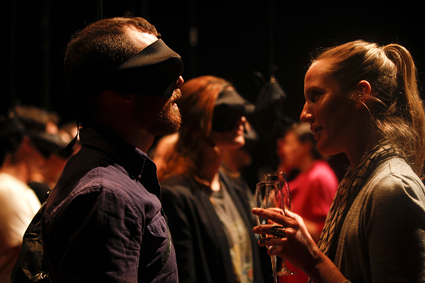
Thrashing Without Looking, Aphids
photo Ponch Hawkes
Thrashing Without Looking, Aphids
INCREASINGLY, I WANT EACH ARTS HOUSE SEASON TO COME WITH A CURATORIAL STATEMENT. YES, THE ART WORLD HAS, FOR AT LEAST A DECADE, BEEN ENGAGED IN A FURIOUS DEBATE ABOUT WHETHER CURATORSHIP HAS COME TO SUPERSEDE THE WORK OF ART.
Curation, in Anton Vidokle’s much-quoted words (e-flux Journal 16, May, 2010) now routinely oversteps the line, becoming a “reinforcement of authorial claims that render artists and artworks merely actors and props for illustrating curatorial concepts. Movement in such a direction runs the serious risk of diminishing the space of art by undermining the agency of its producers: artists.” However, as Alison Croggon has put it elsewhere, without critical reflection on the art of the times, without drawing connections, instead of a culture we will merely have ‘a lot of art.’
While offering much to enjoy this year, Melbourne’s Arts House has so far presented us largely with a lot of art. While I concede that it might understand its role as presentational rather than culture-shaping, as serving the artist rather than imposing a zeitgeist, Arts House is nonetheless the premiere venue for live art in Victoria. It makes programming decisions that shape how this city understands an artform; its lack of explanation does not diminish its curatorial power—it merely renders it opaque. Finally, I am unsure whether artists benefit from this silence at all if, as this year, the programming presents works of clashing sensibilities; works that, without proper juxtaposition, appear to negate each other’s propositions, ideas and statements.
By way of example: members of Sydney-based Team MESS introduced two intriguing participatory works, both sitting broadly within the British-inflected tradition of live art in which the unpredictable, artless liveness of the performance event is its chief intriguing ingredient, and art-ness obtained almost exclusively from the framing of the encounter. The first, This Is It, is set up as a press conference for a non-existent film that—judging by the promotional material we are offered—merrily merges an infinitude of clichés of Australian cinema: a moody drama about a childless couple, haunted by suburban malaise and a mysterious dark-skinned stalker. The actors are terrific as diplomatic mouthpieces for the film: some with underlying anxieties (Malcolm Whittaker’s hands almost imperceptibly shaking throughout the evening), some unflappable in their pretty muteness (Kate Randall, perhaps a dumb starlet, but perhaps simply settled into her role as conference eye-candy); and finally Frank Mainoo, explaining that his character is simply “darkness,” “the Other” and “really a plot device more than a character.”
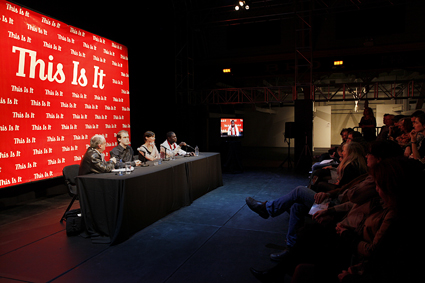
This Is It, Team MESS
photo Ponch Hawkes
This Is It, Team MESS
The format opens up for playful interaction as the event opens for questions invited from the floor. Questions start pouring in: about the reason for including zombies, shooting in 3D, possible sequels, Pasolini influences, interlaced with inquiries into Dara Gill’s directing method and racism. It was thrilling to watch the performers respond to this barrage of challenges, rising to incorporate our flights of fancy while remaining true to the characters and the set-up. “Well,” opined critic Paul Harris, the host of the event, “I’d say it might be a racist movie, but it does not endorse racism.” (See Julie Robson’s review of Team MESS at PICA)
The second work was Malcolm Whittaker’s A Lover’s Discourse, a love-letter-writing project for perfect strangers. As any performative dimension is completely absent from this collaborative effort, it presented itself through participants’ personal accounts, followed by attempts to find their correspondents live on Omegle (a roulette-like, random pairing chat room). While the event soon became tedious, as one’s recommended daily intake of irony was surpassed, it ended with a queue to sign up for further letter writing.
Both these works create only tenuous artistic frames around a collaborative exchange between participants who are only vaguely aware of the project’s agenda and in no way prevented from hijacking it. Indeed, the wide margin allowed for creative play is the biggest strength of both projects and much of the enjoyment seems to derive from actively testing the elasticity of the artful boundaries.
By contrast, Thrashing Without Looking, a project bringing together a number of prominent Melbourne-based live artists, divided the audience into two groups: one that assembled a karaoke video from a cryptic menu, and the other, strapped into video goggles (thus watching the event from the camera’s point of view), obediently executed their selection. Participation is the wrong word entirely to describe the audience’s role in this work. It is more accurate to think of us as theatre fodder, disoriented bodies reacting to a confusion of sensory inputs, or choosing through such a short list of options that a randomising script could have easily done the same job. However, the main interest of Thrashing Without Looking is in something else entirely: the old-fashioned blurring of mediated and live experience and the emotional and sensory vulnerability it provokes. (See John Bailey’s review.)
Post’s Who’s the Best? sails through similar waters, although the blurring here is, as usual, between the performers’ real and their performed selves. The technology is not only reduced to the bare bones of theatre (curtains and lights), but even those are wonky: the contest to decide which of the three members is the best is constantly undermined by the stage going about its own business, structuring the banter into a Shakespearean dramatic curve largely on light and sound alone (not dissimilar to Nature Theater of Oklahoma’s NO DICE). (See review in RT104)
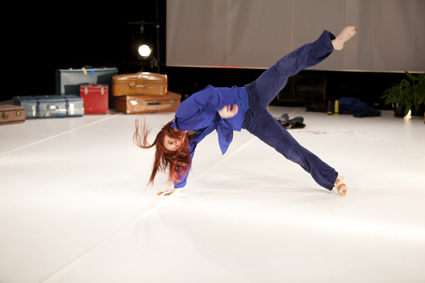
I left My Shoes on the Warm Concrete and Stood in the Rain, Gabrielle Nankivell
photo Ponch Hawkes
I left My Shoes on the Warm Concrete and Stood in the Rain, Gabrielle Nankivell
Next to it, Talya Rubin’s Of The Causes of Wonderful Things, a one-woman play that involves a town in the American South, missing children, a private detective and many small props, looks like an archival piece. While Rubin’s is an evocative performance—her ability to shift character is instantaneously mesmerising—there is so much style in the work (the 1940s noir, which has come to replace the Gothic as immediate indicator of macabre) and so little evidence of the concerns present in the rest of the season (liveness, mediation of reality, audience experience) that these qualities all but dis-appear in context. (See review in RT101)
The same could be said for Gabrielle Nankivell’s poetic I Left My Shoes on Warm Concrete and Stood in the Rain. It is a dance work weighed down by dense narration closely collaborating with sound and light (Luke Smiles and Benjamin Cisterne) to create a syncretic image of anxieties and fears plaguing a young woman. While technically impeccable and brilliantly performed, formally it is no more than an introspective dance poem, and it is unclear what prompted its inclusion in this ostensibly live art program.
Finally, what to make of the inclusion of Joan Baixas’ Pregnant Earth? An astonishing work, which incorporates live painting, puppetry and spoken narrative, from one of Spain’s great artists, it was both timeless and not of the moment. It revealed a depth of craft and a relatively independent set of concerns that needed to be somehow brought back into relation with the more fumbling, but fresher, set of local performances we had witnessed immediately prior. Without such a context, Baixas’ delicate and violent narrative, which moved from the burnt National Library of Sarajevo to a puppet that did not like to perform, was both weighty and stupefying.
We have come to expect such radical decontextualisation from mainstream festivals, which in Australia function exclusively as showcases and, indeed, Pregnant Earth would have made perfect sense had it been programmed in the Melbourne International Arts Festival. And yet, if even food and film festivals shape their programs with some subheadings and introductions, how is it possible that suggesting the same to an arts festival has become a hallmark of art sabotage?
Arts House: This Is It, created by Team MESS, performers Frank Mainoo, Natalie Randall, Malcolm Whittaker, Meat Market, Aug 5; A Lover’s Discourse, devised by Malcolm Whittaker, Meat Market, Aug 12; Thrashing Without Looking, creators Martyn Coutts, Elizabeth Dunn, Tristan Meecham, Lara Thoms, Willoh S Weiland, North Melbourne Town Hall, Aug 3-7; Who’s the Best?, devised and performed by post: Zoe Coombs Marr, Mish Grigor, Natalie Rose with Eden Falk, Meat Market, Aug 3-6; Of the Causes of Wonderful Things, writer, deviser, performer Talya Rubin, co-deviser, director Nick James, Meat Market, Aug 11-13; I Left My Shoes on Warm Concrete and Stood in the Rain, text, physical content & performance Gabrielle Nankivell, sound Motion Laboratories – Luke Smiles, design Benjamin Cisterne, North Melbourne Town Hall, Aug 11-13; Pregnant Earth, devisor, performer Joan Baixas, Arts House Meat Market, Melbourne Aug 16-17
RealTime issue #105 Oct-Nov 2011 pg. 36
© Jana Perkovic; for permission to reproduce apply to realtime@realtimearts.net
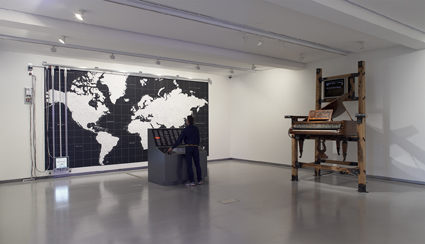
Slave Pianos, installation
photo Christian Capurro
Slave Pianos, installation
SLAVE PIANOS’ PERFORMANCE OF THE GIFT—REDACTION AND DECONTAMINATION (2011) AT THE MONASH UNIVERSITY MUSEUM OF ART CLOSED A PARTIAL SURVEY OF SOME OF DANIUS KESMINAS’ VARIED COLLABORATIVE PROJECTS. THE GIFT SPECIFICALLY ‘PERFORMANCISED’ THREE ROOMS CONTAINING KESMINAS’ PROJECTS—MEANING SLAVE PIANOS ELABORATED THE THEMES AND REFERENCES FROM EACH OF THESE INSTALLED SPACES INTO PERFORMED WORKS.
Let me briefly sketch these complex spaces. The Slave Pianos room contained a Cold War-era fabrication of a global bunker for disseminating obtuse musical texts composed by contemporary artists. These were ‘audio-visualised’ via a huge wall map across which an automated map-plotter bore a small TV screen which named a piece’s title, date and composer when it reached that composer’s country of residence, at which point a MIDI-controlled grand piano (affixed to a fashioned electrical chair) ‘performed’ the quoted piece. The Punkasila room contained numerous artefacts from Kesminas’ collaboration with the Indonesian agit-punk group Punkasila, displaying the band’s ‘meta-batik’ costumes, hand-painted banners and rifle-prop guitar constructions. And the Pipeline To Oblivion room projected Kesminas’ documentary interview with a Lithuanian farmer who illegally distilled vodka, while in the centre of the room a working still was hooked up to a pump organ to play a Lithuanian folk melody.
While the installations featured the objects and texts described above, the Slave Pianos’ staging of those objects and texts rendered all references musical. The rooms generated the score for the performance, and in turn illuminated their musical genesis. All of Kesminas’ art is wilfully and sardonically tainted by music and musicology, and while many of his performance projects have occurred in a variety of music venues and contexts, his Slave Pianos project often occurs within galleries and museums. The Gift was an astounding declaration of the trajectory Slave Pianos has refined over decades.
Now if this were 1961, we could continue tra-la-la-ing down a Fluxus garden path. I could programmatically champion how the gallery allows space for contra-musical pro-conceptual investigations of music—a sort of music heavy on conceptualising the performative and light on exploring the sonic. For those early Fluxus manoeuvres were warranted retorts to the academicism of notational avant-garde music—especially the revolutionary atonal/post-tonal modes which had struggled to define a post-war canon for the concert hall. Inspired by John Cage’s late 50s philosophising on musical eventfulness and procedures for activating a consciousness in musical practice, Fluxus were trans-medial in the true Dada tradition, de-specifying art forms and in the process welcoming actionist tactics and conceptual strategies.
Unfortunately, if one reads supposedly critical (let alone theoretical) writing on contemporary music sixty years later in 2011, it seems we are still living in 1961. Many things currently appear to be at stake—the drive to explore, the will to comment, the need to subvert, the power to startle, the mandate to re-orient—but a theatre of ideological gestures qualifies these views. Rarely has experimental/exploratory music/sound/art (pick your own T-shirt: one size fits all) evidenced conceptual rigour which opens up a critical space for discussing music. In place, experimental music enacts experimentalism as a series of codified tropes, almost as if the 60s is fetishised as some golden period where, well, experiments were undertaken. Sure, modulating nodes like punk, Max-DSP, globalism, the internet etc have changed a few things in the now, but as a survey of the names of the myriad new-sound/music festivals around the world attest, their claims to radicalism reside in their branded logos more than generative outcomes.
Yet Slave Pianos’ staging of The Gift achieved so much of what Fluxus only ever flaunted in its insular pseudo-utopian conceptualisation of a revolutionary/liberating/empowering art. Far from making effete claims to being music of an exploratory post-Cageian form, The Gift instead uses music as a platform to articulate and vent a dense conceptualism of music as a textual force. Hilariously quoting risible bourgeois waffle about ‘the art world’ from a Joanna Murray-Smith play, an autobiography by Nikola Tesla, ruminations on Nietzsche’s pessimistic attraction to pianos and Soviet journalist Vitali Vitaliev’s earthy embrace of vodka, The Gift plotted an obtuse series of incidents where music and creativity are treated as produce of ‘the gifted.’ Kesminas seems bent on debunking creativity as a privileged act, and his conceptual interrogation of the muse in music—via his quoted texts performed by actor Richard Piper—ably queries musical production and its musicological reception.
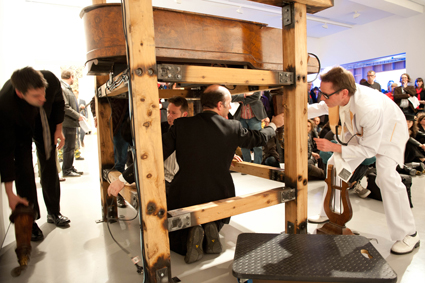
Slave Pianos, The Gift: Redaction and Decontamination, Performance
photo Andrius Lipsys
Slave Pianos, The Gift: Redaction and Decontamination, Performance
There is boldness in this move. In the arts, few things are so upsetting to more people than shifting (more like dragging screaming) music into the conceptual domain. That most turgidly theoretical and nullifying abstract of places wherein the sonic, the experiential, the exploratory should not venture. The fundamentalist tenets of music believe it to be somehow capable of mystically escaping discourse. I sense this in just about any writing on sound and music: the feeling that the words distrust themselves, that they are dreadful linguistic apologies for the supreme essentialism of ‘music itself.’ Such a view verges on the theological: as if to speak about sound/music with any conceptual bent incurs wrath. This implies that music is mired by an awful iconic orthodoxy which prohibits discourse due to sound and music’s inalienable unutterability.
Cage—in a supreme stroke of authorial scripture which is rarely critically attributed to his oeuvre—actively halts discussion post-performance. It is as if the event—the thing which most excited Fluxus—allows conceptual birthing but forbids conceptual growth. Discussion about the Cageian legacy tends toward discussing the concepts behind the sounds of works like the Variations series (its instructions, their interpretation, the works’ eventfulness etc), rather than discussing the sounds conceptually. This has partially shaped the ongoing impasse of incisive writing on new/experimental sound/music: its critical writing enforces either humanist performance mechanics (paraphrasing traditional jazz ideologies) or reverts to authorial acquiesence. It’s a situation I find entirely conservative.
The thing is, Cage—via Duchamp—gave me license to accept that all material and plastic arts (ie everything but literature) are powerful enough to carry any conceptual weight thrust on them. Music especially seems that way to me. Far from shirking from the fear that one might ‘kill’ sound/music by being too analytical about its materiality—let alone its cultural semiotics—I’ve always figured sound/music to be an immersive world which activates critically reflexive thought while it incites psychologically responsive feeling. To write about music—to acknowledge its textual potentiality—is inevitable, exciting and productive. To continue invoking historically proscribed pseudo-radical truisms about music’s linkage to avant-garde, experimental and exploratory strategies seems quite the opposite.
Experiencing The Gift as an actual outcome of Fluxus practice, I was forcefully reminded that ye olde white cube still has power. This particular Slave Pianos event maximised the ‘void-space’ of art to consider music in a way that is unthinkable in the current social contexts for experimental/exploratory music-making. And while maybe a recording of The Gift would be played as few times in my collection as my Cage recordings, the eventfulness of the staging sharpened the conceptual precision of the project. More Godardian than Cageian, The Gift returned the conceptual to music. Think of it as a welcome home gift.
Slave Pianos, Punkasila, Pipeline to Oblivion, 3 Projects by Danius Kesminas and collaborators, curator Max Delany; Slave Pianos performance, The Gift—Redaction and Decontamination, July 23; Monash University Museum of Art, Caulfield campus, Melbourne, May 5-July 23
RealTime issue #105 Oct-Nov 2011 pg. 37
© Philip Brophy; for permission to reproduce apply to realtime@realtimearts.net
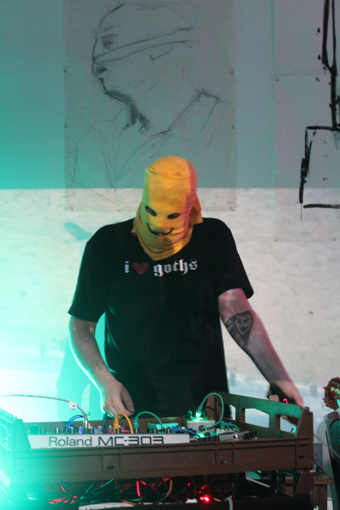
FUKNO, 1/4_inch
photo Aaron Hull
FUKNO, 1/4_inch
IN THE FINAL PART OF THIS SURVEY OF EXPERIMENTAL MUSIC ACTIVITIES AROUND SYDNEY (AND A LITTLE BIT BEYOND) I ATTEND ONE OF THE LONGEST RUNNING AND MOST NOMADIC EVENTS, 1/4_INCH, AND THE YOUNGEST OF THE BUNCH, PSH.LIVE, OPERATING OUT OF A NEW ARTIST-RUN-SPACE IN ROZELLE .
¼_inch
¼_inch began in 2002 in the heady days of the first wave of experimental audio events. Started by Aaron Hull and Julius Ambroisine, then students at the University of Western Sydney, it sought to complement gigs like Caleb Kelly’s impermanent.audio. Both took place at The Frequency Lab and while Kelly certainly programmed emerging artists ¼_inch had an arguably more laid-back curatorial approach, presenting more student works and a more diverse range of musics.
In 2005 Hull moved events to Wollongong (where he lives and works) still presenting occasional Sydney shows; however as of 2010 he has concentrated solely on Wollongong. Since 2008 events have been co-curated with Greg Hughes taking place in a range of venues including the iconic Headlands Hotel in Austinmer (now closed, the site slated for redevelopment), a modern industrial unit and various spaces around University of Wollongong. The night I attended, the venue was Yours and Owls, a cute café bar in the heart of Wollongong’s CBD.
It was hard not to expect a playful tone to the night with band names such as Gregisms, Wizard Bong, FUKNO and a DJ known as AKA. Gregisms is Dean English & Jariss Shead, students at the University of Wollongong, playing, to my taste, the most engaging set of the night. Using no-input mixing, voice, iPhone and various other effects they create sculpted layers of textured feedback, filling the harmonic spectrum to create an intense soundscape with satisfying internal logics and plenty of detail.
Next up was Wizard Bong—Fraughman (Steve Stuart) on guitar/vocals and Swerve (Steve Harris of DualPlover label) on analogue synthesiser/vocals. Perhaps their sound was too big for such a small room serviced by a non-attended PA, as even they admitted that they struggled to create any sense of structure or relative clarity within their particular brand of guitar assault cum big synth effects and vocal screamo. A shame, as listening to their tracks later online (http://wizardbong.bandcamp.com/releases) there’s definitely something intriguing going on there that sounds completely different from their live performance.
Final act for the night was local hero FUKNO who appeared with a yellow T-shirt fashioned into a balaclava with drawn-on smiley face, playing a range of electronics housed in a plastic bread-delivery crate. The music is noisy, crunchy idiosyncratic techno, with unpredictable squeals and squelches over great thumping beats that he bribes us to dance to by passing out tabs of “acid.” Maybe they worked as a few lads hit the one-by-one-metre dance floor. It’s a neat, well-executed parody (or extension of a form, I’m not quite sure which) and particularly amusing given the inappropriateness of the venue.
This session of ¼_inch had cohesion in its selection of acts, playful and chaotic as they were. Other events have had more serious approaches and the very presence of the gig in a regional city (admittedly one very close to Sydney) is important in terms of developing local musicians and the beginnings of an east-coast touring circuit for both interstate and international artists.
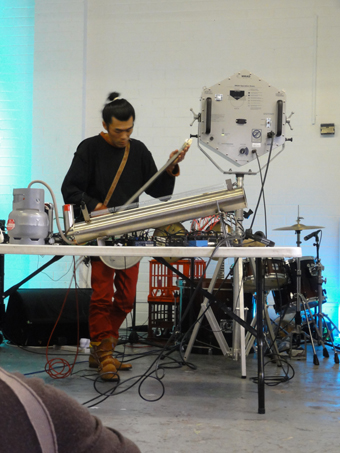
Defektro, PSH.Live
photo Gail Priest
Defektro, PSH.Live
psh.live
It seems fitting to end this series on sound events in Sydney with the newest gig on the scene, PSH.Live. The PSH gallery is part of Anyplace Projects, a collective that negotiates between property owners and potential tenants to allow temporary use of unoccupied spaces for community and cultural purposes. The Terry Street warehouse in Rozelle includes the Blood & Thunder printing press, a screen-printing facility open to the public, a cinema, a band rehearsal room and artists’ studios. The PSH gallery is basically the garage of the warehouse, allowing one-night-only exhibitions, and also opens its roller door once a month on a Sunday afternoon for live experimental music curated by Romy Caen (also curator of Sound Series see Part 2, RT104) and Liam O’Donoghue.
The July instalment focused on handmade and home-hacked instruments. Anomie kicked off the afternoon with John Papert on cobbled together drum kit augmented with glass vases and objects and Mark Hall on pedals and guitar. Papert’s percussion has an orchestral feel, with deep tom rolls, cymbals, gongs and glassy boings on the vases, spacious and well integrated with Hall’s sheets of affected guitar feedback moving through a nice mix of rhythmic shifts.
Next up was Defektro (Hirofumi Uchino) who makes his own effects pedals and instruments. With a startling array of electronics on the table in front of him, his version of noise is curiously restrained and minimal with only a few sonic elements introduced at one time—a slow insistent beat, scraping metals, small taps and the occasional squall of dirty feedback. The effect is of small episodes of sound and I wish for more momentum in the middle section but he makes up for this with his shredding jet engine sequence near the end, augmented by a military-like parabolic speaker scattering sound around the small space in unpredictable directions. Of course it’s impossible not to mention the gas-powered sound cannon that shoots a burst of flame when the spring mechanism is hit, producing a surprisingly sweet clang and quiet whoomf. Defektro also sells his pedals, which are beautiful hand-made objects in themselves.
The final act of the afternoon was Mike Majkowski and Dale Gorfinkel working with extended techniques on double bass and vibraphone respectively, an interesting analogue complement to the earlier acts, and covered recently in RealTime (see Part 2, RT104).
Given the range of events discussed in this series of articles, one might wonder whether we needed another experimental music gig, however PSH.Live offers a point of difference by including an after-show discussion. The conversation following this performance covered instrument building and its political, economic and creative motivations as well as lively debate around the difference between experimental practices and experimental music. All the discussions are transcribed and published online, along with full sound files of each to the sets. This is a great resource (though difficult to find on the Anyplace site without the direct link from Facebook; www.anyplaceprojects.com/?p=129), and makes PSH.Live a vital addition to the culture of experimental music in Sydney and most particularly its documentation.
life cycles
The gig series featured in this three-part survey are key activities that ensure a vibrant spirit of adventure and innovation across a range of music practices including pop, improv, noise and electronica, which for better or worse can be defined as experimental in agenda. In addition to these events there are also venues that mount individual gigs such as Dirty Shirlows and the CAD Factory, and a few loungeroom events that wish to remain under the radar for fear of the imposition of town council regulations. There’s a range of activities more in the jazz realm such as 501, Colbourne Ave at Glebe Cafe Church, Impermanent Studio, Cockatoo Calling and regular SIMA events that also have an impact on the vibrancy of the non-mainstream musical landscape. While some of the events occasionally receive funding, allowing artists to be paid a small fee, on the whole these activities are fuelled solely by a passion to provide avenues for artists to explore their practice and for audiences to experience new sounds. This DIY model inevitably leads to short life cycles, although this survey illustrates that longevity is sometimes possible. As the impact of new liquor and public entertainment licensing laws is just beginning to be felt in Sydney, I look forward to seeing which events will thrive and what new activities will develop in the future.
¼_inch, curators Aaron Hull, Greg Hughes, performers, AKA, Gregisms, Wizard Bong, FUKNO, Yours & Owls, Wollongong, Aug 25; www.1-4inch.com; PSH.Live, curators Romy Caen, Liam O’Donoghue, performers Anomie, Defektro, Dale Gorfinkel & Mike Majkowski, PSH Gallery, Rozelle; July 31; www.anyplaceprojects.com
See also Part 1: The Silent Hour, Ladyz in Noyz, High Reflections (RT103) and Part 2: The NOW now, Sound Series (RT104)
RealTime issue #105 Oct-Nov 2011 pg. 36
© Gail Priest; for permission to reproduce apply to realtime@realtimearts.net
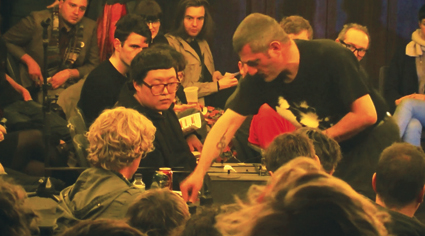
Jerome Noetinger, Overground
screen shot Joshua Watson
Jerome Noetinger, Overground
THE SECOND OVERGROUND, THE FESTIVAL-WITHIN-A-FESTIVAL SHOWCASING “CREATIVE AND IMPROVISATIONAL ARTISTS” AT THE 2011 MELBOURNE INTERNATIONAL JAZZ FESTIVAL, WAS AS CONTESTED AND CURIOUS A BEAST AS THE INAUGURAL EVENT, WHICH TOOK PLACE AT THE 2010 FESTIVAL.
The focus this year was on international, inter-generational and inter-scene collaboration, which is laudable enough as a buzz-word gambit, until you realize exactly what this kind of unguided, ‘pick-a-name-out-of-the-hat’ cross-wiring often leads to—‘experimentation’ in its most pejorative sense, as if some kind of dumb mathematical equation (ie Tony Conrad + Chris Abrahams) could equate to engrossing performance, simply by resting on brand power. It was not to be.
The highlights came early. Entering the main room in the Town Hall, I caught Charlemagne Palestine and Oren Ambarchi in deep commune, Palestine working the Town Hall organ with rigorous yet sensitive force, Ambarchi further mutating the bottom-end. Both artists have pretty much defined their aesthetic remit by now, such that the combination of Palestine and Ambarchi yields exactly what you’d expect, but in this case the duo was both a no-brainer and perhaps the most genuinely sympatico collaboration of the day’s events. They managed to do one thing, brilliantly, over the course of a simple half hour—a lesson that many of the other performers at Overground would have done well to learn.
Palestine’s next performance was to be a solo set of his electronics, but he backed out, which meant the organisers wisely bumped Jérôme Noetinger’s solo performance across the schedule, into a longer slot. After a charming spoken introduction, Noetinger spent 19 minutes proving why he is still the master of the Revox: few other artists have such a clear, eloquent grasp of their instrument and of the possibilities of live electroacoustics. Part of the pleasure of Noetinger’s performance was its tactility, the sheer sensual pleasure of watching a tape gently looping around reels laid flat, while he toggled switches, manhandled the tape to slow, speed or warp the audio, turned his concrete vocals to rough, abraded signal and generally mapped his mastery of the idiom into a concise, gripping performance. Nothing to fault here—Noetinger is in a class of his own.
Après, le deluge. The remaining hours of Overground, sadly, offered little of merit. Collaborative endeavour within experimental music is a tricky beast, one further complicated by the presence of free improvisation as a sub-set within the meta-genre. But improvisation is not a simple metonym for experiment and Overground repeatedly placed artists together who were fine working within their own dialect, but not (yet) able to speak across boundaries. As one local wag mentioned later, “If it were Derek Bailey playing with another top-flight improviser, things would be different,” but this wasn’t—not to take away from the performers necessarily. However too often this kind of all-in-one love-fest of experimentation offers little to the audience beyond the sum of its parts.
The pairing of Jim Denley and xNOBBQx was a clear example. The set felt like a botched attempt at entente cordiale between xNOBBQx’s wild punk primitivism and Denley’s glossolalic improvisations. There were moments dotted throughout where they almost built up momentum, but mostly this consisted of two ideas running parallel, without the thrills that seemingly random, post-Surrealist juxtaposition can throw at the listener. In the end I simply wished I’d seen both performers do their usual fabulous things. Sky Needle and Snawklor were perhaps more suited, but they faced a similar problem. Both worked well with their own idiom, but the results didn’t gel. Sky Needle also seemed a little lost, the initial charm of their shtick—hand-made instruments turning out brilliantly odd avant-pop miniatures—wearing a bit thin, with little new to offer. Let’s hope this is just a holding gesture, while they figure out their next step.
Will Guthrie and Cured Pink was another abortive mismatch. Since moving to Nantes, France several years ago, Guthrie’s playing has shot through the firmament, but this new articulacy was lost in his duo with Brisbane-based agent provocateur Cured Pink, who spent the set playing at the kind of fifth-rate body/sound art that was practically dead in the water by the mid 80s. Guthrie responded with some of the most physically vicious playing I’ve seen from him in some time, and if anything, this set was worthwhile just to see him behind a full kit again, playing with a desperate edge—I guess that’s called making the best of a tough situation.
Two of the drawcards of the festival were Krautrock pioneers Faust and their one-time collaborator, minimalist Tony Conrad. Tellingly, they were also drawcards for festivals in the Northern Hemisphere, such as the Table of the Elements in the mid to late 1990s. Faust’s set with Noetinger and Sean Baxter was an abject disaster of aimless ‘out-rock’ doodling, despite the brave attempts of both Baxter and Noetinger to get things on track. (It proved beyond doubt that the brilliance of Faust’s sainted 1970s albums was all due to their studio construction.) Closing the night, Conrad’s duo with Chris Abrahams was another botched collaboration, with Conrad treating Abrahams as an accompanist, playing weak-kneed, scraping violin improv stylings with all the style of a remedial Jon Rose, giving Abrahams nothing to actively work with. It speaks volumes of Baxter and Abrahams that they pushed against the odds; and if anything, Overground proves that Australian experimental and improvised music is both thriving and deserving of a far better showcase.
The presence of the festival’s roamers and installation artists was most telling of the contentious relationship between official festival culture and the feverish creativity of the underground, loaded and uncomfortable though that word may be. There’s no denying that they added character to the event – walking past disco auteur Fabio Umberto doing his thing in a stairwell was one of the day’s highlights. But when performers dared to cross an invisible psychic line, such as when vocal scream artist Kusum Normoyle set up and gave an electrifying solo scream performance while ‘official’ festival musicians were playing in an adjacent room, only to be abruptly shut down by a festival co-organiser, the poverty of the set-up was made clear, despite co-curator Joel Stern’s assertion in Mess and Noise that the roamers were “asked…to be mobile, flexible, interventionist and interactive” (personal disclosure: I know Normoyle).
So, just remember, don’t be too interventionist and don’t disrupt the sanctity of official culture. (You can see the performance here: http://vimeo.com/25476198.) While Normoyle’s performance may have momentarily disrupted other artists, such are the risks one must accept when ‘intervention’ is encouraged. The moment was sadly telling of an overall lack of heart and spirit in an event that felt much more about hedging bets than really taking risks.
Overground, Melbourne International Jazz Festival, co-curators Sophia Brous, Lloyd Honeybrook, Joel Stern, Melbourne Town Hall, June 9
RealTime issue #105 Oct-Nov 2011 pg. 40
© Jon Dale; for permission to reproduce apply to realtime@realtimearts.net
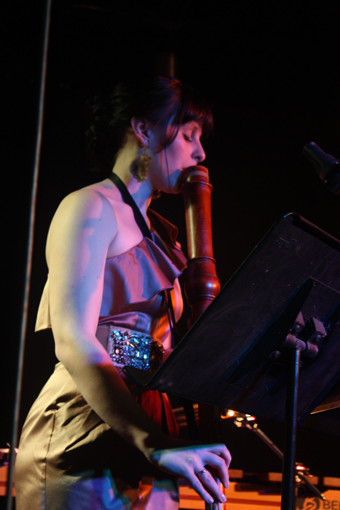
Alicia Crossley
photo Erin Cardenzana
Alicia Crossley
CHRONOLOGY ARTS, A COLLECTIVE OF COMPOSERS PREDOMINANTLY CONSISTING OF GRADUATES FROM THE SYDNEY CONSERVATORIUM, WAS FORMED WITH THE AIM OF PROVIDING A PLATFORM FOR THE AIRING OF NEW AUSTRALIAN MUSIC.
Addicted to Bass, the performance I attended, was part of this ongoing project. Alicia Crossley had approached seven of Australia’s leading young composers during her Masters research into bass recorder performance, to compose “pioneering works that would launch the bass recorder into the twenty-first century, pushing extremes.”
Financing these commissions herself, Crossley was determined not only to develop the repertoire of her favourite instrument but to feed Sydney’s budding new-music scene. This endeavour ticked all the boxes of contemporary composition: obscure instrumentation, sexy performer and underground venue (Sound Lounge is a concrete bunker under Sydney University’s Seymour Centre). The ambitious compositions delivered by the beautifully bejewelled Crossley varied in listenability. Some compositions explored the crossovers and divides of timbral combinations, including Tristan Coelho’s As the Dust Settles. Others felt like they might have been better expressed through poetry or dance rather than the abstract world of sound. In some cases, such as Night Seller Tissue Season by Hayden Woolf, Canto-Fiato by Chris Williams or Calliphora by Mark Oliveiro, the concepts were easier to appreciate than their execution in composition and performance.
Calliphora is the Latin name for the common blowfly. Oliveiro’s work for bass recorder and electronics was designed to mimic the sounds that might be heard if a tiny microphone were placed under a fly’s wings. Making use of trills and overblown high notes, it would make the perfect soundtrack to an interactive aeronautical museum. At times echoes seemed to come through long tin piping, hinting at the digestive system of a mechanical cockroach. A motif of overblown harmonics had Aboriginal dreamtime overtones.
Woolf’s trio for soprano, piano and bass recorder entered the bleak world of illegal organ trade. Supposedly this was a metaphor for the recorder’s innocent, disjointed and vulnerable reputation. With lyrics that included: “thieves laugh, cash comes in…vascular vulture he is slicing our surgical frown…we are meat, just meat to you, milked of our meat…payment refused, organ abuse…” and a rollicking piano line, the treatment of this very serious issue played out musically as too tongue in cheek. “Defective subjects screech…” soprano Anna Fraser shrieked. As pure musical romp, it had good movement and contrasting sections but it could have been written for any instruments. The bass recorderness was not immediately apparent.
Doppelganger by Elias Constantopedos continued in the language of 20th century composers for recorder including Hans Ulrich Staeps and Chiel Meijering. However, rather than creating layered lines in ensemble writing, he let technology duplicate and modify solo sounds. All electronics were created live from the bass recorder input and shaped by sound engineer Ben Carey.
Impulse Stream, Alex Pozniac’s work for solo bass recorder was the stand out, seeming to come from a well-defined source, a self-etched canon including solo works Mercurial, Interventions, Crush and Flying Verticles. To communicate the value of the usually marginalised recorder, Pozniac revealed some of the technical skill required to play it well. Recognising the big recorder’s tone production as “fragile and malleable” Pozniac’s piece allowed Crossley to demonstrate her technical brilliance by withdrawing her instrument from the equation, at times having her sing and vocalise the tonguing she would otherwise direct into the recorder: T k t k t tktktktktktk. WoooooOOOooooo. The composition also captured allusions to childhood self-consciousness by having Crossley whistle and sing in a high-pitched, nervous way. Her little girl voice begged pardon for her technical virtuosity in a wonderful opposition. Pozniac not only explained the technical stream of recorder playing but the impulses of the recorder player’s self doubt.
Andrew Batt Rawden introduced his piece E, for bass recorder and electronics, as a battle. His title is derived from the abbreviated name for Ecstasy, a drug Batt Rawden admits he has never tried. He imagines the drug helps to “transcend consciousness and exit corporeality into a darker side of the mind” and that while the drug is said to produce a friendly haze, there is “more to love than the fluffy bits.” But what of the performance? Crossley looked great in chunky headphones but her recorder was so heavily miked that sheet-music page turns turned out to be major sound events in the battle.
Addicted to Bass was built on a solid base of musical integrity if sometimes competing with an aura of glamour. The project has been a success in the sense that repertoire for bass recorder has been expanded. By producing a commercial recording a space of reverence has been carved out around these new compositions: a sort of self validating gesture which is absolutely valuable because who is better equipped to judge the merit of this innovation than musical peers? These young composers have collectively asserted that these works are worth circulating.
Alicia Crossley and Chronology Arts: Addicted to Bass, performers Alicia Crossley, Vatche Jambazian, Victoria Jacono, Joshua Hill, Anna Fraser and Ben Carey, Seymour Centre, Sydney, Aug 25
RealTime issue #105 Oct-Nov 2011 pg. 41
© Felicity Clark; for permission to reproduce apply to realtime@realtimearts.net
HAVING WON THE APRA/AMC ART MUSIC AWARD FOR EXCELLENCE BY AN ORGANISATION FOR THEIR ANNUAL PROGRAM AS WELL AS THE QUEENSLAND STATE AWARD (RT103), BRISBANE’S CLOCKED OUT ARE PRESENTING THE SECOND OF THEIR THE TRILLING WIRE SERIES WHICH BRINGS TO BRISBANE DARING NEW MUSIC PERFORMERS FROM ACROSS AUSTRALIA. THE MOVEMENT OF NEW MUSIC ACROSS STATE BORDERS, FOSTERED SO STRONGLY BY THE NEW MUSIC NETWORK AND EVENTS LIKE TURA’S TOTALLY HUGE AND MONA FOMA, IS GIVEN EXTRA AND MUCH-NEEDED IMPETUS BY THIS CLOCKED OUT INITIATIVE.
Erik Griswold, co-director of Clocked Out with Vanessa Tomlinson, tells me, “I started The Trilling Wire Series last year upon realising that there were a number of really great contemporary/experimental music ensembles around the country doing fantastic programs that never made it to Brisbane. So I invited Perth’s Decibel, Melbourne’s Golden Fur and Sydney’s Ensemble Offspring to come and present some of their best programs of 2010. Held in the intimate Shopfront space of the Judith Wright Centre, The Trilling Wire Series was a rare chance for audiences to hear avant-garde chamber music in a non-conservatorium environment.”
First up in the 2011 series is Adelaide’s Soundstream Collective, led by Gabriella Smart and resident ensemble at the University of Adelaide. Their program entirely focuses on the idiosyncratic Polish composer Hannah Kulenty’s Circle series (1994-96) representing “Kulenty’s self-titled ‘European trance music,’ her original version of ‘post-minimalist’ style…In many ways this music is closer to the meditative qualities of Indian ragas, rather than Western minimalism” (press release).
Chris Reid wrote about hearing the Fourth Circle at the Soundstream Adelaide New Music Festival in 2009: “Kulenty’s is a stunning piece, emotionally overwhelming and brilliantly executed. Following a long piano passage like a tolling bell, the cello begins a series of questioning phrases that become incessant, using short, microtonally notated glissandi, crying imploringly—why? why? why? An intense crescendo is then slowly relaxed, with the glissandi curling downward. I was speechless for some time afterwards, so affecting were the writing and the performance” (RT93). The Brisbane performance, a very special occasion, will be the first time the series will be played in its entirety, featuring musicians John Addison, Janet McKay, Martin Phillipson and Gabriella Smart.
Melbourne’s Quiver, led by Matthias Schack-Arnott, will present the meeting of Louise Curham’s “hyper-expressionist” 8mm film with David Young’s watercolour graphic scores—”Shot in Yokohama Japan, this 45-minute hand-processed Super 8 film/music work forms the basis of the musical scores…The inter-medial nature of the work creates a hovering connectedness between image and sound, shifting the boundaries between the artforms” (press release). The program also premieres a Quiver commission from James Rushford—Viper Gloss, with “a compositional process…informed by the ‘grisailles’ technique of staining glass, where different shades of grey are used to create the effect of a relief.”
The final concert in the series, Early Warning System, launches a new percussion-based ensemble directed by Michael Askill and Vanessa Tomlinson.
Tomlinson describes the concept for the group: “Michael has contributed so much to the identity of Australian music over four decades of work, commissioning composers, composing himself and generating huge enthusiasm for Australian music through his work with Synergy. Early Warning System harnesses his pioneering experiences and combines with my eclectic style of playing and interests.”
The group’s debut performance features works by American John Luther Adams (not the other John Adams; see The New Yorker, May 12, 2008, available online) and a premiere of a new composition for cello and percussion by Erik Griswold. Tomlinson says, “Both composers represent a way forward for acoustic percussion performance that acknowledges the listening detail of electronic music and is accepting of particularities of place. We will also be playing Chinese composer Tan Dun’s Snow in June—which obviously makes more sense in the southern hemisphere than the north—and a classic of Michael Askill’s, Free Radicals, dealing with rhythmic cycles and the joy of percussing.”
The title of the series comes from TS Eliot’s poem Burnt Norton, but what does it mean for Clocked Out? “The trilling wire in the blood/ Sings below inveterate scars/ And reconciles forgotten wars.” Erik Griswold says, “Yes, the TS Eliot connection is there. I also like the connection to a news wire—transmitting contemporary music developments around the country, and more generally to the notion of the trilling wire emitting vibrations, both acoustic and electronic. Taking a slightly broader context of that section of the poem, there is much brighter imagery which suggests energy and lightness: ‘The dance along the artery/ The circulation of the lymph/ Are figured in the drift of stars/ Ascend to summer in the tree/ We move above the moving tree/ In light upon the figured leaf’.”
Clocked Out, The Trilling Wire Series: Soundstream, Nov 3; Quiver, Nov 17, Early Warning System, Nov 23; The Judith Wright Centre, Brisbane. www.jwcoca.qld.gov.au/; www.clockedout.org
RealTime issue #105 Oct-Nov 2011 pg. 41
© Keith Gallasch; for permission to reproduce apply to realtime@realtimearts.net
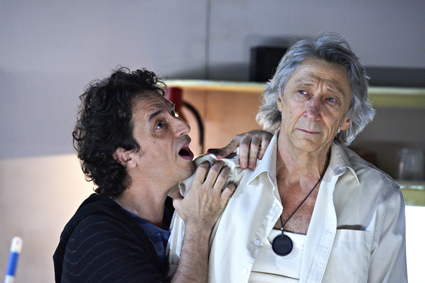
Paul Capsis and George Shvetsov, Malthouse
photo Jon Green
Paul Capsis and George Shvetsov, Malthouse
PUBLICITY FOR MATTHEW LUTTON’S MALTHOUSE PRODUCTION OF SCHUBERT’S DIE WINTERREISE PROMISES TO “CARRY US ACROSS THE AGES OF MAN TOWARDS SOMETHING THAT MAY NOT BE SALVATION, BUT MIGHT RESEMBLE SOMETHING LIKE GRACE.” MEANWHILE, IDA DUELUND HANSEN AND JETHRO WOODWARD’S RENDITION OF THE SONG CYCLE, TITLED BLOOD, IS PREFACED WITH AN IMAGE OF SCHUBERT PLAGUED BY SYPHILIS IN THE FINAL YEAR OF HIS LIFE, COMPOSING WHILE HALLUCINATING AND COUGHING UP BLOOD. THE IMAGES OF THE COMPOSER AS EITHER A WISTFUL INVALID OR AN ANGRY YOUNG MAN CAN OVERSHADOW THE ROMANTIC CONVENTION OF LITERARY IRONY THAT PERMEATES SCHUBERT’S LIEDER.
These two productions came closest to achieving bitterness and repose when they refrained from presenting “sad” or “angry” Schubert and—often by radically altering the original score—delicately portrayed conflicting effects.
In his memoir, Schubert’s friend Josef von Spaun recalls being “dumbfounded” by Die Winterreise’s “gloomy mood,” before suggesting that the intense emotion of the work contributed to the composer’s early death. Here we find von Spaun under the sway of an 18th century notion of the melancholic artist, an image that we cling to today.
The protagonist of Lutton’s Die Winterreise is one such character: a middle-aged man (George Shvetsov) pondering his turbulent life from the vantage point of a hot suburban living room. Sound designer Kelly Ryall diffuses Schubert’s songs—performed around the contemplative figure by Paul Capsis and Alister Spence—through a meditative fog of reverb. The songs are occasionally slowed down and their fragmented melodies repeated like the ruminative malcontent replaying his memories. Similarly, as part of Chamber Made Opera and The Malthouse’s Things on Sunday event, Blood, bassist and vocalist Duelund Hansen and sound designer Woodward mused over Die Winterreise’s text, harmonic turns and fragments of melody.
Another of Schubert’s friends, Johann Mayrhofer, remarked that “[h]e had been long and seriously ill, had gone through disheartening experiences, and life for him had shed its rosy colour; winter had come for him. The poet’s [Wilhelm Müller’s] irony, rooted in despair, appealed to him: he expressed it in cutting tones.” In Lutton’s production anger and bitterness were represented by unbearable, amplified shrieking.
The use of reverb, repetition and amplification in these productions presented unconvincing musical analogues of the emotions they were supposed to convey. Slow down, fragment and reverberate any music and it will become a ponderous sonic landscape. This device, much abused by sacred minimalists such as Arvo Pärt and John Tavener, presents a hollow image of the sublime that very quickly becomes tiring. Amplifying any sound enough will, far from triggering an existential crisis, leave the audience resenting the production for their ringing ears. In the context of Schubert’s music such one-dimensional presentation of affect mistakes the ends for the means. Schubert and his contemporaries understood that despair and the sublime were hard won through literary contradiction or irony.
As musicologists Susan Youens and Richard Taruskin have pointed out, Schubert’s lieder express suffering through a conflicting relationship between words and music. For example, dancing mockingly around the solemn protagonist of Lutton’s production, Capsis played up the sinister subtext of the sad–happy key change in “On the River.” In the song cycle, Schubert’s wanderer comes upon a frozen river and remembers its former joyful sound. At this point the piano accompaniment does not play an imitation of the remembered cheery bubble, but a menacing, loping bass line. When the wanderer writes his ex’s name on the river’s now frozen surface, a gesture that is hardly innocent and happy, the accompaniment modulates from E minor to E major. Recognising the similarity between the hard river and his broken heart, he asks whether there isn’t also, under its frozen surface, a raging torrent, whereupon the piano breaks into a frenetic clamour. As Capsis recognised, Die Winterreise does not smile, but smirks.
To Schubert’s favourite philosopher Friedrich Schlegel, irony as the incongruity of appearance and reality was a literary device engineered to produce a shock through which one could glimpse the irrational, the divine and the infinite. Duelund Hansen produces such an ironic effect on the word “Stürme” (storm) in “Einsamkeit” by changing the original score. Stürme, combining the roar of rain, a crack of lightning, and a peal of thunder, is usually howled over tumultuous piano chords. Duelund Hansen makes a decrescendo on this word, rendering the melodramatic gesture an impotent sob. This frustration of expectation reveals for a moment one’s distance from the raging storm, and in doing so, the magnitude of the storm itself.
I would argue that Schubert’s illness provides us with a situational irony that changes the way we hear his literary irony. It is one thing to hear an ironic passage and be confused for a second (read: glimpse the infinite) and quite another to feel oneself at odds with the world, such as during prolonged illness, when everyday activities seem hopelessly impossible. It is this situational irony, that of writing a clever song while using a chamber pot, that gives the true smirk to the first.
It is in expressing this situational irony that sincerity is required—and achieved—in both performances. Duelund Hansen begins her rendition with a mashup of two songs of estrangement, “Gute Nacht” and “Einsamkeit.” She delivers the lines “As a stranger I came, as a stranger I will leave” in a clear and direct tone, accompanying herself with chords played high on the double bass fingerboard. These chords, with their natural, unsaturated sound, provide a matter-of-fact plodding behind the remorseful statement. Lutton’s production concludes with the protagonist, after communicating his tragic past in a monologue, dancing to “Die Leiermann” (The Hurdy-Gurdy Man) with wry resignation. By understating and bringing together the conflicting emotions of Die Winterreise the productions develop a more complex and even sublime emotional palette. At these moments, though deviating or adding to Schubert’s original score, they are closer than ever to its spirit.
The Malthouse: Die Winterreise, songs Franz Schubert, concept, direction Matthew Lutton, orignal text Tom Holloway, choreography Chrissie Parrott, set, costumes Adam Gardnir, performers George Shvetsov, Paul Capsis, George O’Hara, Alister Spence, sound design Kelly Ryall, lighting Paul Jackson, music supervisor Iain Grandage, additional arrangements, composition Alister Spence; Malthouse, July 20-31; Malthouse & Chamber Made Opera, Things on Sunday series: Blood, songs Franz Schubert, double bass, voice Ida Duelund Hansen, performer Caroline Lee, sound design Jethro Woodward, other compositions Alex Garsden, Annie Hui-Hsin Hsieh, Jesse McVeity; Malthouse, Melbourne, July 31
RealTime issue #105 Oct-Nov 2011 pg. 42
© Matthew Lorenzon; for permission to reproduce apply to realtime@realtimearts.net
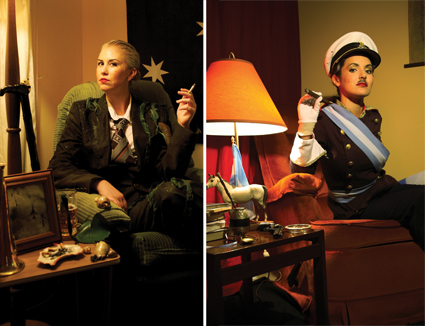
Tarryn Gill & Pilar Mata Dupont, Harold Holt 1968, Juan Carlos Ongania 1968
courtesy the artists
Tarryn Gill & Pilar Mata Dupont, Harold Holt 1968, Juan Carlos Ongania 1968
IF EVER THERE WERE A RACE TO BE PERTH’S ART DARLINGS, TARRYN GILL AND PILAR MATA DUPONT WOULD WIN. THEY TROT OUT A SUMPTUOUS AESTHETIC LIKE PROUD SHOW PONIES LADEN WITH RIBBONS. IT IS CLEAR TO SEE, HOWEVER, THAT IN THEIR COMPETITIVE SPIRIT, THEY ARE NOT BENIGN, OR AT LEAST THIS IS WHAT THE IMAGE ADVERTISING THEIR LATEST EXHIBITION, STADIUM, AT PICA (PERTH INSTITUTE OF CONTEMPORARY ART) SUGGESTS.
This image [see our cover] humorously reminds us that while the art game might be about prancing and parading, foul play is certainly not out of the question. The two artists link arms as a formidable duo on the racetrack, with the carnage of their fallen competitors splayed behind them. Their faces sport elated grins and their hair groomed to perfection contrasts with blood-splattered fists, tops and knees, that tell us a different story. This type of play of meaning underlies many of the duo’s works, though not always so literally; it is often articulated tongue-in-cheek. The seductive glamour, burlesque, kitsch-Australiana and Hollywood styling is adopted with a wry stare derived from a deeper critique of issues anchored in nationalism, militarism and patriotism.
Stadium marks Gill and Mata Dupont’s first survey exhibition, spanning a decade’s practice which has seen their meteoric rise to prominence through a bold and savvy aesthetic across a range of media encompassing performance, video, installation, design and photography. It is entirely appropriate that the PICA gallery be transformed into a sports arena for this show, replete with bleachers, a custom vinyl logo pasted on the ground and a mini-stage with weights and a boom box. The contextualisation of their practice expresses a degree of self-consciousness of their own torch-wielding power in the art world arena. It is articulated here in several series that demonstrate Gill and Mata Dupont’s fitness across the field in an intersection of ideas about art, sport and war, drawing from influences grounded in propaganda, autobiography, art history and most significantly, cinema—ranging from John Huston’s film of the musical Annie to Matthew Barney’s Cremaster 3.
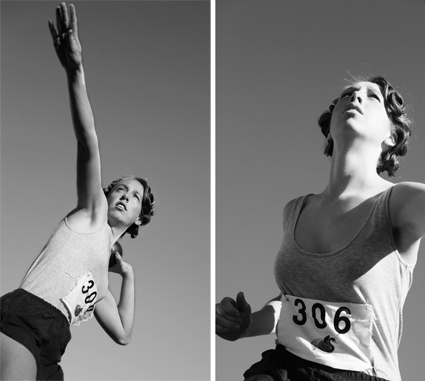
left – With Terrific Power Behind It The Shotput Hurtles High Above The Arena; right – In Their Dash to Victory The Runners Circle The Main Stadium
Tarryn Gill & Pilar Mata Dupont
left – With Terrific Power Behind It The Shotput Hurtles High Above The Arena; right – In Their Dash to Victory The Runners Circle The Main Stadium
On entry one encounters the raw structure of the rear of the stand of bleachers, opposite which are three photographs from the Stadium Series (2009) referencing the life and pioneering aesthetic of German filmmaker Leni Reifenstahl. Each black and white image features the same model in states of focused determination, aiming for victory. She’s captured in statuesque poses defined against the high-intensity glow of the sun, her face expressing the sheer exertion involved in fighting for the nation in the games arena. The nation is not Germany, but Australia, as attested by the swan logo decorating the model’s top. This kind of investigation into the sporting figure as iconic nationalistic hero subject to a fascistic routine recurs in another work on display, the video piece Gymnasium (2010), winner of the 2010 Basil Sellers art prize.
Gymnasium screens alongside other video works viewed from the bleachers. In a gymnasium, athletes are filmed mechanically and repetitively working through robotic routines. The ideals and values of the military are here aligned with sport, as the proud and grinning Aussie athletes imply.
In parallel gallery spaces a series of works are taken from Heart of Gold, an epic-scale project that propelled the duo, on their glittery trail, to a theatre production finale (see RT94). In Gallery 1, the Heart of Gold Project 5 blooms with a sumptuous intensity in the All Australian Lifesaver Series (2008), based on the Cronulla riots of 2005-2006. Here, Varga style girl models feature in sparkling red and gold skullcaps and shiny gold onesies, belted with red sashes. The images show no attempt to conceal their fiction; their celebration of artifice is excessive, from the cherry-red lips to the painted sunset backdrops. As such they reside in a realm of simulacra to poke fun at the high status of the lifesaver as an archetypal Australian hero. Of course, these ladies are more Hollywood Baywatch than Aussie surfer gritty and their gestures belie action in the static nature of their poses. But like the very image of the lifesaver in the Australian psyche, they are presented as women of action, women who have it all, sporting bodies and glamour-girl looks, “A Gladiator Class, Envied by all the Men, Adored by all the Women,” as one of the titles sardonically suggests.
Hero mythology is further explored with specific attention to the war hero. In the Heart of Gold Project 3 (2006-07) WWI and WWII propaganda posters are referenced in staged photographs (RT94, p42). Pictured are such scenes as women in the place of men on the front line, part of the ‘Boys Brigade’, their tarnished faces ever-enthused and glowing in blessed, blinkered, nationalistic pride. Drawing from their own autobiographies for The Presidential Portraits series (2008), Mata Dupont is made-up in the guise of Juan Carlos Onganía, defacto President of Argentina, while Gill becomes Harold Holt, each in their politically turbulent year of 1968. Troubled history also courses through Lament for the Argentine Military (2010), made for the 2010 Sydney Biennale. This work, part installation, photography and video, addresses Argentina’s history from the military perspective. It adopts such symbols as a teary Virgin of Luján, patron saint of Argentina, in a large-scale portrait and in the song and dance video a silvery green Ford Falcon, reportedly used in the middle of the night to forcibly take civilians from their homes. This work, like others in the exhibition, is crafted with keen attention to detail and framing made accessible through its adoption of the codes of high-fashion.
A Gill and Mata Dupont show would seem almost incomplete without the added seduction of a live event. On opening night and several dates in the exhibition season, the collided spectacle of art, sport and war was made performative. On the mini-stage, flexing muscles and pumping iron, was a body builder à la Charles Atlas and, to detract from the abjectly mesmerising quality of his bronzed pecs, was the piece de resistance, the premiere of a new performance, Ever Higher. In this work an aerialist triumphantly tackled a rope, rose and fell in a gracious tangle analogous to the precarious risks of sudden drops at the heart of a career in the arts as much as sport or the military. The aerialist climbed to reach a megaphone and, hanging upside-down, barked a chant at a troupe of cheerleaders dancing below who enthusiastically belted out spiked lyrics such as “Take your safety off your gun, let’s go have some combat fun.”
Gill and Mata Dupont demonstrate just how easily a golden propaganda machine can mask sinister realities. They dance through the games of the art world distracting and seducing onlookers with their rich and glittery aesthetic. Using the languages of fashion and dance, they have deployed archetypal sports star, war hero and glamour girl avatars in the last decade. For the next project can we anticipate Gill and Mata Dupont using the conceptual strength of their sense of irony and parody as a launch pad for a deeper critique? It is evident that their work contains the promise of something else, something more challenging, more disturbing, a little weirder.
Tarryn Gill & Pilar Mata Dupont, Stadium, curator Leigh Robb, STADIUM, PICA, Perth, Sept 3-Oct 30; Performances: Oct 15, 2pm; Oct 28, 4pm, as part of the Commonwealth Festival for CHOGM.
RealTime issue #105 Oct-Nov 2011 pg. 43
© Laetitia Wilson; for permission to reproduce apply to realtime@realtimearts.net
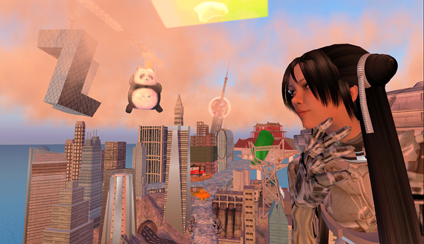
Cao Fei, China Tracey, RMB City, 2009
FROM CAO FEI’S ENTRE TO THE ART WORLD IN THE LATE 1990S SHE WAS PITCHED AS “NEW GENERATION”—A REPRESENTATIVE OF THE MUCH NEEDED NEXT WAVE OF ARTISTS TO CARRY ON FROM THE THEORETICAL DILEMMAS (AND HYPE) GENERATED AROUND THE CONTEMPORARY CHINESE ARTISTS WHO HAD PRECEDED HER. DRAWING ON THE LANGUAGES OF POP AND YOUTH CULTURES, SHE SIGNIFIED A NEW VOICE ON CHINESE SOCIETY, ONE THAT WAS SAVVY WITH GLOBALISATION AND COULD COMMENT ON CHINESE CONSUMERISM WITH THE TOOLS OF THE SYSTEM ITSELF.
More than 10 years on, Cao Fei is astoundingly accomplished, having spent the greater part of her 20s engaged in elaborate experiments with multimedia, collaborative performance pieces and deep explorations into the world of virtual reality. While primarily a video artist, Cao Fei’s interest in theatre has extended her work to the stage, often toying with the distinction between the digital and the real. Films inspired by the cultures of hip hop, pornography and gaming have given verve to her artistic vocabulary; meanwhile her cool eye is manifest in a number of shrewd documentaries. Cao’s works have been included in biennales around the world and dozens of catalogues and compendiums include essays under her name.
Is Cao Fei still next generation then? When asked, she raises her eyebrows sarcastically and, with characteristic minimalism, points to the eight-months pregnant belly before her (she also has a two-year-old son). “You’d still call me a young artist?” Whatever the relevance of such categories, however, Cao’s work maintains the same exuberance that first attracted the label of youth—the vivid colours of popular media and a preoccupation with fantasy.
at play with commercial culture
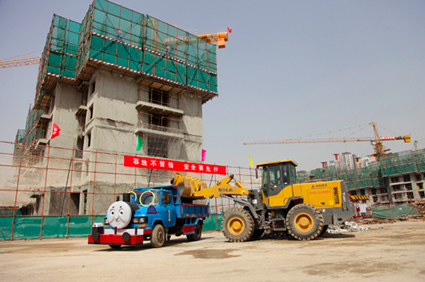
Cao Fei, East Wind (2011)
In Cao Fei’s most recent video work, East Wind (2011), a dinky blue Chinese truck with the face of Thomas the Tank Engine beetles around the streets of a Chinese city to the theme tune of the BBC program. The truck stops for petrol, attracting a crowd of delighted fans. It collects rubbish from a demolition site and then merrily takes this to a dump on the outskirts of town (the driver stopping for a pee by the side of the road on the way). With a sense of joyful conquest, the bright smiling face of Thomas charges through the changing Chinese landscape, announcing the triumph of simplicity at every turn.
“When I had my son, I came into contact with all these new DVDs. They gave me this new kind of feeling of innocence,” says Cao Fei. “You can learn a lot about the adult world through children’s culture,” she adds. As is common in Cao’s works, however, the spirit of innocence in East Wind belies the film’s sophistication. Using a nationally manufactured truck for this naively made Thomas (a truck developed by Mao in the 1950s and named East Wind with reference to the proverb “the East Wind will prevail over the West Wind”) and adding its own synthesised version of the theme song, the film is as much about Chinese appropriation of Western culture as it is about Western hegemony.
Raised in the country’s South, on a diet of MTV, foreign films and Hong Kong comedy, Cao has a droll kind of ease with the global commercialisation of culture: “Our generation of Chinese artists, those born in the 1970s, grew up after the Cultural Revolution so it didn’t really influence us that much. Of course our parents gave us a sense of that time, but the larger influences came from the 1980s—when Western culture came to China.” Curious rather than anxious about questions of authenticity, her art takes a playful approach, deploying these same images of commercial culture for its nimble social critiques.
a second life china
The activities which have most defined Cao Fei’s reputation to this point are those associated with her RMB City project—a highly ambitious and multi-faceted venture into the online world of Second Life. Beginning in 2007, with Cao’s creation of an avatar called China Tracy, the project quickly spiralled out into more than a dozen artworks and events, each one an experiment with popular media and a consideration of its power as a means of escape. The framework for all this was the RMB metropolis, built within virtual reality. A bubble-like
topography of Chinese landmarks and inflated pandas, RMB City was a vision of an aspirational China—”a city at the top of the economy”—named after the Chinese currency and dizzy with its own possibility.
With land for sale, and subjects needed, RMB City rapidly evolved into a collaboration with the contemporary Chinese art world. Prominent collectors such as Uli Sigg and the Ullens Centre for Contemporary Art purchased buildings and were accordingly given positions as mayors. Curators and fellow artists took on Second Life avatars and engaged with the project as citizens. A virtual Yokohama Triennale was even held in the city’s streets (a dancing, slightly drunken version), resulting in the film Play with Your Triennale (2008) which was shown later at the actual festival. As the city developed, its pumped up colours, youthful avatars and illusions of confidence came to suggest not only the hyper-reality of contemporary Beijing, or even global consumerism, but the international art world itself.
“It was a bit like a residency,” says Cao, referring to the role played by her investors and collaborators. “You could do a two- year residency in virtual space. And if you asked me what aspect I’m most proud of in RMB it would be the fact that it combined so many elements and people.” Accompanied by a range of press materials and merchandise—from stickers to newsletters to advertisements—RMB City became a major, almost orchestral, production. When asked about this penchant for theatrics, Cao points to her earliest film and documentary projects, and even beyond that to her years at school. “New media came later, along with the internet. But my first interest I’d say was performance.”
Cao and her gallery, Vitamin Space, are now looking to hand RMB over to new caretakers, ideally a university or research institute. “Students could use it, or people with the right kind of specialty,” she says. “This way we wouldn’t have to ‘delete’ it. It could continue as something alive.”
fantasy & melancholy
Not all of Cao Fei’s art is so colourful. Some of her best-known films are comparatively gritty, depicting China’s economic development with images conveying the reality. Even these works however are leavened with the effects of pop culture, the private desires that keep people going, or an editing that gives life to industrial machinery. Cao’s interest in China’s development appears to be largely in the aspirations that keep it churning and the melancholy that is the flip side of fantasy.
“Perhaps there is something in me which just can’t grow up,” she says. “The humour in my art—it might be a social critique, or a national critique, but it’s not so direct. It’s closer to daily life. It praises life and shows how people in all kinds of situations can find the happiness they need to live on.” Good-humoured more than ideological, Cao’s work often bristles with mischief and can brighten you on a bad day. It doesn’t challenge the consumer system so much as tease it gently (and articulately) from within. Perhaps Cao Fei could try an Annie Leibovitz move and do a strange Walt Disney commercial on the side. Her work is already a collaboration with various dream factories—a voyage of pop utopias conducted in the languages of illusion.
RealTime issue #105 Oct-Nov 2011 pg. 44
© Christen Cornell; for permission to reproduce apply to realtime@realtimearts.net
{$slideshow} DEPARTING THE HEADY, HUMID DOWNSTAIRS GALLERIES OF CAIRN’S KICKARTS YOU MOVE UP INTO THE COOL CALM OF KEITH ARMSTRONG AND JAMES MULLER’S REMNANT (V2). IMMEDIATELY YOU ARE SURROUNDED BY DELIBERATE, SLOW SOUNDS THAT ECHO THROUGHOUT THE SPACE. VISITORS RUSH IN, SHOVING A HEAVY BLACK CURTAIN ASIDE, AND THEN STOP, GAZING AROUND, THEIR MOVEMENT SLOWING, ADJUSTING TO THE DARK AND GRAVITATING TO A LARGE TRUMPET-LIKE ‘TELESCOPE’ SUSPENDED FROM THE CEILING AT THE ROOM’S CENTRE.
The equipment’s installation is a work in itself—you can clearly see all its functional components, nothing is concealed. The centrepiece is a large black viewing tunnel at the end of which appears a projected vector map on a floating screen at the end of the room. Suspended at the very end of the telescope is a hologram.
Interaction occurs when you position yourself at the entrance of the viewing platform, your head movements directing focus to different parts of maps of a rainforest reserve. The hologram layers a satellite map over a projected vector map, providing a 3D experience to you alone as you twist and turn your head to unlock the imagery. When you ‘hover’, not unlike a butterfly, over an area of the map a piece will break away and release an often abstract image. A mixture of footage displays current land use, and also historic photographs including ones of the traditional owners using the land. It is up to you to put together the story depending precisely on what part of the map you are exploring. The images communicate the myriad uses and issues impacting this fragile rainforest reserve.
Remnant (V1) was a major commission by the Sunshine Coast Council for the 2010 TreeLine ecoArt event. It explored the loss of rainforest in the Mary Cairncross Scenic Reserve in the region and was based on an aerial view of the area. The imagery in Remnant V2 is sourced from the reserve area and unlocked by the user. The original was installed at the Reserve Ecological Information Centre, its components completely concealed; the viewer simply looked into a long tunnel. Remnant (V2) presents the same imagery, sounds and concept, however the main difference is in the way it is installed and its new setting—in Cairns and for a different demographic.
Central to the work’s title is the exploration of what is left when nearly everything has disappeared—referring both to the small slice of remaining rainforest and the fragile survival of the Richmond Birdwing butterfly dependent on it. Importantly the environmental message is presented gently and intelligently, offering information for gallery visitors to piece the story together themselves.
I witnessed a mixture of reactions to the installation; some found the navigation easy and spent a good 10 minutes engaging with the work. Others however, maybe influenced by the immediacy of technologies such as Wii and Kinect, found the sensitive movements needed to navigate the work too difficult and stopped in frustration after only a minute or so.
The highlight of the opening night was the interaction of a three-year-old girl with the artwork, unabashedly pushing ahead of her mother and positioning her head perfectly in the viewing platform. Quite naturally and calmly she directed the work in a deliberate and engaged way. The room went quiet—everyone was amazed at her dexterity. Had we witnessed the ultimate success of the work—a little girl participating in a debate taking place across Australia? Was this the engagement from a member of a generation that will be most affected by the loss of natural habitat and animal diversity, by climate change and rising sea levels? Will she remember this moment when she is a young adult, living in a world where catastrophes are the norm?
This innocent engagement highlighted an harmonious collaboration between technology and artistry. An artwork that effortlessly engages youngsters, makes their parents stop and think about their children’s environmental future in such a gentle and interactive way, is a successful work of art.
Remnant (V2), artists, producers Keith Armstrong, James Muller, sound design Leah Barclay, KickArts, Cairns, 3 June -Aug 6
RealTime issue #105 Oct-Nov 2011 pg. 28
© George Dann; for permission to reproduce apply to realtime@realtimearts.net
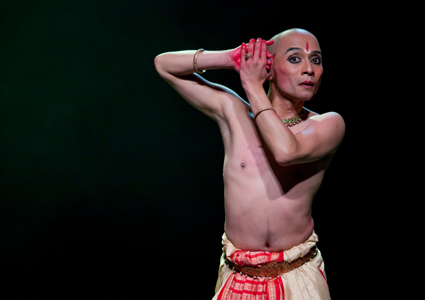
Mavin Khoo, Devi in Absolution
courtesy Parramasala
Mavin Khoo, Devi in Absolution
parramasala
Artistic Director Philip Rolfe says this year’s Parramasala festival (October 30-November 6) will be “bigger and more diverse than the inaugural festival last year. We have some of the world’s most renowned international artists presenting a number of Australian exclusives right in the heart of the city of Parramatta…You have the chance to enjoy the cultural richness of a region of the world that is becoming more important to us and our futures. What you experience is also indicative of the transforming nature of Australia and the embracing of more diversity. The arts on show at Parramasala are as important to modern Australia as those from our Anglo-Celtic and European heritages” (Media Release).
The central city precinct around Town Hall and St John’s Cathedral Square and the Riverside Theatres precinct will be focal points for the festival, featuring a free outdoor stage, daily Masala markets (performances among bustling food stalls). Works will appear in a variety of performance, film and exhibition venues. The festival includes the six-day South-Asian Film in Focus, a program of independent film (“beyond the glitzy world of Bollywood”) including free documentaries at lunchtime, premiere features in the evening and a retrospective of the work of master filmmaker Satyajit Ray. In fact, film is a common theme of this year’s festival with many of the live productions having screen components. Mother India 21st Century Remix by English company Kala Phool sees the three-hour classic edited to 45 minutes and re-scored with a live band featuring UK turntablist DJ Tigerstyle. In another event entitled Cinema, Karsh Kale “mixes Indian classical and folk with electronica, rock, pop and ambient music—the sound that helped define the club phenomenon of the late 90s dubbed Asian Massive.” Local multimedia group CuriousWorks has been commissioned to create The Other Journey: Leaving Lanka and Becoming A Battler to be presented on the Parramatta River. “Based on stories of recent Sri Lankan refugees, audiences are taken on a moving journey with large-scale outdoor projections, a boat tour and Eastern and Western influenced music, relayed to personal headsets via individual mp3 players.”
As you’d expect in a festival celebrating this region, there’s a fabulous selection of music and dance including percussionist Trilok Gurtu and his band performing in a concert with the young sitar virtuoso Niladri Kumar and David Hykes and the Harmonic Choir performing in St John’s Cathedral and also joining Dr Madan Gopal Singh and Chaar Yaar for a concert combining harmonic sufi and qawwali music. The Chandralekha Group from Chennai will be a highlight of the dance program. “Challenging traditional notions of classical dance in India, Sharira combines contemporary dance with yoga practice, traditional Keralan marital arts and live Dhrupad song and music performed by the world famous Gundecha Brothers, in a stunning, intimate production.” For the many more pleasures to be had see www.parramasala.com. Parramasala, Parramatta. Sydney Oct 30-Nov 6
fiona mcgregor’s water series
“When I see a tap running, unattended, unused, I feel like I am watching someone bleed.” Fiona McGregor’s Water Series is a set of durational performances presented both live and via photography and video. “The works are all generated through the artist’s response to the fundamental substance of water, in a time of environmental strife. This response is in part predicated on proximity—an emotional attachment to the ocean as a coastal dweller. More crucially it is generated by issues surrounding scarcity and usage of fresh water in Australia—especially the issue of salinity—deepened by McGregor’s recent visit to Lake Eyre, across the outback, along the Murray River. An awareness of water as the main component of the human body is consistent across the series, particularly apparent in the endurance elements of the works as the artist enacts extended encounters between water and the body: the body struck by water; the body marked by water; the body consuming liquidity; the body expelling liquidity” (Media Release). Immediately following Water Series, Artspace will present the work of six artists/artist collectives whose practice utilises or examines performance and live action; Nothing Like Performance will feature the work of Matthew Bradley, Lauren Brincat, Brown Council, Paul Donald, Will French and Yiorgos Zafiriou. Fiona McGregor, Water Series, Nov 1-20; Nothing Like Performance, Artspace, Sydney Nov 25-Dec 22, www.artspace.org.au
performance space: exchange
Performance Space ends the year with Exchange, a season of five intriguing works that tackle considerable ethical and aesthetic issues by expanding our notions of interactivity, installation and reconciliation. To comment on our compulsive consumerism, Theatre Kantanka, with contemporary music collective Ensemble Offspring, offer a “toxic nightmare in all the colours of the rainbow”, Bargain Garden, “an immersive, multi-sensory performance installation, inspired by the thousands of bargain stores and two-dollar shops that multiply across our cities” (Nov 1-5). In Return to Sender, Paul Gazolla and Jeff Khan have curated a challenging dance program with an impressive range of artists (Alison Currie, Nadia Cusimano, Matthew Day, Atlanta Eke, Jane McKernan, Latai Taumoepeau, Tony Yap and Yumi Umiumare) devising “works that recreate the choreography, score, or essence of an international peer’s work.” Media artists Michele Barker and Anna Munster’s new interactive artwork Hokus Pokus (Nov 3-26), “examines illusionistic and performative aspects of magic to explore human perception, senses and movement” within the framework of 19th century magic, early cinema and traveling science shows.” Helen Pynor and Peta Clancy’s installation, The Body is a Big Place (Nov 3-26), “explores the fluidity of boundaries between bodies, specifically questions arising from the processes and practices of organ transplantation surgery, and research into the complex phenomenological responses reported by organ transplant recipients.”
My Darling Patricia (see page review of Africa) in collaboration with Indigenous artists from Moogahlin Performing Arts will present their much anticipated Posts in the Paddock (Nov 9-19), a performance and installation drawing on the fact that 111 years ago relatives of company member Clare Britton were murdered in the Hunter Valley by the Aboriginal Bushranger, Jimmy Governor (the subject of Tom Kenneally’s novel, The Chant of Jimmie Blacksmith and Fred Schepisi’s film). The artists offer the work as “an intimate and ultimately very personal work of reconciliation.” Performance Space, CarriageWorks, Sydney, www.performancespace.com.au
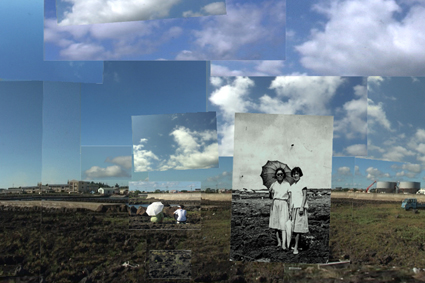
OH, Yong-Seok, cross, single channel, 5 min, 2002
gold coast art gallery: korean re-imaginings of the city
Following the impressive Now and When exhibition (RT103), Gold Coast City Art Gallery is hosting an exhibition from the Seoul Museum of Art presented as part of the Korea-Australia Year of Friendship in response to Australia: Digital Urban Portraits. Drawn primarily from the SeMA collection, in this exhibition artists consider urban space as not materialistically composed of buildings, but inseparable from the environment, continually accumulating historic events. The artists in the exhibition imaginatively transform the urban environment. Korea-Australia Exchange Exhibition: Re-imagining the City, Contemporary Korean Media Art about Cities and Change, Gold Coast City Art Gallery, Nov 5-Dec 11, www.theartscentregc.com.au/art-gallery/coming-soon.php
RealTime issue #105 Oct-Nov 2011 pg. 48
© RealTime ; for permission to reproduce apply to realtime@realtimearts.net
The Government’s National Cultural Policy Discussion Paper appears to cover all bases: the “core” arts (or “cultural industries”), the creative industries, Indigenous arts, innovation, young artists and audiences, new technologies (including the role of the National Broadband Network), arts education in schools and a National Arts Curriculum, reviews of private sector support and of the Major Performing Arts sector, a creative industries strategy, a national design policy, a review of the National Classification scheme and more. Some of the reviews are already under way, including a Convergence review “examining the policy and regulatory frameworks that apply to the converged media and communications landscape in Australia.” There’s an overriding desire for inclusivity, “to bring the arts and creative industries into the mainstream of Australian life,” to create careers and increase innovation and productivity. There’s also a desire for a “whole-of-government” approach, not least for the creative industries and Indigenous arts. The paper’s data on the current productivity in the arts and creative industries clearly suggests that further government investment (current investment is also very clearly delineated) would be even more beneficial for the Australian economy. The Discussion Paper is nothing less than ambitious if all its goals were to be realised. Only once, I think, is a 10-year time framework mentioned. Much will depend on the outcomes of the public discussion, the stripe of the governments in power over the next decade and the strength of the National Cultural Policy itself, if it’s to be more than a motherhood statement. You can read the Discussion Paper at http://culture.arts.gov.au/ and make submissions online or by email (culturalpolicy@pmc.gov.au) until October 21. The paper is well worth reading: it warrants your contribution to a critical discussion.
RealTime issue #105 Oct-Nov 2011 pg. 2
© Keith Gallasch; for permission to reproduce apply to realtime@realtimearts.net
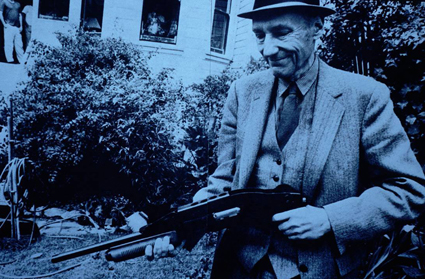
William S. Burroughs—A Man Within
THIS YEAR’S SYDNEY UNDERGROUND FILM FESTIVAL OFFERED AN EXCELLENT LINE-UP OF PROVOCATIVE FILMS SPANNING DOCUMENTARY, SEXPLOITATION, SPOOF, HORROR, ANIMATION AND THE EXPERIMENTAL, WITH PLENTY OF CROSSOVER BETWEEN GENRES.
An outsider theme permeated many of the features on show. From Yony Leyser’s documentary portrait of William S. Burroughs, experimental filmmakers in Free Radicals, through to the transformative relationship of The Ballad Of Genesis and Lady Jaye and the studies of prostitution in Guilty of Romance, X and Profane, there was a sense of filmmakers wanting to explore unorthodox lives.
william s burroughs: a man within
The perennially cool William S. Burroughs loomed large over the festival. In creating his portrait of the conflicted, crazily influential iconoclast, Yony Leyser presents a multitude of interviews with those touched by Burroughs: fellow Beatniks, ex-boyfriends, biographers, artists, filmmakers, including John Waters and Gus Van Sant, and punk rockers Patti Smith, Iggy Pop and members of Sonic Youth and The Ramones. Recently released archival footage shows Burroughs reminiscing with Allen Ginsberg about the Beat movement. A beautifully textured soundtrack contributed by various punk luminaries and Morocco’s Musicians of Jajouka is often overlaid with Burroughs intoning typically searing lines.
Though there are a few anecdotes about his youth, the documentary devotes itself largely to the years following Burroughs’ emergence as a writer, dating roughly from the awful incident in 1951 when he killed his wife, Joan Vollmer. Given Burroughs’ incredible cultural reach (Laurie Anderson notes, “William seemed to have a connection with anything and everything”), a picture emerges not only of the man, but of the second half of the 20th century, an era defined by a series of radical changes—manifest in the Beat Generation, queer activism, Punk—steered in some way by Burroughs.
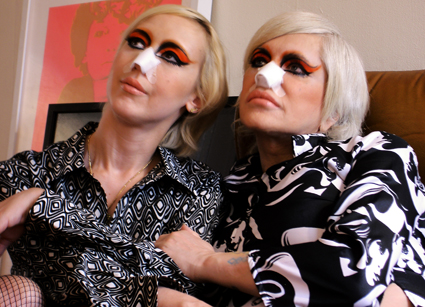
The Ballad of Genesis and Lady Jaye
the ballad of genesis and lady jaye
Genesis Breyer P-Orridge—performance artist, Punk musician—was mentored by Burroughs and appears in Leyser’s documentary. Another of his mentors, Burroughs collaborator Brion Gysin, invented the ‘cut-up’ method (adopted by Burroughs) where pages of type were scissored and aligned to form unexpected new meanings. This method influences the unconventional relationship at the heart of Marie Losier’s intimate documentary, The Ballad of Genesis and Lady Jaye. “When you’re madly in love with someone,” P-Orridge proffers, “you want to consume each other…not be individuals any more.” He and his wife, performance artist Lady Jaye, embarked on a project to become as physically alike as possible through various measures, including cosmetic surgery, cutting and recombining themselves à la Gysin in order to create a “third entity”—the Pandrogyne.
P-Orridge dominates the documentary. It’s packed with his whimsical utterings; performances old and new; footage of his seminal industrial band Throbbing Gristle and the more recent Psychic TV; and personal anecdotes, including one of being violently bullied as a schoolboy. Lady Jaye in contrast remains something of an enigma. The pastel-infused cosiness characterising the film is tempered by a revelation towards the end, making it as much requiem as frothy documentation of an off-beat love.
free radicals
Pip Chodorov, thanks to his director father Stephan, was steeped in experimental film from childhood. He presents an engaging, often humorous celebration of the subject in Free Radicals. The title, taken from a 1958 four-minute animation by New Zealand born artist Len Lye, perfectly encapsulates the defining philosophy of experimental film as Chodorov sees it—absolute freedom from rules in a radical reaction against conventional realist cinema. Lye’s animation is one of many experimental works played throughout the documentary, which charts the movement’s growth from early post-WWI Dadaist stages to a blossoming in 60s and 70s counter-cultural America. Chodorov conducts laid-back interviews with leading practitioners including Peter Kubelka, Jonas Mekas, Maurice Lemaître, Nam June Paik and Ken Jacobs. There’s also footage of pioneers, the late Hans Richter and Stan Brakhage (who coined the term ‘underground cinema’). Chodorov’s infectious enthusiasm should swell the ranks of budding experimental filmmakers everywhere.
tomie unlimited
No underground film festival is complete without something twisted from the horror genre, and SUFF didn’t disappoint in this regard, showing former Troma director Trent Haaga’s Chop alongside Japanese shockers Helldriver and Tomie Unlimited. The latest of several films based on Junji Ito’s Tomie manga series, Tomie Unlimited (Noboru Iguchi, 2011), centres on Tomie (Miu Nakamura), a vengeful schoolgirl who, as the title suggests, cannot be destroyed, but keeps cropping up in an assortment of ever more bizarre and repulsive manifestations, with the primary aim of tormenting her younger sister Tsukiko (Moe Arai). Tomie often relies on displacement, a standard horror technique which has things appearing where they don’t belong: identical miniature heads in a school lunchbox, for example, or a dead schoolgirl returning to the bosom of her family.
While Tomie Unlimited might begin in a (relatively) restrained manner, it certainly doesn’t finish that way. As with the magnificently off-the-wall Helldriver, whose director Yoshihiro Nishimura created Tomie’s special effects, this fim’s horror is ultimately about excess; though bizarre, it’s not aiming at profundity. Both films are fabulously inventive when it comes to the sheer variety of mutations they present, something that’s led to comparisons with David Cronenberg’s body horror. To some extent the comparison holds, but Tomie replaces the Canadian director’s broader social anxiety with the intimate jealousies and injustices lurking within a schoolgirl’s network of relationships.
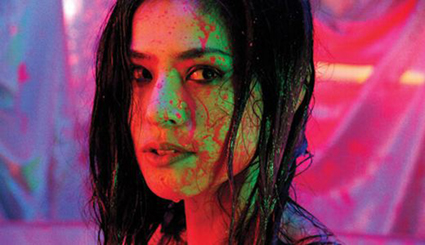
Guilty of Romance
guilty of romance
If a Burroughs thread ran through the festival, so did one of prostitution, evidenced in films like Usama Alshaibi’s Profane (which promised an intriguing discourse on the collision between Islam and sex work, but failed to deliver), Australian thriller X and Sion Sono’s Guilty of Romance (2011), which opens with a gruesome murder in a Tokyo ‘Love Hotel’ district. Travelling back in time, Guilty Of Romance follows Izumi (Megumi Kagurazaka), a young woman missing since the murder. Through a series of chance events, Izumi, who is caught in a subservient, sexless marriage, finds herself turning from glamour modelling to casual sex then prostitution. She discovers a mentor of sorts in Mitsuko Ozawa (Makoto Togashi), a literature professor/streetwalker who drops references to Kafka’s The Castle and seems to view prostitution as the ultimate act of bodily actualisation.
Dark and richly detailed, in some ways recalling Buñuel’s Belle de Jour (1967), Guilty of Romance presents a woman in search of her own sexual degradation. There’s an interesting existential element to the film’s ruminations on female sexuality, somewhat undermined by the titillating depiction of some fairly demeaning encounters (and a certain double standard when it comes to male versus female nudity). It’s complex enough however to make for a problematic but absorbing meditation on the failure of romantic ideals (as symbolised for the protagonists by Kafka’s unattainable castle).
x
The Australian film X, like Guilty of Romance, is a thriller focused on female prostitutes: one seasoned; one neophyte, but there the comparison ends. X’s depiction of the sex trade is anything but titillating. As much character study and geographic portrait as thriller, writer-director John Hewitt and co-writer Belinda McClory’s film concentrates on a night when the lives of two prostitutes intersect in Sydney’s Kings Cross. After witnessing their drug-dealing client’s murder, Holly (Viva Bianca), a successful call girl on the brink of retirement, and Shay (Hanna Mangan-Lawrence), a teenage newcomer to the sex trade, suddenly find themselves on the run. Fear, a natural component of any thriller, drives the film at this point, insinuating itself into the landscape. “RUN,” reads graffiti on a wall. “NOW,” shrieks a hairdresser’s sign. As the characters tear along Darlinghurst laneways or traverse the lurid stretch of William Street, an impression of the Cross’s predatory nature builds—this is a place that won’t let people escape.
Hewitt broadcasts Sydney’s identity throughout the film, using the city’s bright lights and glittering skyline to highlight his protagonists’ gradually shattered aspirations. While the thriller format slightly reduces X’s realism, Bianca and Mangan-Lawrence give deeply convincing performances, and the end of the film echoes Midnight Cowboy (1969), another account where a character’s circumstances prevent the realisation of a dream escape.
2011 Sydney Underground Film Festival, Factory Theatre, Sydney Sept 8-11
RealTime issue #105 Oct-Nov 2011 pg. 23
© Katerina Sakkas; for permission to reproduce apply to realtime@realtimearts.net
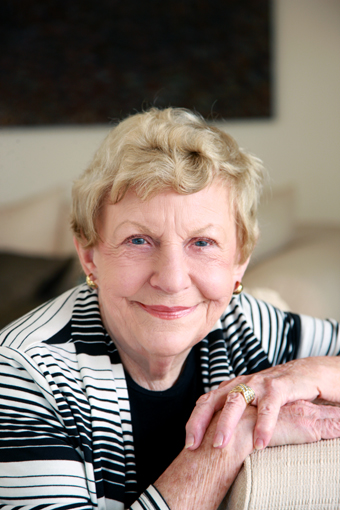
Wendy Blacklock
photo Belinda Mason
Wendy Blacklock
“GIVE ME AN OVERVIEW OF THE ORIGINS OF THE KEY WORKS PERFORMING LINES HAS TOURED?” WAS ONE OF THE FIRST QUESTIONS FENN GORDON ASKED HER PREDECESSOR, WENDY BLACKLOCK, WHEN SHE ASSUMED OFFICE AS CEO OF PERFORMING LINES.
Gordon had formerly worked at Performing Lines for a year as she progressed from being seconded by Creative New Zealand to becoming a major player in the Australian performing arts scene as Director of Market Development for the Australia Council for the Arts. Blacklock’s extensive arts knowledge says much about her legendary capacity to ensure that every aspect of this complex little organisation’s business passed across her desk during the 30 years of her dominion there.
Indeed, when she talked after her ‘retirement’ about the growth of Performing Lines from its earliest existence as the Australian Content Department of the Australian Elizabethan Theatre Trust (AETT)—which Blacklock started with just one associate, Trish Solomons—to today’s team of seven producers, an accountant and a part-time marketing expert, touring 16 productions in 2010 to 64 venues from Cairns Centre of Contemporary Art to the Venice Biennale via Sydney, Melbourne and Flinders Island, Blacklock let it be known, “Of course I checked all the budgets myself—my father was an entrepreneur!”.
Few would have guessed it; Blacklock’s early life acting the dumb blonde in myriad stage and TV productions led many to assume that the persona was reality. But from the first days of Australian Content in 1981, she put the commercial completely behind her to nurture the experimental, the cross-artform, the Indigenous and the multicultural. And fellow performers with ambitions in these directions were comfortable opening up to her about their dreams.
So Aboriginal actor Brian Syron brought playwright Robert Merritt to her office in the AETT rabbit warren with his play, The Cake Man, which had already had a couple of fringe productions in Sydney and been filmed for the ABC. Where else could it go? Well, it so happened that Blacklock was looking for something to send to the World Theatre Festival in Denver on behalf of the AETT. And most shows it did then weren’t Australian. With some lateral thought about funding sources such as the Aboriginal Affairs Department, the show did go on.
That ‘Where else could it go?’ question was a constant in Blacklock’s mind. The only way small performing companies could survive, she believed, was to be given the maximum encouragement to create well—preferably involving Blacklock herself in the rehearsal room—and then tour as long as there was a market for them. “The Australia Council [her major funder] sent in a consultant once,” she recalls, “asking why we were operating overseas? They thought it was a distraction. But I said, ‘You funded the show, we toured it and now it’s ready for the world. It’s a logical progression.’ And they eventually realised it themselves, setting up the Performing Arts Markets to encourage international sales.
“But back then, we were on our own. There was no Playing Australia, Mobile States or Sound Travellers, no subsidy for tours, no association of venue managers like APACA [Australian Performing Arts Centres Association], no Long Paddock, and no Roadworks group of 11 really adventurous regional art centres” who today entrust Performing Lines to send them two shows a year by companies like Force Majeure or Red Stitch in 2010. And yet somehow, back in the 90s, Performing Lines managed to extend the lives of productions by such companies as Human Veins, One Extra, Entr’Acte, the Sydney Front and even Open City—the performance company that became the publisher of this magazine.
And that Indigenous strength—which has today lead to the Sydney Festival putting Blacklock (so much for retirement!) in charge of I Am Eora, a major commission for next January and to Performing Lines being appointed by the Australia Council to establish and manage a new National Indigenous Touring Consortium—grew from two things. Firstly, there was Blacklock’s enquiring mind which asked, “What else is there about?” after The Cake Man. She soon found Jack Davis’ The Dreamers in Perth, and sent it off on a 17-week East Coast tour; then went on to commission Uncle Jack to write the children’s play Honey Spot, which is still running, as well as No Sugar, which would end up in London.
Secondly, there was Blacklock’s determination to make her project truly national. “We needed to know what Tasmania, West Australia and the Northern Territory were doing—not just send them stuff that was ‘good enough for Sydney and Melbourne, so it must be good enough for them.’ Such an egocentric view! The ethos can be so different. Take Tassie—it was so tough there, many artists had left for the mainland, meaning audiences had no experience of local shows. It took us four years to reverse that by a two-way process of touring national shows in and Tasmanian shows out.”
One of Performing Line’s seven producers is Annette Downs, based in Tasmania, who works with independent artists and companies, matching emerging artists with mentors, advising on appropriate artists for projects, linking Tasmanian producers with national and international touring opportunities and developing networks and support for regional touring. Funds come from Arts Tasmania. Similarly in WA, producers Fiona da Garis and Rachael Whitworth work with five core companies/artists, but occasionally produce projects for other independent dance and theatre artists. They’ve included dancer Aimee Smith, who’s quoted on the Performing Lines’ website as saying, “I never want to self produce again.”
And then there’s MAPS in NSW with producer Viv Rosman—a joint State and Australia Council venture with Performing Lines offering management and producing services, plus touring, to three dance and three theatre companies. “Producers are fashionable today,” relishes the woman who trained up names like Wendy Martin for the Sydney Opera House (now at Southbank, London) and Karen Rodgers now with Force Majeure. “Even the Australia Council has recognised that artists can’t exist in a vacuum.”
And even a Duracell dynamo like Blacklock learnt to share her own vacuum. With the advent of triennial funding, now at $350,000 a year to create a box office risk-free turnover of almost $4 million; with the Major Festivals Initiative asking Performing Lines to take on big shows such as The Theft of Sita [2000, director Nigel Jamieson, composer Paul Grabowsky and Indonesian artists] and Three Furies [2005, writer Stephen Sewell, director Jim Sharman]; plus those ongoing deals with the States, Performing Lines needed others with experience to share the load. In came Harley Stumm, fresh from rescuing Legs on the Wall, and John Baylis, with extensive experience in touring programs at the Australia Council. “Performing Lines needs a range of skills…you really do have to like contemporary dance to produce it. And Harley loves performance art, while I was always a script person.”
“Creating new work on limited sums of money is hairy,” Wendy Blacklock concludes. “Limiting the risk requires attention to detail. But most of all, good producers need to love the artists.”
Wendy Blacklock, founder and former General Manager of Performing Lines, has been recognised with many awards, including an Order of Australia, Helpmann’s JC Williamson Award, a Drovers’ Touring Legend Award from APACA, and a Sydney Theatre Award for Lifetime Achievement. Her contribution has been honoured in the recently installed Theatre Walk at Walsh Bay, Sydney. Detailed accounts of Blacklock’s earlier career can be find at www.liveperformance.com.au/halloffame/wendyblacklock1.html and elsewhere online. For more about Performing Lines, go to www.performinglines.org.au.
RealTime issue #105 Oct-Nov 2011 pg. 8
© Jeremy Eccles; for permission to reproduce apply to realtime@realtimearts.net
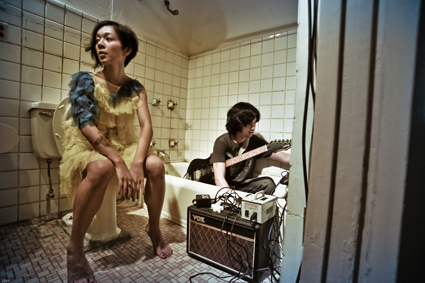
Donna Miranda, Pow Martinez, Of Course Not, This is a Bathtub
photo Sam Kiyoumarsi
Donna Miranda, Pow Martinez, Of Course Not, This is a Bathtub
AFTER A HIATUS DUE TO HER SECOND PREGNANCY, CONTEMPORARY DANCE ARTIST DONNA MIRANDA LOOKS FORWARD TO A BACK-TO-BACK THREE-WEEK RESIDENCY AND 10-DAY WORKSHOP IN AUSTRALIA. SHE IS ESPECIALLY INTERESTED IN WORKING WITH SYDNEY-BASED DANCERS AT THE CAMPBELLTOWN ARTS CENTRE, WHERE THEY EXPECT TO EXPLORE COLLABORATIVE INCLINATIONS AND RELATIONSHIPS BETWEEN INDEPENDENT ARTISTS.
Miranda helped combust the independent contemporary dance movement in the Philippines, with platforms such as the Anatomy Projects and the Contemporary Dance Map. In 2005, duos and small groups performed out of their studios and tiny art galleries to audiences sitting on the floor or standing against a wall, with minimal lights and costumes: nothing to distract from the movement on the demarcated performing space. The now-biannual WiFi Body Independent Contemporary Dance Festival is a landmark of the successful establishment of the current burgeoning scene.
It was during a 10-week touring residency in 2005 bringing together eight artists from different parts of the world that Miranda was thrust into collaborative work. The Chasing the Whale project was independently organised and funded, involving young artists mainly from the Asia-Europe Foundation’s (ASEF) Pointe to Point Forum. “We were constantly in the ‘creating’ zone and never managed to finish a work,” she remembers and chuckles, “Hippies.”
The residency occurred in four cities: Bangkok-Manila-Kyoto-Tokyo, where the audiences were “mostly confused. The ‘performances’ were actually open studios; they were about four to six hours long. So, we had certain sections that were set and some that were improvised without time limit. We were confused too, because we still couldn’t let go of ‘performing’ and not just working as [we were] already working.” She also learned to “appreciate constraints as well as deal with not knowing what to do.” The experience resulted in Beneath Polka-dotted Skies, which won the Jury Prize at the 2007 Yokohama Dance Collection R Solo x Duo + and has been performed in the Philippines, Japan and Indonesia.
Miranda’s early experience with the touring residency also generated the creation of another work, Summer Begins and Ends as You Wish, which was first performed at the 2006 WiFi Body Festival. Subtitled as a deconstruction of Vaslav Nijinsky’s L’Apres Midi D’un Faune, the work was first performed in a converted conference room, where Miranda was tied with a red ribbon to a bench. Criticised for being too arrogant and/or lazy to create any real ‘dancing,’ Donna Miranda was disappointed that the creative efforts of her collaborators had gone unnoticed. “That was when I really got into problematising the collaborative condition,” she shares. “What does a collaborative work result in?”
Summer Begins…found Miranda working with artists from other disciplines and resulted in a multimedia work where the ‘dancing’ was projected on the wall behind her as she sat on the bench, smoking. Maria Taniguchi was her visual director, “but you can barely see any of her mark. In fact she was with me throughout the process, while I constructed the solo; she advised me on ‘poses’ that worked and those that did not. All the artistic decisions including taking photos of the solo and re-animating them as a video were collaboratively made.”
The goal was to make one seamless work, instead of an obvious mix put together by several people and Miranda acknowledges that it’s still obvious in Summer Begins…that the sound was coming from somewhere else. Given that, “I’d say that was the beginning.” Noteworthy collaborations followed, including the most ambitious, Of Course Not, This is a Bathtub, where she and sound artist Pow Martinez performedx inside an actual bathroom, with a camera set up inside and hooked to a television in the apartment’s living room, where the audience sat to view the ‘performance.’
Although there’s no definite agenda planned for the Campbelltown residency, Donna Miranda is planning to explore performance scoring in this collaboration. “I’ve been very much interested in writing performance scores, reading scores, making the text in dance more obvious,” she recounts. “About a month or two ago I stumbled on Francisca Reyes-Aquino’s Dance for All Occasions and then it started to dawn on me that ‘Hey, Francisca Reyes-Aquino started it all…’ or that we have a wealth of textual material that just begs for attention.” Aquino is the first National Artist of Dance in the Philippines, acknowledged for creating a notation archive of folk dances from all over the country.
“I want to get to the heart of the matter that contemporariness has in no way anything to do with style,” Miranda expounds. “I choose to work with material that has been tagged as ‘traditional’ but really it’s not. I think Francisca Reyes-Aquino was far ahead of her time and contemporary in the sense that she created text out of the ephemerality of dance. To deal with the materiality of dance, that’s very contemporary. And as someone who is in contemporary practice, there are varied ways to work with ‘traditional’ or ‘folk’ material without having to fuse them together, or even call attention to their ‘Filipino-ness.’
Another project she’s planning is to organise a social dance gathering: “In this work I’m interested in pushing choreography as a practice in organisation and building relationships of bodies, bodies in space, bodies to music, music to space, etc, etc. In this sense, choreography is a practice of building a community and not just putting steps together. In fact in this work I’m not making any steps, any dance steps but merely framing the situation and signing it. Like appropriating.” In Filipino, she says that she was thinking why should she create dance when dance is already there? “Like how inventive in movement vocabulary can one be?”
Laughing, she admits that she may be getting older and is taking stock of her work. “Of course, while I’m saying that I will restrain myself from making dances in the sense of creating a unique vocabulary or voice, that process of appropriation is also in itself ‘a way of making’.”
Donna Miranda is scheduled to visit Australia for a three-week residency at the Campbelltown Arts Centre from October 10. Opportunely, she was also invited by the Goethe Institut to participate in a 10-day Critical Path group residency at Bundanon in regional New South Wales in the second week of November. The workshop will be attended by other choreographers from the region and moderated by Singaporean creative producer, dramaturg and critic Tang Fu Kuen.
Donna Miranda residency with independent Australian dance artists, Dean Walsh, Nikki Heywood, Matt Day, Sam Chester and Alexandra Harrison; performance October 29, 8pm Campbelltown Arts Centre, Sydney, www.campbelltown.nsw.gov.au
RealTime issue #105 Oct-Nov 2011 pg. 12
© Joelle Jacinto; for permission to reproduce apply to realtime@realtimearts.net
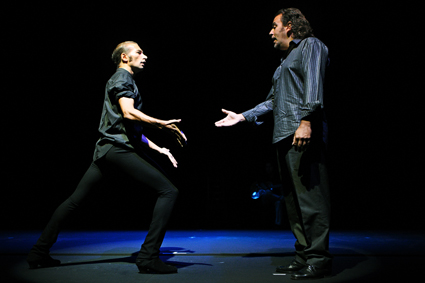
Israel Galván, David Lago, La Edad de Oro (The Golden Age), Spring Dance
photo Prudence Upton
Israel Galván, David Lago, La Edad de Oro (The Golden Age), Spring Dance
SPRING DANCE 2011 PROVED TO BE AN INTIMATE AND ENGAGING MINI-FESTIVAL WITH A CLEAR SENSE OF PURPOSE, IN ITS TRIBUTE TO PINA BAUSCH. UNLIKE MOST INTERNATIONAL ARTS FESTIVALS THESE DAYS WITH THEIR HUGE PROGRAMS, HERE THERE WAS THE LIKELY OPPORTUNITY TO SHARE RESPONSES TO THE WORKS SEEN RATHER THAN BE TOLD HOW REMARKABLE THE SHOW WAS THAT YOU MISSED.
israel galván, la edad de oro
In La Edad de Oro (The Golden Age) Israel Galván firmly invokes the tradition of flamenco dance while transforming it, releasing his body from its taut if vigorous framework to create his own distinctive choreography. Some of this is achieved by expanding the space occupied by the flamenco male dancer, some by taking its stances and gestures (including some usually associated with the female dancer) and extending them to an almost surreal degree while texturing his vocabulary with influences from tap (he’s an admirer of Fred Astaire) to contemporary dance.
The performance by Galván, guitarist Alfredo Lagos and singer David Lagos, comprises a series of solos, duets and trios in various combinations in which, again, tradition is sustained but also transformed to sometimes dramatic, sometimes almost comic effect. An impassioned duet between Galván and the singer is conducted unconventionally at the front of the stage, face to face in an upward spiralling dialogue between body and voice climaxing in a conciliatory handshake. In the good-humoured encore to the show, Galván sings, not particularly well, and plays the guitar, badly, while his fellow artists parody his dancing.
By then, we too, having revelled in a series of dance pieces, have come to recognise Galván’s idiosyncratic movement language. It’s rooted in flamenco with its proud, erect demeanour, but this body is far more angular, falling out of the frame, dipping deep from the knee and unfurling upwards, mutating pounding feet into subtle, musical taps, gliding scrapes and rapid skips, propelling himself, forwards or backwards, across the stage, executing improbable leaps and spins without losing the pulse of tradition. In one piece, he dances with his shadow.
Much of this Galván performs in profile—thus we miss nothing of the detail. There are numerous small touches—the fully extended arm that reaches behind his back so that his hand appears like an alien extension; the conventional tugging of the front of the shirt he extends to sexily reveal his abdomen or turns to magically make the shirt tail vibrate as with a life of its own. His hand clapping extends to slapping various parts of his body, including his face. He vibrates his lips, or holds one eye strangely wide open. Recurrently his right arm snakes up, the hand suspended and drops suddenly, or slowly, like a falling leaf.
In all of this, Galván for the most part (except where solo he makes his own music with his feet and hands) is supported by a fine, expressive tenor and a guitarist who, more Paco de Lucia than Paco Pena, oscillates between traditional playing and seductively inventive, contemporary phrasing. Each artist has their much applauded place in the spotlight. For anyone who thought that flamenco was locked into tradition, here was a remarkable dancer who revealed that without losing its pride, momentum and subtleties, the form can have new life.
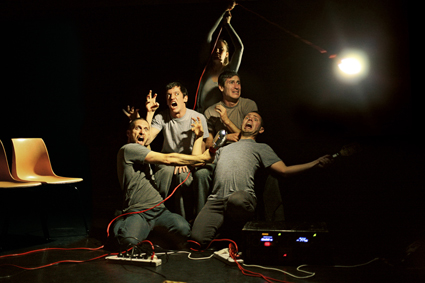
Byron Perry, Joseph Simons, Kristy Ayre, Lee Serle, Antony Hamilton I Like This, Chunky Move
photo Prudence Upton
Byron Perry, Joseph Simons, Kristy Ayre, Lee Serle, Antony Hamilton I Like This, Chunky Move
chunky move, i like this
As we well know by now, dance theatre doesn’t necessarily involve a lot of dancing, such is its ever evolving hybridity. But it still needs the discipline, poise and courage of dancers to make it. Chunky Move’s I Like This, created by Byron Perry and Antony Hamilton, who, with minimal mutterings, themselves manipulate sound and light on the stage in front of and amidst a trio of dancers, play at putting together a performance, constantly reframing the action with brisk blackouts in which the dancers and their chairs and props are rapidly re-arranged, collapsing time with staged jump-cuts.
The work moves from whimsy into grotesque slow-motion dream states; the dancers deftly wielding portable industrial lights, transforming their world; one swings a light in a wide arc, expanding the performance space as the show takes on a cosmic dimension, a reverie in which the performers later appear to pull a planet into their sharing hands. Suddenly remnants of the work’s evolution are shown and dismissed. A film noirish episode haunts the stage. The performers’ world subsequently appears to sink into an ocean of light and sound. The sense of dream escalates until the work’s creators are shrouded by the dancers in a large white sheet to the sound of rain and thunder. Glowing from within, the object appears like a thundercloud, but just as much a brain, from which something like the words “it’s not at all a real ending” are ironically muttered at the work’s conclusion. I Like This is a richly inventive work, adroitly voiced by the dancers and expertly danced where called upon, the overall passage from droll jump-cut minutiae to cosmic reverie only seeming a little short-changed at the end with some all too-easy irony; but it’s that kind of show—pushing hard at the edges of post-modern self-reflexivity.
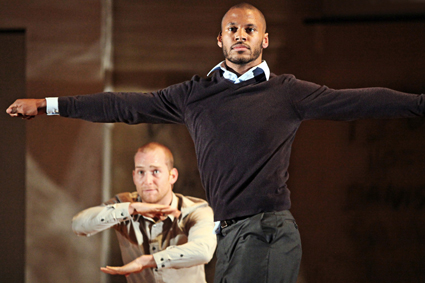
Hannes Langolf, Ira Mandela Siobhan, Can We Talk About This?, DV8, Spring Dance
photo Prudence Upton
Hannes Langolf, Ira Mandela Siobhan, Can We Talk About This?, DV8, Spring Dance
dv8, can we talk about this?
DV8’s Can We Talk About This? is a profoundly provocative dance theatre work in both form and content. Its continuous flow of spoken word and movement (occasionally literally entwined, more often laterally) deals with the ramifications of Islamic migrant culture for Western nations. It is in no way right wing anti-Islamic, nor is its rhetoric left wing. It speaks directly about “the paradox of diversity,” of “multiculturalism losing its intellectual spine,” of “multicultural separatism” and of fear: of being killed, as people were in several countries (the dancers hold photos of the dead which they slowly drop to the floor) over a cartoon that mocked Mohammed; of fear of being labelled racist; of losing “community cohesion”; of being the target of a fatwah—”What can we speak about without being killed—in free countries?” A much more volatile topic in the UK and Europe than here, nonetheless the work resonates with debate within Australia.
Drawn from numerous interviews, the spoken text includes statements from Muslims: a young anti-cartoon protestor in Denmark jailed for four years for merely carrying a placard; a man who spoke regularly at his local mosque until a fatwah was issued over his support of Darwinian theory (he withdraws it later, there is no choice); a young Somalian woman (deliberately near-naked in underwear on stage) who wrote the script of the documentary that resulted in the murder of Theo Van Gogh and suffers guilt for his death; the offending Danish cartoonist standing upside down, trying to function normally, dressing, zipping ‘down’ his fly while his world is inverted.
These brief tellings (they don’t unfold as stories per se) sit side by side with those of a UK school headmaster sacked for alleged racism for being critical of aspects of Islam and the fatwah against Salman Rushdie (“a political turning point”), the continued custom of forced marriages, of girls over the age of 11 not allowed to sing, the promotion of Sharia law and the UN’s refusal, under pressure from Pakistan, to even consider it as a human rights matter, let alone address it. One dancer repeating the words of Anna Cryer, an ex-politician who fought for years to prevent forced marriages, speaks eloquently and quietly about the issue; cup and saucer in hand, she sips tea all the while sitting elegantly on a male dancer (resting on the floor) cradling and shifting her about as if to suggest that, even beneath such calm, support and balance is frighteningly precarious.
What grips is the dancers’ realisation of real voices, real people, while mostly in a constant flux of unusual movement, the greatest sense of which is restless containment, of suppressed violence, of “a paralysis of the West.” The initial dancing is laterally folk-like, as if drawing on the uniformity of clog or hornpipe dancing; elsewhere the dancers break off into opposing groups who intermingle but never reach the point of actual violence; a pro-Rushdie Muslim woman is contained in a circular chase by a man who never catches, but does contain her; people seem locked into duos and trios, while occasionally a solo dancer manages to glide through the potential mayhem.
Meanwhile on two small screens, video images play out, including footage of the huge anti-Rushdie protests and a TV debate where a man asks an Islamic leader, “Would you really kill me as an apostate?”
At the commencement of Can We Talk About This?, a dancer asked for a show of hands: “How many of you feel morally superior to the Taliban?” There was, as far as I could see, a negligible response, a nervous laugh or two—but the provocation had been quietly thrust upon us. At the very end of the work, we were virtually asked if we were in fact afraid and would, consequently, “just shut up.”
Doubtless there will be objections to Can We Talk About This?, not least when it plays in London following a tour after its premiere in Australia. The show directs its complaint at the extremes of Islamic culture that don’t fit with basic human rights, not at its Muslim liberals, its civil moderates. Just as much, it asks us what we will do about those rights, our own and those of Muslims who are oppressed by their own culture. We are so used to the posturing of the right and the shift of liberals to the right in the West that it comes as a welcome shock to be provoked by DV8, by the courage of their multicultural performers and director, Lloyd Newson, by their sheer inventiveness in the equal flow of words and movement, which is at once mesmeric and, in just how they ask us where we stand, utterly disturbing.
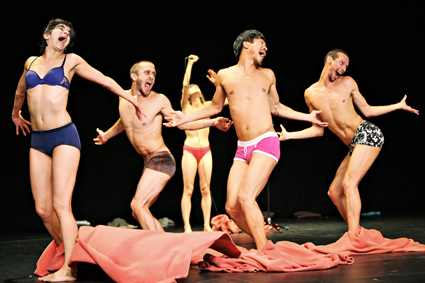
Out of Context—For Pina, Les Ballets C de la B, Spring Dance
photo Prudence Upton
Out of Context—For Pina, Les Ballets C de la B, Spring Dance
les ballets c de la b: out of context—for pina
Les ballets C de la B’s Out of Context— For Pina is a consistently intriguing and exhilarating work, one very different from the company’s work previously seen in Australia where a transport terminal of some kind (La Tristeza Complice) or the top of an apartment building (lets op Bach) have a strong design materiality. Here, the black curtain-framed stage is bare, save for a microphone on a stand, two loudspeakers and a pile of orange blankets. The dancers, it turns out, are seated amongst us and approach the stage one at a time where they undress and wrap themselves in the blankets as if about to commence a yoga class—a scenario which persists in various ways. At other times, in a line, they sway gently like a line of Buddhist monks, forming a physical and sometimes vocal chorus for a solo dancer. However, they are subject to further transformations. As they initially circle each other they commence sniffing, heads leaning into necks, a blend of human and animal accompanied by the grating sound of perhaps a pig—growling and snorting and later intersected with classical piano and further on a soprano voice. In this tribute to the great Pina Bausch, it is as if, as in her own work, anything can happen, here in the shape of enormous shifts from animality to popular to high culture (in the finesse of yoga and exquisite dancing).
The sniffing done, the dancers pick up, virally it seems, a simple swing back of the lower leg from the knee, and then gradually shed their blankets, like snake skins. It’s as if they’ve achieved some strange kind of commonality, short of touching—which comes soon enough. From here on we’re in for a kaleidoscope of images of interaction, often forcing us to choose which simultaneous action to greedily focus on. Look centre and you might easily miss a man consistently collapsing his abdomen with masterful yogic calm.
Elsewhere two men tangle in something like slowed, abstracted Graeco-Roman wrestling, one stretched out on the floor, his weight incredibly pivoted on his head and an arm while his legs splay and his oppressor climbs astride him. A later ‘wrestle’ has, again, two men but squatting side by side, facing us, slowly executing a curious symbiosis, arms entwining, hands manipulating each other’s jaws, becoming one creature. A female dancer executes yoga-based movements with incredible extensions while behind her, facing away, a male performer, microphone in his mouth, growls and grunts and turns adopting a simian pose, lifting the woman onto his shoulders where she becomes chimp-like, squealing into the microphone. Again there is a sense of oneness, of a new multi-limbed body, arms and legs writhing like the goddess Kali.
At other moments the performers are child-like—hands over their loins and tongues protruding—or collectively disabled, battling against a loss of centre of gravity in dance that is once disorienting and beautiful. An extended club dancing passage emerges from a series of single song lines (“No woman no cry,” “I’m calling you,” “that’s the way I like it” etc) but the dancing transforms from predictable to remarkable moves, popular culture elevated beyond belief, and calculatedly tinted with a balletic female duet—if you caught it. There are scenes of adolescent flirtation executed adroitly with comedic relish by a tall female dancer. Rock star posturing manifests from time to time but the play with the microphone—toyed with, slowly lowered, thumped—makes for a different kind of music. Everything is subject to mutation. I was mindful of Ros Warby’s Monumental, which I could not attend in this Spring Dance, but had seen several years ago (RT90) with its enigmatic but magical transformations of the artist from ballerina to bird to soldier.
Into the midst of the relentless action of Out of Context—For Pina steps Lutz Förster, an original member of the Pina Bausch company, suited and performing “The man I love,” first as recitation, then accompanying a recorded version, but all the while signalling the words in Aslan. This affecting “intervention” as the Les ballets C de la B director calls it, was circumstantial, because Förster happened to be in Sydney as a guest of the Goethe-Institut. Elsewhere in the world the intervention will come, says Platel in a Q&A, from other performers or groups or even audience members. What was immediately brought to mind by Förster’s performance is that sense of the artists Bausch employed—distinctive personalities, varied bodies, committed and passionate—and which Platel’s performers likewise embody.
In the end, the dancers fold their blankets, dress and return to their seats among us in the auditorium. We leave the theatre still immersed in the complexities of what it means to be a human animal—from our diverse physiognomies to our desires and our cultural creations. The production’s sense of exploration, spontaneity and passion, unpredictability and sheer purpose and skill, was indeed an apt tribute to Pina Bausch.
Along with two films about Bausch’s work, which showed her at her most charming and good-humoured (given we’ve heard so much about the hard, distant, but nonetheless loved taskmaster), the film tribute to Tanja Liedtke and the foyer exhibition of William Yang’s exquisite photographs of Bausch’s company at the 1982 Adelaide Festival, Spring Dance added up to an exceptional experience. The dance works were quite unlike each other but all revealed intense exploration of form, sometimes with embedded ideas about human nature and creativity, while DV8 made explicit its cultural and political concerns at the same time uniquely energising the relationship between words and movement.
In our December edition you can read interviews with Alain Platel and Israel Galván.
Spring Dance: Israel Galván, La Edad de Oro—The Golden Age, choreographer, dancer Israel Galván, singer David Lagos, guitarist Alfred Lagos), artistic direction Pedro G Romero, lighting Ruben Camacho, sound Félix Vázquez, Playhouse, Aug 23-27; Chunky Move, I Like This, direction, choreography, lighting & sound Antony Hamilton, Byron Perry, performers, Kristy Ayre, Antony Hamilton, Byron Perry, Lee Serle, Joseph Simons, costumes Paula Levis, Studio, Aug 24-28; DV8, Can We Talk About This?, concept, direction Lloyd Newson, choreographer Lloyd Newson with the performers: Joy Constantinides, Lee Davern, Kim-Jomi Fischer, Ermira Goro, Hannes Langolf, Samir M’Kireh, Christina May, Seeta Patel, Anwar Russell, Ira Manela Siobhan, design Anna Fleischle, lighting Beky Stoddart, video artist Tim Reid; Drama Theatre, Aug 25-28; Les Ballets C de la B, Out of Context—For Pina, dancer-devisers Elie Tass, Emile Josse/Quan Bui Ngoc, Hyo Seung Ye, Kaori Ito, Mathieu Desseigne Ravel, Mélanie Lomoff, concept,direction Alain Platel, dramaturgy Hildegard De Vuyst, lighting Carlo Bourguignon, sound design & electronic music Sam Serruys, costumes Dorine Demuynck, Drama Theatre, Aug 30-Sept 1; Pina Bausch (2006), director Anne Linsel, Sept 2; Life in Movement (2011), a documentary on Tanja Liedtke, producer-directors Bryan Mason, Sophie Hyde, Sept 3; Dancing Dreams (2009), director Anne Linsel, Sept 3; Spring Dance 2011, artistic director Wendy Martin, Sydney Opera House, Aug 23-Sept 4
RealTime issue #105 Oct-Nov 2011 pg. 14-15
© Keith Gallasch; for permission to reproduce apply to realtime@realtimearts.net
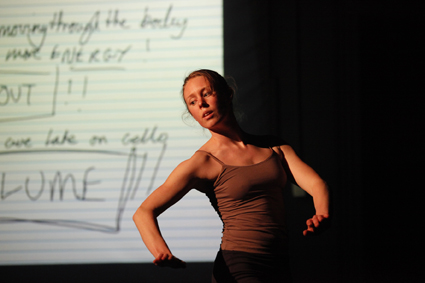
Rebecca Jensen, Document
photo Rachel Roberts
Rebecca Jensen, Document
JACQUES DERRIDA FAMOUSLY CRITICISED THE IDEA THAT WRITING MERELY RECORDS THE SPOKEN WORD. WRITING, HE ARGUED, IS A FORCE UNTO ITSELF. IT DOES NOT PLAY SECOND FIDDLE TO ANOTHER MEDIUM SUCH AS SPEECH. WHAT CAN WE SAY ABOUT DANCE THEN? WHAT KIND OF TRACE DOES THE WORK OF DANCE LEAVE AND UPON WHAT KIND OF SURFACE?
While the body is the central medium of dance, there have over the years been many other modes of recording dance, including writing, painting, photography, film and video. And yet, US theorist Peggy Phelan argues that performance is ephemeral, that it cannot be saved, recorded or documented. These two tendencies, the preservation of the trace and the disappearance of performance are both negotiated in Sandra Parker’s latest work, Document, which investigates the capture of the trace.
In this instance, document is a verb—to document—an activity that aims to create rather than simply capture. Parker’s Document is a process, the pursuit of a question. The performance outcome of her three-month spell at Dancehouse as Housemate either presumes that performance is more than ephemeral (contra Phelan) or includes the audience within its question and leaves the answer open. I like to think it is the latter.
In any case, a performance occurs. Some would say this is proof that Phelan is right: old work can only generate new work, breeding a difference in kind, another animal. And yet, time isn’t quite so linear. The room is set up like a rehearsal space. Three women flank the space (Gwen Holmberg-Gilchrist, Rose Connors Dance, Sandra Parker). They manage the space, its lighting states and, more ambiguously (Parker on laptop), its conditions of emergence.
The experience (but not the story) begins with the usual studio sweep. Dancer Rebecca Jensen sketches a few vague moves then departs. The moment stills. Jensen re-enters the space. She evokes a cultivated elegance, shoulders slightly drawn in towards the back. The flip side is a sternum that speaks out, a demeanour that whispers of ballet gone by. A series of movement assays, stop-start, the dancer is sorting something out; for herself, for us, but also for Parker.
A lined page is projected onto a whiteboard. Instructions appear. The writing performs itself, quite beautiful. Jensen dances, her actions coupled to these instructions. We read her dancing as we read the image of the words. There is something distal in this dancing, as if it all began from the outside and is slowly permeating the core. The spine is secondary, the limbs primary.
Upon reflection, and in light of the process, I am not surprised. Rebecca Jensen is a young dancer who has not worked with Parker before. In the creation of Document, Parker drew in several dancers with extensive experience of her work: Carlee Mellow, Jo Lloyd, Deanne Butterworth and Annabelle Balharry. All came in to share body memories. Jensen’s task was to pick up these memories, mediated through language, and adapt them to her own body. Little wonder then that this external source seeps in from the edges. By the end of Document, this is less apparent, Jensen’s corporeal sense of authorship is more internally derived and less peripheral. She maintains concentration throughout.
The movements performed are a form of condensation or translation. They are excerpts, tops and tails perhaps, or temporal markers of particular moments. We see a dancer quite absorbed in these actions. Visually, the whiteboard pursues its own graphic logic, though it’s clear that these marks represent choreographic authority. Jensen repeats an action down a numbered list of suggested qualities and instructions such as ‘indecision’ and ‘turn away.’ Next, the board shows a rectangle with crosses and lines. Jensen performs truncated actions, at differing heights. Small falls bridge the gaps.
Time zones ultimately converge. The time code on the board brings the performance into the moment and to a close. What is this time code? Is it the time of performance, 40 odd minutes of work and image? Or does it include times past? Document draws in the corporeal past to create something new out of the old. It is a device, a mechanism of innovation. But it aims for more than that. The very reference to something other within this new iteration suggests a certain ambiguity around what it is that we are watching. The intensity of the three women on the sidelines, the variety of graphic logics, the palpable challenges facing Jensen, suggest a complexity beyond the skin of the present moment.
If time is more than a perspective taken, then it may well be possible to open it up to further exploration, to loop back and forth. Document plays between modes of appearance, graphic and kinaesthetic. As performance, it’s very cool jazz. The room is a laboratory but the outcome is aesthetic. This has bearing upon its evaluation, whether the work is an exploration, an artwork or a form of time travel. In any case, the result is a provocation to think, a perception of time beyond the linear.
Document, choreographer, director Sandra Parker, dancer Rebecca Jensen, projection design Rhian Hinkley, lighting Jenny Hector, sound: Steve Heather, James Wilkinson; Dancehouse, Melbourne, July 27-31
RealTime issue #105 Oct-Nov 2011 pg. 16
© Philipa Rothfield; for permission to reproduce apply to realtime@realtimearts.net
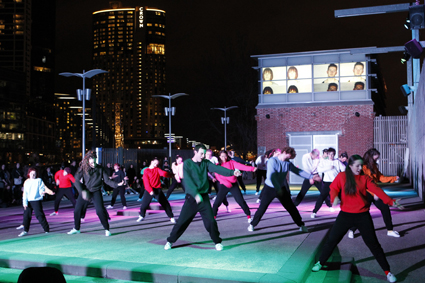
It Sounds Silly, Chunky Move
photo Jeff Busby
It Sounds Silly, Chunky Move
ADAM WHEELER’S IT SOUNDS SILLY IS THE FOURTH PRODUCTION IN THE NEXT MOVE, A SERIES OF DANCE PERFORMANCES BY YOUNG CHOREOGRAPHERS, COMMISSIONED AND PRODUCED BY CHUNKY MOVE. AFTER BYRON PERRY AND ANTHONY HAMILTON’S I LIKE THIS (RT89), MICHELLE HEAVEN’S DISAGREEABLE OBJECT (RT103), AND STEPHANIE LAKE’S MIX TAPE (RT99), HERE IS ANOTHER SHORT, DRAMATURGICALLY MODEST WORK.
Next Move productions have so far all been different sorts of ‘dance in a box’ products, armed with extraordinary clarity of vision and purpose, as such being useful as mini dance primers. Positioning It Sounds Silly outdoors, on an important pedestrian nexus point adjacent to Melbourne’s Flinders Street Station, not exceedingly past the peak hour, was therefore a constructive intervention. At its primary level, it made It Sounds Silly work as a particularly astute piece of public art, one that presented a resplendent image of Australian youth back to its people. For every dozen spectators rugged up in the ad-hoc auditorium, there clearly to support a son or daughter performing, at least two office workers or urban joggers stopped in their tracks or looked momentarily over their shoulders, entranced. Robin Fox’s large-scale video installation, Benjamin Cisterne’s equally elaborate lighting and the tangible charm of the 28 young dancers constituted a spectacle that combined simplicity, beauty and innocence as well as sense of community and purpose—as if the city had acquired a very well behaved, underage, open-air disco.
Using as its starting point the dancers’ childhoods, It Sounds Silly builds as a series of images of the strange things the performers believed when they were young. It quickly progresses from humorous (“when I was little, I ate a lot of cheese, because I thought it would make my voice more squeaky”) to linger on the frightening. At one memorable point, the dancers line up from the oldest to the youngest, each introducing themselves and one of their fears. The fear line-up changed between performances, reflecting the dancers’ momentary preoccupations, but a clear pattern was nonetheless established: quick descent from fully formed relationship and identity anxieties of the 20-somethings to more inchoate fears of the younger kids—falling, social embarrassment, monsters under the bed, right down to marrying a woman named Helen if one’s surname is Pellin.
The degree of metaphor varies, from mime-like literalisation, via swaying monsters built of clusters of dancers, to complex compositions teetering on formlessness, in which phantasmagorias of childhood are represented as half-image, half-mood. The latter are the most successful: in their labyrinthine, repetitive, playgroundish, unsurveyable synchronicity, they managed to simultaneously evoke the work of two Flemish masters: Brueghel’s ethnographic figuration and Bosch’s conceptual fantasies. Close up, these semi-trained dancers perform with physical elasticity, imprecision and undeniable freshness—they are predominantly interesting as bodies with strong, unschooled presence. However, from further away, it is possible to appreciate the large-scale intelligence of the stage imagery, and the performance reveals that, just like Bosch’s The Garden of Earthly Delights, it is much more than a mere jumble of intriguing detail. Wheeler’s choreography, respectful of the disorientation in time and space native to a child’s worldview, adopts composition rules that are thus properly pre-Copernican.
A certain kind of framing is crucial to the enjoyment of this work. While It Sounds Silly is hardly groundbreaking, it is coherently conceived, intelligently plotted and courageously executed. As a work based on the physical and mental qualities of its young performers, it is rigorously truthful to its material.
Chunky Move, Next Move & SIGNAL: It Sounds Silly, director, choreographer Adam Wheeler, multimedia designer Robin Fox, lighting Benjamin Cisterne, sound Alisdair Macindoe, costumes Benjamin Hancock, SIGNAL, Flinders Walk, Melbourne, August 19-20
RealTime issue #105 Oct-Nov 2011 pg. 16
© Jana Perkovic; for permission to reproduce apply to realtime@realtimearts.net
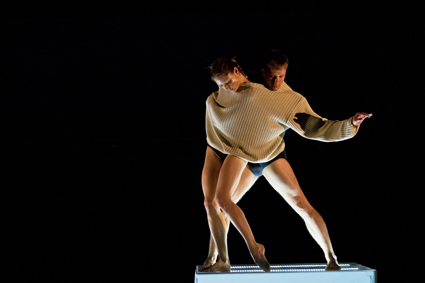
Side to One, Lisa Griffiths, Craig Bary
photo Chris Herzfeld
Side to One, Lisa Griffiths, Craig Bary
THE LAST COUPLE OF YEARS HAS SEEN THE EMERGENCE OF A NEW BREED OF AUSTRALIAN CHOREOGRAPHERS, ALL OF WHOM HAVE HAD OR ARE CONTINUING TO HAVE DISTINGUISHED CAREERS AS DANCERS, WORKING WITH SOME OF THE COUNTRY’S LEADING CONTEMPORARY DANCE COMPANIES AND CHOREOGRAPHERS.
Like Tanja Liedtke and Shaun Parker before them, it is now Anton, Daniel Jaber, Alisdair Macindoe, Larissa McGowan and Gabrielle Nankivell (see page 36) who are finding their own artistic voices—often creating works for tertiary students first but eventually presenting pieces with dancers of their own choosing.
Recently it was Craig Bary’s and Lisa Griffiths’ turn to make their choreographic debut together. Their duet Side To One premiered to critical and popular acclaim at Adelaide’s Space Theatre in July followed by an equally successful season at Riverside Theatres in Parramatta. Created in close collaboration with Adam Synnott in the role of sound and interactive designer, the piece is a highly polished dance media creation, exploring the idea of ‘soul mates’ and the interplay of human connection.
In conversation with Bary and Griffiths, it is easy to see why the soul mate concept would have appealed to them. Having been friends and colleagues for many years, they share the kind of familiarity that allows them to finish each other’s sentences without noticing. It is no surprise then to hear that ever since they first worked together at Tasdance in 2002, choreographers remarked upon their strong compatibility as dancing partners. Numerous duets were created for them as a result.
In 2006, Bary and Griffiths decided to take matters into their own hands and undertook a research residency at Critical Path, being mentored by choreographer Sue Healey with whom they have an ongoing working relationship. The idea of making a work together couldn’t have been further from their minds then. “We actually never thought we’d get to that stage,” laughs Griffiths. “The first residency was just about Craig and I exploring our partnering skills and researching how our life friendship translates through into our partnering in dance and how we feel there is a very strong link in that trust.” Bary agrees: “We had been dancing together for so long that we managed to develop an instinctual way of communicating with each other, where you can just know what the other person is physically feeling or even emotionally feeling sometimes. So we went in, exploring how we could use that in making movement.”
Their original point of departure was to investigate how they could move as one, how to make themselves one person. And it was during that initial research, notes Griffiths, that they bought an oversized jumper from an op shop, meant “as an additional layer of skin”, which ended up featuring prominently in the final work. The idea to confine their stage area to a white box with a Perspex top that could be lit from underneath also originated during that initial research phase.
Buoyed by both their findings and the fun they had experimenting together outside their usual work environment, Bary and Griffiths continued to seek out a series of research and development opportunities over the next few years, often in the form of funded residencies. As the confidence in their own methodology grew, they became increasingly attracted to the idea of concentrating their energies on creating a piece together. “Lisa and I found we are both quite good at editing ourselves,” says Bary. “We will make a lot of material and we will try a lot of different things but we will also be able to go – no, that doesn’t work. No, that’s not necessary.” Griffiths adds: “We’ve also been a good outside eye for each other, which is probably a thing that our generation does now. We don’t have that rehearsal director there all the time. We watch and learn from each other and we’re constantly giving feedback to each other. And that all becomes part of the process.”
After several years of continued support, their endeavour came to a temporary halt at the beginning of 2009 when their application to the Australia Council for the final development of the work was unsuccessful. Bary and Griffiths admit to experiencing the rejection as a major setback. In retrospect, however, they have come to view the forced hiatus in their process as an important and much-needed period of reflection. “This work has always just had its natural development,” Griffiths suggests. “The time wasn’t then to push it, the time was to let it settle.” Bary couldn’t agree more: “A few years ago we didn’t realise the power of perhaps what this work can be. And now we can feel that. If we look at what we made in 2008, a lot of that is gone now and we have moved into a whole new realm.”
The thematic and stylistic shift Bary is referring to came about in 2010 when he and Griffiths resumed work on Side To One during an Ausdance NSW space residency. “We knew at that stage that we were making a work,” says Griffiths. “And a work needs that ebb and flow, the highs and the lows. So we felt we needed darker tones for the piece. We started to ask: What happens when opposites clash? What happens when fear, resentment and suspicion enter a relationship?” Bary was especially interested in the subtleties of conflict. “It’s not necessarily about having a punch-up,” he laughs. “It doesn’t have to be violent. It’s more about differences—the difference between us.” To avoid the cliché of expressing conflict through dance, Giffiths adds, they experimented with using their voices and introduced spoken text into the work in form of a conversation the sound of which is digitally distorted by Bary.
Another significant shift that occurred around that time was the strengthening of Adam Synnott’s role as the key collaborator on the project. He had joined the process as sound and interactive designer in 2008 and gradually became an integral part of the production, playing sound and operating the interactive projections live on stage. Bary says it was vital to establish Synnot as a counterpart to his and Griffiths’ actions. Griffith nods: “We felt it was important that is doesn’t just become about Craig and Lisa on stage, doing their thing. It needed to be about the experience of an integrated live performance.”
Finishing Side To One earlier this year and subsequently presenting it in both Adelaide and Sydney has meant that the artistic experiment Bary and Griffiths embarked on together all those years ago has come to an end. For the time being that is. They are now in the process of looking into further opportunities to present the piece. For now though, Bary and Griffiths are clearly excited about what they have achieved so far. “What’s still the hardest though,” Bary quips, “is that as choreographers we can’t blame the dancers for doing a bad show and as dancers we can’t blame the choreographers for giving us crappy material to do.”
When asked about future collaborations, it is Griffiths who says she has an idea for a new work. Currently in the preparation stage, the piece has the working title Chance and will feature four dancers. Griffiths is adamant that she will be in charge: “I’d like to be on the outside this time,” she grins, adding after a pause, with an even bigger grin: “But I definitely want Craig to be a dancer in it.”
Side to One, dancer-choreographers Craig Bary, Lisa Griffiths, sound, interactive design Adam Synnott, lighting Ben Flett; Adelaide Festival Centre, July 27-30; Riverside Theatres, Parramatta, Sydney, Aug 10-13
RealTime issue #105 Oct-Nov 2011 pg. 18
© Martin del Amo; for permission to reproduce apply to realtime@realtimearts.net
{$slideshow}I HAVE MY NOSE IN THE PROGRAM WHEN I HEAR THE FIRST THUD. BOXES ON THE FLOOR, A CLOUD OF PINK CONFETTI. LIZZIE THOMSON STANDS IN THE CENTRE OF THE ROOM, BACKED BY A HAPHAZARDLY ARRANGED WALL OF CARDBOARD BOXES. SHE PICKS ONE UP, THRUSTS IT UPWARDS—ANOTHER SHOWER OF CONFETTI—DROPS IT ON THE FLOOR AND WORKS HER WAY OUT OF A PAIR OF BLACK LEGGINGS TO REVEAL A SEQUINNED HOT PINK JUMPSUIT.
The houselights go down and music fades up. I can’t tell what the song is, exactly, but it’s retro and upbeat, like it might be from a musical. Thomson is lit from above and she begins to move. The movement is exploratory, diffuse; nimble, broken up. Occasionally I see a hint of style: a flourish, a suddenly recognisable gesture that stands out from the rest. But the moments dissipate quickly.
In the program notes, Thomson writes that her aim with PANTO was to open up her practice to “anything and everything.” After nine years of working towards what she calls a “minimalist” practice in the lineage of the Judson Dance Theater and more recently Rosalind Crisp that aimed to strip dance down to its bare essentials and challenge normative understandings of technique and meaning, Thomson wants to see what happens when tradition, genre and imagery are allowed to enter the dance space again.
I see this idea in her movement first: in those fleeting moments of style that feel like light experimentation; like a loose trying-on and throwing-off of ideas. Then, as the piece progresses, I notice it on a structural level: new elements are introduced to the stage, laid on top of one another and intermittently withdrawn from view again.
The sound of dancing tap shoes builds in intensity and flits from one side of the room to the other, becoming almost deafening before fading to make way for a new soundscape: a deep rumble mixed with the echoes of men’s voices and jangling bells.
Three figures appear in gold top hats and black tails with little moustaches pencilled in above their upper lips. Tap-dance costumes? They perform Tai Chi, movements with gravitas that will continue as though on a loop for the remainder of the piece.
There is video projection. It appears on a roll of brown butcher’s paper stretched across a square frame and it absorbs my attention. The image is composed of pastels and whites and looks like found footage from decades ago. The effect of Thomson’s bright pink costuming under the soft lines in the projection is interesting. I want only to watch her dancing in front of the screen. When I do eventually look back at the Tai Chi performers, it’s because I think I should. I find myself confronted with the choice between controlling my attention and letting it go. The things on stage vie for my eyes and ears. There is even a choir.
The beauty of this loose combination of bodies, visuals and sounds is that while many of them make reference to cultural tropes, none is defined, or judged, on that basis. Thomson does not comment on the elements she engages in her performance, she simply presents them. Her pink costume isn’t ‘naff.’ Sure, the costume is over-the-top and reminds me of my jazz eisteddfod days. And it does make her look comical at times—particularly in the final dance sequence, during which she drapes herself in thick wads of the pink fabric, dances feverishly to large music, runs to the back of the stage and hurls herself through a wall of cardboard boxes. But Thomson doesn’t seem interested in poking fun at anything. I have the sense that her invitation to the elements—to costume, to semantics—is genuine.
The seriousness is apparent in her movement, too. When she makes demanding shapes with her body she commits fully to them. In her commitment there is fight, and in the fight there is a reveal; a slippage in which humanity is very present. The candidness is exciting. I am again reminded of the program notes in which Lizzie Thomson writes that the one rule she set herself during the development of PANTO was to avoid parody. In this she succeeds, not only suspending self-judgment as she dances but suspending judgment of every performance element that she introduces to the stage.
PANTO, creator, dancer Lizzie Thomson, dancers Ryuchi Fujimura, Venettia Miller, Jasmin Sarao, Nalina Wait, chorus Alan Davies, Sharon Lennon, Anne Claydon, Helen Lanyon, Sandra Baird, Jenni Scott, Gordon, Elizabeth Williams, George Hiscocks, Cheryl Georgopoulos, Lynn Bowden, Nicki James, Josephene Anderson, sound Bengere de Tarle, Dominic Kirkwood, music director Annette Tesoriero, lighting design Mark Dyson, costume assistance Denisse Vera; Campbelltown Arts Centre, Sydney, July 29, 30
RealTime issue #105 Oct-Nov 2011 pg. 20
© Cleo Mees; for permission to reproduce apply to realtime@realtimearts.net
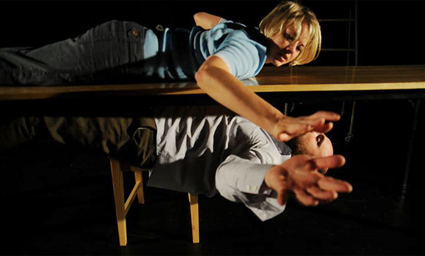
STRUT, Fuse
photo Ash de Prazer
STRUT, Fuse
FUSE IGNITED IN STRAINED TENSION AS THE WOMAN (RHIANNON NEWTON) GEOMETRICALLY WHIPPED A FEW UTENSILS ACROSS AN OVERLY LONG, TAUTLY CLOTHED TABLE BEFORE RETURNING REPEATEDLY TO SIT AND WAIT. RESONANCES OF BECKETT AND HITCHCOCK PERMEATED A FUSION OF ORDINARINESS AND INCIPIENT VIOLENCE, THE SETTING PROMISING A KNOTTED EMOTIONAL TRAJECTORY ABOUT TO BE SERVED. HER TENSE STROKES CUT ACROSS THE ARRIVAL OF THE SUITOR (JONATHAN BUCKELS) OUT OF THE SHADOWS WITH SUITCASE AND CHAIR. EXPECTATIONS SHIFTED IN BECKETT’S DIRECTION: MAYBE AN ABSURDIST TALE HAD SLIPPED ONTO THE MENU?
Neither course was delivered that evening. Instead, as if entangled in invisible loops of tripwire, two individuals tackled objects with the might of their separate anxieties and desires, swivelling and swirling in a paired but never intimate journey. Absurdity flickered in emotional futility and glared over the materiality of objects. Instead of the awaited feast, he brings to the table a bag and a goldfish bowl (as well as the second chair) that revolved and collided throughout the piece along with plates, engagement ring, shelves and peanuts. The alternating anxiety and composure of table arrangement in the opening scene, potentially a significant dramatic trigger, was annulled when the second chair entered not to be placed at, but on the table, rearranging (as his presence must) the cloth and any simple expectation of exchange.
Fragmentary scenes succeeded one another like a compendium of random tests: the feast gave way to a peanut popping contest, in which she tops his skill set, before switching to a male dress-up of the woman as seductive object without any clear indication that the two might have been playing together. Was this a narrative stream of consciousness and, if so, whose? Whatever electricity that might have been generated by tablecloth pyrotechnics, when he imprisons her, and fishbowl ultimatums, when she threatens to drop the innocent fish on his head, is blown by a faulty relationship fuse. Myriad objects took focus, initiating inventive games, taunts and obsessions, played out by a couple who remain isolated ciphers in a venture bound towards dystopic inevitability.
Emotional vacuity may well have been the premise for the work except that Fuse’s midpoint sparked with nostalgia when Charles Aznavour crooned “Dance in the old-fashioned way” over a brief quickstep or two of union before the couple, with an affection not offered to one another at any other point, gave the floor over to an invited elderly partnership from the audience. The long anticipated circuit connection was eloquently embodied in this man and woman dancing together with an ease of companionship, bearing testimony to frictions overcome and wrought into genuine fusion. Old-fashioned love with all of its accompanying imperfections made an indelible impression and with such mesmerising simplicity that it was hard to resist reminiscing on faded sepia mementos of a lost past. Contemporary performance operates on a register where frustrations pervade both on-and-off modalities and deny durability and determined continuity. Having introduced this alternative moment, Newton and Buckels then make the technically efficient but dramatic error of setting up the next array of objects in the background. Or was that decision intentional: a way of subverting a stolen precious moment?
Any fuse which may have energised the work was blown when object logistics intervened, tripping desires for personal relationships with scepticism and clever (or otherwise) subversions. Happy endings are simply dead leads, forgotten under the morass of electronic cables and instruments of new social relations. The program notes suggest that Fuse explores the reciprocal issues of identity change in a love relationship. Physically, Newton and Buckels do convey, in moments, intriguing interaction, moving with a satisfying sense of oblique empowerment, but reciprocity is ever absent and objects, rather than people, construct the narrative current. Interactive physicality in Fuse mainly comes across in combative situations with, can it be said again, objects?
Post-Aznavour, violence predictably, took over. Incarceration within the tablecloth, with a knowing nod to Hitchcock, turns lurid and rape-like. What more can he do but bind her in domesticity, hang her on the same cloth under the up-turned table before collecting his material staples and departing? As with so much of the object manipulation in this work, the image of this woman, strung under the armpits by the same cloth which so consumed her attention at the beginning, could have carried devastating or poignant capital. Unfortunately, terror and/or empathy were de-fused by our simply not caring who she or he, as vulnerable individuals, might have been.
Fuse, concept, direction Jonathan Buckels, performers Jonathan Buckels, Rhiannon Newton, music director & DJ Travis Collins, lighting Mike Nanning, presented by STRUT Dance; PICA, Perth, Aug 26-Sept 3
RealTime issue #105 Oct-Nov 2011 pg. 20
© Maggi Phillips; for permission to reproduce apply to realtime@realtimearts.net
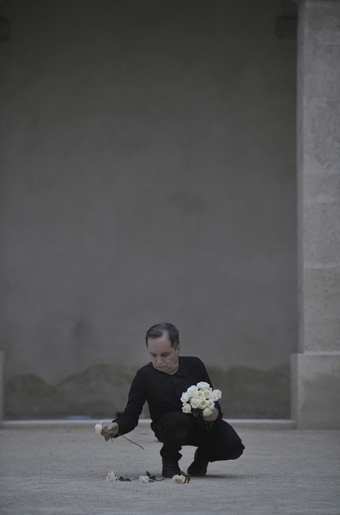
Raimund Hoghe
photo Rosa-Frank.com
Raimund Hoghe
WHAT I ENJOY MOST ABOUT THE FESTIVAL EXPERIENCE IS THE CURATORIAL CONTRACT THAT ALLOWS YOU TO FORFEIT CHOICE IN EXCHANGE FOR A GUIDED TOUR OF SORTS. IN THE CASE OF MONTPELLIER DANSE 2011 IN JUNE, THIS ALLOWED TIME AND SPACE TO DEEPEN ENGAGEMENT WITH PARTICULAR ARTISTS (RAIMUND HOGHE, PHILIPPE MENARD, ANGELA LAURIER), BUT ALSO THEMES (SEX, DEATH, ANIMALS), AESTHETIC TENDENCIES (REPETITION AND DURATION) AND REGIONS (FRANCE AND ISRAEL).
montpellier danse
The encounter with Hoghe was a journey of discovery never afforded in typical major city programming. In fact all featured artists appeared to be handled with a kind of care by the festival that was apparent and infectious; Hoghe in particular seems to attract deep and committed support.
Hoghe’s six casual afternoon shows were meant to both reprise his oeuvre and connect with the state of the festival. He presented some of his favourite things (Astaire and Rogers in Cheek to Cheek, a video of Gret Palucca shown around on an iPad, his favourite female singers from Piaf to French diva Dalida), sequences from his own past works, his collaborators’ works and short performances. His repetitive, durational pieces (walking while measuring his body with his hands, simple joint flexions and extensions) seem like a gift and are well suited to this ‘sharing’ format.
Hoghe’s history as dramaturg for Pina Bausch perhaps sets an expectation regarding expression that he seriously subverts. He presents himself, movement patterns (most often based on walking), objects and music in a kind of neutral co-existence that exceeds Bausch’s ‘showing-not-telling.’ It is the figure and character of Raimund Hoghe that anchors this highly formalist work, where humanity seeps from the body.
The focus on Israel was illuminating, even interrupted as it was by a political protest mounted on the lighting grid above one of the main stages on the opening night of the Batsheva Dance Company’s work. In a festival curated around alternatives to ‘contemporary dance’ (the sub-title of the festival was “Opening Out”), Project 5 was an anomaly. Between Ohad Naharin and Barak Marshall (ex-Batsheva), a genuine alternative movement language (seen here during the company’s residency at Sydney Festival 2007), is apparent; unconnected to ballet or release-based techniques it appears as a back-to-basics reinvention. Repetition, but also accumulation, marks the work with the first section of four structured around accumulating text and accompanying movement phrases: “Ignore concepts and ideas, ignore Beethoven, the Spider and the Damnation of Faust…don’t smoke too much, drink enough to relax…wipe your ass.” Each time it’s back to the first line and back to starting poses, vaguely balletic in form but gestural and soft. Naharin’s inventiveness is startling. Zipping changes of direction and height and impossibly deep second pliés and lunges are complicated with intricate and eccentric gestures of arms and hands; curling into the body like handles, cupped beside the face, sideways shrugs as if responding to shooting pain. The movement is full-bodied, vigorous and exciting; in unison, the impact is complete. Naharin repeated the entire program of four works in the second half with a male cast. The pieces created for the women suffered a little in comparison but the final piece, Black Milk, made more sense.
Barak Marshall’s Rooster is like a stage musical that you’d actually want to see, with great music, dancing, characters and story. Based on the life of a quiet man who lives and dies without remark, the work takes the figure of the rooster as a strutting opposition to the lead character’s tendency to fall asleep at key moments. So dancers regularly strut about the stage with feather fans for tails. The costume design is 1930s-40s with a score shifting from Jewish folk themes to American jazz and swing, making for a kind of historic-fantastic scenario not seen elsewhere in the festival. Scenes of weddings, murder, jealousy and deception are played out in dance, monologues (sometimes in English, sometimes in Hebrew) and through an opera aria. The whole is punctuated by joyous, full-bodied and rhythmic choreography that has some affinity with Naharin’s expansive style, but here is characterised by staccato accents from splayed hands and wide arms and gestural patterns that recall Bausch but are fired with a youthful energy.
Dance in France was represented by Didier Theron, Bartabas (with Ko Murobushi), Laurent Pichaud (with Deborah Hay) and Menard and Laurier who are discoveries of long-term festival curator Jean-Paul Montanari, and appeared to inspire a ‘circus’ theme within the festival. This representation of the French scene indicated the kind of diversity that real funding commitment for dance can produce over time. In Pichaud and Hay’s Indivisibilités Hay seems the leader; the notes on the work state that she was performing material from a new solo while Pichaud responded to her larger body of work. The performers broke up the proscenium space in Montpellier by inviting the audience to move between stage and seating and by stringing flags, curtains and theatre lights across the divide. Hay further challenged the space by focusing on the small groups of people sitting on stage, moving amongst them, touching and watching them watch her. Pichaud, meanwhile, negotiated cumbersome objects such as a fire hydrant and a large theatre light.
Bartabas’ Le Centaure et L’Animal is a dark and archaic piece that featured some of the most enticing choreography in the festival from Murobushi, but also the four horses in the cast: Horizonte, Soutine, Pollock and Le Tintoret. Inspired by the epic poem Les Chants de Maldoror (1868-69) by Comte de Lautréamont, a satanic and gothic mood was matched by a deep and grinding score. The piece begins with Murobushi coming to life on all fours, part animal and part man, naked, silver and Golem-like, traversing the stage with gnarled, detailed convulsions. A scrim drops dramatically and the figure of a dark horse and rider haunts the back of the stage between gold curtains. Bartabas and his mount zig-zag forward as if covering territory. When the horse’s head appears still, downstage and sideways from the wings, the effect is surreal. The appearance of the horses occurs as replayed sequences separated by blackouts. Morobushi confronts a white horse and its rider. The horse slowly falls sideways as if in slow-motion from the weight of muscle and the rider collapses too, head falling back in a swoon. Blackout and repeat. These cycles were juxtaposed with sustained images—fine dust falling onto writhing figures, a horse licking his rider clean.
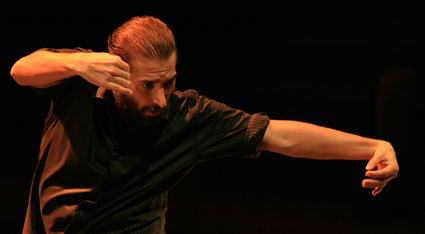
Israel Galvàn
photo Felix Vazquez
Israel Galvàn
The focus on movement per se, independent of other disciplines, was strong across the festival with mostly plain, black box designs and music, alone of the art forms, making a regular and important appearance, particularly in the work of Hoghe, Marshall, Israel Galván and the various Boleros (Naharin, Theron, Hoghe) and Rites of Spring (Menard, David Wampach and Meryl Tankard).
Galván was a revelation—I felt like an audience member in Paris in 1909 at the Ballets Russes, seeing a genre completely transformed for the first time. The documentary Bailaores (D Albertina Pisano, 2004) includes a younger Galván in a group of artists re-inventing flamenco in Spain, exploring contemporary forms, moves and aesthetics. As seen in Sydney recently (see page 14), Galván is now in peak form and his revolution is in every step. His improvisations in Le Edad De Oro keep him in a state of constant change with extreme juxtapositions from intricate and fast footwork to angular poses, extreme arches with his pelvis thrust forward, mad surprises like percussive slaps on the soles of his shoes, his bare belly or teeth, rhythmic bourrées in his flamenco boots, reaching around his head to pull his face back, or using his hand to suggest a rooster’s comb or a falling leaf. This is passion through form, meticulous and original. The sex and bravado of flamenco are subverted through references to the cockerel, but also ‘feminine’ provocations such as pulling his shirt tails up to reveal waist and arse and performing dandyesque port de bras.
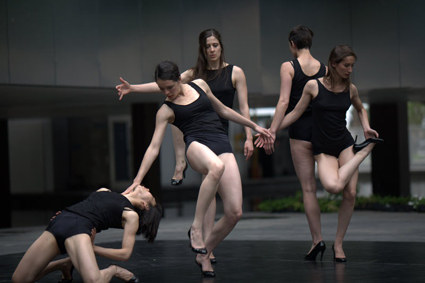
Shanghai Bolero
photo Marc-Gaillet
Shanghai Bolero
The recurrence of Ravel’s Bolero itself seemed a template for a ubiquitous compositional trend toward repetition and duration as a means of creating drama. Reading Doris Humphrey’s choreographic treatise while at the festival provided a striking historical counterpoint. Humphrey’s insistence on an ideal composition built of variation and balance in the service of ideas is replaced here with a foregrounding of form and self-aware strategies supported by clean, clear and charged movement languages. A visitor to Australia through a connection with Strut Dance’s director Agnes Michelet in Perth, Theron’s take on the score in Shanghai Boléro is beautifully articulated in his program notes; “approaching the mechanics of desire from a technical point of view.” Three sections present three different performances to the complete score on a bare, black stage. The first ‘take’ involves a cast of a dozen or so female dancers dressed in black shorts, long-sleeved tops and stilettos. Walking in grid patterns in perfect time to the music, the catwalk aesthetic is first broken by two of the women holding hands. This develops with couples and trios grabbing and embracing each other in endlessly different ways, changing partners, groups as well as pulling their tops up over their heads, or onto their heads, to reveal black bras. The work follows Ravel’s build, never dropping the swinging walk, with more complicated clusters of women and a final merging of all of them, joining to lift one dancer and disappearing in a second on the last notes. This is desire formalised as partnering and separating, encountering and disconnecting.
The second take features three male dancers in black jeans who begin a bouncing rhythm from side to side and forward and back that continues throughout the score. This bouncing energy contrasts with the drawn out swagger of the women, the male dancers lacking the poise and proficiency of the women, looking more physically and technically pedestrian. In the third take, the cast come together in various states of dress/undress in a series of tableux held for a consistent number of bars, rotated to show every angle, then mixed up until the dancers run into dynamic frozen compositions. The quality of the poses ranges from baroque and sublime to flat and disconnected, but the drama of the compositions is complete and thrilling. Another dancer is raised into the air and then, once again, the dancers are gone with the final notes.
julidans, amsterdam
Curatorially the Julidans program lacked the through-lines and recurrences of Montpellier, and ‘star’ acts such as Ultima Vez, Maguy Marin and Sidi Larbi Cherkauoi (whose piece was replaced with a solo work by Gregory Maqoma due to the absence of a dancer) collectively represented a dance theatre tendency that seemed worlds away from the formalism in France.
One standout was a young American choreographer based in Brussels, Daniel Linehan. His work with two other dancers, Thibault Lac and Salka Ardal Rosengren, Zombie Aporia, sets up a series of tasks (eight dances) involving a transposition of information from one medium to another. In one, Pacman-like figures on a screen represent positions in the raked seating, and as they move on screen, the dancers move to the corresponding position. In another, the dancers mimic an improvised comic dance performed earlier by Thibault which is played back on a monitor, appearing like glitchy, uncoordinated marionettes (recalling for me Luke George’s work with A Chorus Line in Now Now Now at Dance Massive in 2011; RT102).
In another section, Rosengren scrolls text on a computer screen with her eyes shut as Linehan whispers the text in Lac’s ear, who pronounces it out loud with dramatic intonations set by Linehan. In yet another, Linehan’s vision as he dances is perfectly mimicked on a screen—we see what he would be seeing—except that the auditorium seats are empty (it has been pre-recorded). Interesting in themselves, the texts (both spoken and sung) add a whole other layer, and the ‘lyrics’ are handed out before the show encouraging a sing-a-long. Reflexivity about the potentialities of the body, the role of performance, self-critique and Continental philosophy bump together with an experimental energy and clarity that’s truly exciting.
Montpellier Danse, June 22-July 7, Montpellier, France; Julidans 2011, Amsterdam, Netherlands, July 1-10
RealTime issue #105 Oct-Nov 2011 pg. 10,12
© Erin Brannigan; for permission to reproduce apply to realtime@realtimearts.net
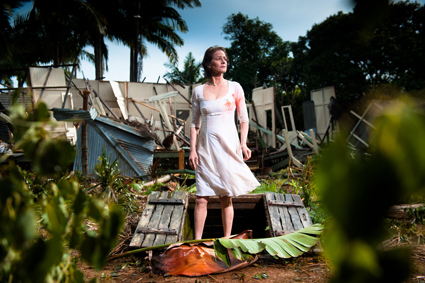
Charlotte Rampling, The Eye of the Storm
FILMMAKERS BRAVE (OR FOOLHARDY) ENOUGH TO TACKLE PATRICK WHITE’S RICH LITERARY LEGACY MIGHT BE COUNTED ON A COUPLE OF FINGERS. ALTHOUGH VOSS HAS BEEN SUCCESSFULLY ADAPTED TO THE OPERATIC STAGE, NOTHING CAME OF HARRY MILLER’S PROPOSED FILM IN THE LATE 60S, WHILE JIM SHARMAN’S THE NIGHT, THE PROWLER (1978) WAS FILMED FROM WHITE’S OWN SCRIPT.
During the author’s lifetime this paucity might have been attributed to the inexorable control that White exacted over his work and legacy—to the point of denying his own official biographer access to his private journals. However since his death, a new generation has been slow to grasp the opportunity presented by the novels. Indeed, it’s an experienced team who’ve risen to the challenge with The Eye of the Storm, the novel that tipped the scales to net the author his grudgingly accepted Nobel Prize in 1973.
Former socialite Elizabeth Hunter (Charlotte Rampling) lies dying in her lavish residence by Centennial Park in Sydney. Occasionally lucid, though as often floating on an ocean of memory, her needs are attended by two nurses, the sassy Flora (Alexandra Schepisi) and saintly Mary (Maria Theodorakis), a housekeeper, the irascible masochist and Holocaust survivor Lottie Lippmann (Helen Morse), as well as stalwart family lawyer Wyburd (John Gaden). Into this delicate arrangement arrive Elizabeth’s estranged adult children: Dorothy (Judy Davis), the Princess de Lascabanes, smarting from a failed marriage into European aristocracy that has stranded her in middle age with nought but a title and some jewels; and Basil (Geoffrey Rush), a rumpled actor, knighted by the British, who floats through life playing to other people’s expectations while haunted by his failure as Lear, the role by which he measures the limits of his talent. Temporarily united by a shared plan to pack their mother away to a nursing home and generally accelerate their inheritance of her fortune, the pair descend upon the deathbed to extract what they feel is owed.
The extent to which the film is seen as a successful adaptation depends entirely on the degree to which the story is viewed as inseparable from the prose in which it was written. The pleasures and frustrations of White’s writing—which for many may amount to the same thing—unravel organically, brilliant tendrils of digression curling away from painstakingly crafted scenes, present action illuminated by streams of consciousness, prose of unrelenting precision sinking its barbs into the reader’s mind: “the women, either in loud summery shifts, apparently with nothing underneath, or else imprisoned in a rigid armature of lace, shrieked at one another monotonously out of unhealed wounds.” Writing to Cynthia Nolan in early 1970, White commented that the novel was “going to be in the shape of a spider’s web,” and indeed to read it is to trace each thread through the concentric circles of narrative that slowly orbit Elizabeth’s impending death.
The dangers in adapting a narrative of this complexity are manifold. Judy Morris, whose lengthy resume as a film and television actor is complemented by writing credits on the Babe sequel Pig in the City (1998) and George Miller’s dancing penguin extravaganza Happy Feet (2006), has sharpened the primary relationships while shearing away the majority of Elizabeth’s mental forays into the past, trimming the frumpish Jessie Badgery from her entourage and generally rearranging and combining scenes to allow a seamless cinematic flow, one that is amply realised by director Fred Schepisi.
Having made his name at home directing films such as The Chant of Jimmie Blacksmith (1978), Schepisi departed for the US where he solidified a reputation for producing films both critically respected and commercially robust. With Eye he is less analeptically trigger-happy than might have been expected, relying on loaded visual imagery to suggest the barely supressed corruption in which White revelled, the camera lingering on mould formed on a dish of preserves, two kilos of beef rotting in a garbage bin, and worms “lashing themselves into a frenzy of pink exposure” beneath rose bushes “at the climax of their beauty.” The film combines lush costumes and decor—gilt bed frames, colonnades and chandeliers. The house at Centennial Park is an exercise in opulence. Adding a smoothly vapid jazz soundtrack, Schepisi succeeds in capturing the crass indulgence of the period without aiming for the florid ruthlessness with which White represented his countrymen—although Colin Friels’ lascivious politician Athol Shreve comes close.
One of Schepisi’s most obvious achievements with this film is simply assembling a cast of such calibre. Judy Davis is superb as Dorothy, the perennially disappointed princess, murmuring the correct formalities through sour lips, roiling insecurities being permitted meagre outlet as she kicks her mother’s tasteful furnishings. Trained by Elizabeth in pursuit of wealth, Dorothy takes none of her mother’s unalloyed pleasure in the material; in one brilliant scene, she is surprised by Mary while rubbing her face on a sumptuous rug, Davis’ face collapsing from mortification into self-disgust on learning that the fur is platypus. Rush is equally good as the fumbling, narcissistic actor: “I think I might be ready for something real” he tells Flora with sublime self-delusion after their mutual seduction— though his presence tends to overwhelm the whole, a fact not helped by his unnecessary narration.
Charlotte Rampling is also excellent as the still-regal Elizabeth, her features displaying both the collapsed beauty and inner steel of the dying matriarch. Even from her death bed she is capable of slicing through the affectations of her love-starved children, out-performing the debonair Basil in their excruciating reunion or reducing Dorothy to sputtering incoherence with a sweet enquiry: “Are you going through a difficult time again?” However it is in its representation of Elizabeth that the film runs against the limits of the medium. In the novel, White accessed scenes from across a lifetime of casually unthinking egotism and the brutal pursuit of status, offering her character both as it was and is perceived in recollection all at once. Rampling, though brilliantly cast, can only gesture toward such psychological depth.
This is made manifest in the way both texts deal with Elizabeth’s moment of revelation, where, battered by the hurricane of the title on the fictionalised Brumby Island, she relinquishes her own unyielding hold on life and experiences a moment of sublime grace. In the novel, her rambling mind persists in returning to this moment, which both anchors the novel and her character, the insight into her own selfish refusal to open herself to love casting its illumination across the rest of her life. “She was no longer a body, least of all a woman,” White writes. “She was instead a being, or more likely a flaw at the centre of this jewel of light: the jewel itself, blinding and tremulous at the same time, existed, flaw and all, only by grace.” Limited as he is by the eye of the camera, Schepisi is merely able to capture the image of Rampling standing in the surf, dappled by the shadows of seabirds, her face upturned and exaltant. Although beautiful, the moment is perhaps unavoidably stripped of much of its psychological and indeed metaphysical resonance.
“The worst thing about love between human beings,” declares Elizabeth early in the novel, is “when you’re prepared to love them they don’t want it; when they do, it’s you who can’t bear the idea.” Over the course of nearly 600 pages of vividly imagined prose, White meticulously traces the destructive effects of attempting to impose one’s will on the heart. In contrast, Schepisi and Morris have managed to dramatise the essentially meaningless theatre to which relationships descend when denied loving sustenance.
The Eye of the Storm, director Fred Schepisi, novel Patrick White, screenplay Judy Morris, cinematographer Ian Baker, editor Kate Williams, production designer Melinda Doring, composer Paul Grabowsky, Paper Bark Films, distributor Transmission, 2011
RealTime issue #105 Oct-Nov 2011 pg. 21
© Oliver Downes; for permission to reproduce apply to realtime@realtimearts.net
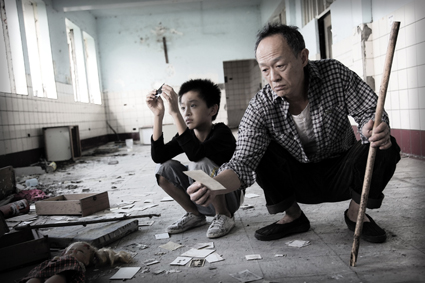
The Fourth Portrait
ON THE ONE HAND IT WAS GREAT TO SEE OUR REGION’S CINEMA HIGHLIGHTED AT MIFF THIS YEAR WITH THE “ACCENT ON ASIA” STRAND. ON THE OTHER HAND THIS BRACKETING OFF OF ASIAN CONTENT REFLECTS THE UNRELENTINGLY EURO AND US-CENTRIC CINEMATIC VISION PREVALENT IN AUSTRALIA.
While the festival’s “World Panorama” program consisted almost entirely of European and American fare, cinema from our near neighbours was still packaged as an exoticised sideshow. Nonetheless, these “accented” titles provided two of the festival’s most engaging films from a pair of directorial talents only just emerging onto the world stage.
the fourth portrait
Rising Taiwanese director Chung Mong-hong delivered a stunning childhood tale from the wrong side of the island with The Fourth Portrait. Taiwanese cinema has undergone something of a revival in recent years, clawing back a share of the island’s box office after years of domination by the Hollywood steamroller. Among the clutch of popular titles released over the past half-decade was Chung’s debut Parking in 2008, a solid if at times overly sentimental look at the darker, after-hours side of life in Taipei. The Fourth Portrait similarly deals with experiences lying beneath the visible flow of daily life, but it’s an altogether more complex and affecting work than Parking.
The Fourth Portrait opens with Xiang, a taciturn 10-year-old boy, left alone following his father’s sudden death. After he is caught stealing lunches at school, a gruff cleaner realises Xiang has no family at home, and through his intervention the boy is reunited with his long absent mother, now living in a rural area with a baby and a brooding second husband. As Xiang hesitantly moves into his new life with his surrogate family, his dreams become haunted by his older brother, who vanished in mysterious circumstances several years earlier. Disturbed by these nightly visions of his sibling’s wandering soul, Xiang begins to suspect his stepfather knows more about his brother’s disappearance than he is letting on.
At one level Chung’s film is a beautifully understated study of the powerlessness of childhood, strongly reminiscent of François Truffaut’s classic The 400 Blows (1959). Like Jean-Pierre Léaud’s character in Truffaut’s film, Xiang is a boy who has experienced too much too young, and who understands far more about the world than the adults around him realise. He moves through his surrounds as an observer rather than a protagonist, trying to make sense of adult senselessness and sketching his encounters in a series of portraits illustrating his gallows humour and growing sophistication. In another nod to Truffaut, when Xiang reaches his fourth portrait, Chung’s film ends in a startling moment of reflexiveness that turns the boy’s gaze back upon the viewer—and upon Xiang himself.
The Fourth Portrait is also rich in allegorical resonances. Xiang’s missing brother is the most literal of the film’s apparitions, but Taiwan here is an island haunted by many spectres, from the elderly school cleaner’s traumatic memories of wartime Shanghai to Xiang’s mother’s more recent painful past on the mainland. Like Xiang, Taiwan has entered an era of relative freedom since the death of its patriarch, but as a political and cultural entity it remains unsure of itself and where its future lies. Xiang finds an uneasy shelter in his mother’s new home—just as Taiwan has ensured its economic survival by cosying up to Beijing—but his bullying stepfather, nursing his own dark secrets and murderous temper, is hardly a role model for the boy. If there is hope, it lies with the younger generation, expressed in Xiang’s final moment of clear sighted, unflinching self-reflection.
The allegorical undertones never feel forced however and the spare script and restrained performances prevent the story ever slipping into sentimentality or melodrama. Bi Xiaohai is wonderful as Xiang, achieving a fine balance between expression and introversion. Hao Lei is also excellent as Xiang’s mother. Best known for her lead role in Lou Ye’s Summer Palace (2006), Hao’s performance in The Fourth Portrait earned her Taiwan’s 2010 Golden Horse Award for Best Supporting Actress.
The Fourth Portrait bodes well for Chung Mong-hong’s career as a budding talent of Taiwan’s contemporary film revival. While the film’s pace and domestic drama is reminiscent of the classics of Taiwan’s new wave, and the Truffaut influence is clear, The Fourth Portrait remains an original, quietly searing picture of childhood, whose atmosphere lingers long after Xiang’s probing eyes have burnt up the final frames of the film.
eternity
Thai director Sivaroj Kongsakul’s debut Eternity is another tale in which ghostly memories haunt the landscape, leaving gentle vibrations in the physical world. Much Thai cinema is replete with ghosts, spirits and slow-burn sexuality, and the influence of local master Apichatpong Weerasethakul (Syndromes and a Century, Uncle Boonmee Who Can Recall His Past Lives) is obvious here.
Eternity begins with a series of long take panoramas of a rural landscape, traversed by a man on a motorbike apparently searching for something—or someone. He finally stops at a tiny roadside shrine, prays and gazes sadly at a small house in the distance. From here we move back to the man’s first holiday in his home village with his Bangkok girlfriend. Their love is obvious in small moments of togetherness, yet they barely touch until their final night in the village, when he slides under her mosquito net and into her bed. On their way back to the capital, a discussion beside the grave of a relative segues into the girlfriend’s departing the cemetery with two grown children. She is older, slightly heavier, with the same cool grace, but now marked by an air of sadness.
This fluid sense of time carries the viewer along throughout the film, in gentle eddies and swirls of memory as past and present intermingle in the family’s Bangkok home. The teenage son echoes his father’s youthful flirtatiousness, while the father’s spectral presence is marked by flickering lights. Or maybe it’s just a fluctuation in power. Whether we read Eternity as a ghost story or a more literal tale of memories living on in the lives of those we leave behind, it’s a beautifully minimalist evocation of profound, unspoken love—and the melancholy absence that’s left with our passing.
a world apart?
Other titles in MIFF’s Accent on Asia strand showed the region’s commercial industry is powering on, particularly South Korea’s seemingly endless stream of highly popular, ultra-violent tales of male disintegration. Several Japanese titles, including Takeshi Kitano’s Outrage, proved the island nation can still match Korea in terms of bloody cinematic extremes. It was The Fourth Portrait and Eternity, however, that demonstrated some of the world’s most innovative and subtly poetic works continue to come from our northern neighbours, even if here in Australia we still tend to view these films as somehow standing apart from the rest of world cinema.
Melbourne International Film Festival, various venues, July 21–Aug 7, www.miff.com.au
RealTime issue #105 Oct-Nov 2011 pg.
© Dan Edwards; for permission to reproduce apply to realtime@realtimearts.net
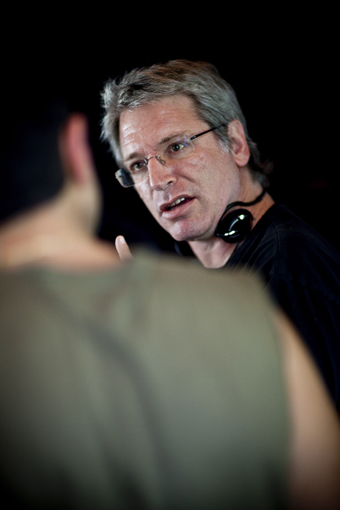
Michael Rymer
photo Dennys Ilic
Michael Rymer
LOCATING AUSTRALIAN DIRECTOR MICHAEL RYMER IN A LARGE HARBOURSIDE HOTEL COULD BE A CHALLENGE. HE’S BURIED AMONGST THE POTTED PALMS AND SURROUNDED BY WHAT LOOKS LIKE A WHOLE CONVENTION OF JAPANESE FLIGHT ATTENDANTS. THE DIRECTOR PROBABLY HAS A WEARISOME SLEW OF THESE INTERVIEWS BUT HE IS CHARMING AND RELAXED COMPANY. WITH HIS CRISP BLUE SHIRT AND TANNED FEATURES HE HAS A LOOK THAT ONE COULD DESCRIBE AS ‘CALIFORNIAN HEALTHY.’ RYMER, ORIGINALLY FROM MELBOURNE, HAS INDEED SPENT QUITE A LOT OF TIME IN NORTH AMERICA HAVING GONE TO FILM SCHOOL IN NEW YORK AS A VERY YOUNG MAN. “I AM A LITTLE BIT TRANSPACIFIC” HE SAYS, AND IF YOU LISTEN CAREFULLY YOU CAN DETECT VERY FAINT TRACES OF AN AMERICAN TWANG.
In 1995 Rymer burst on to the Australian scene with the quirky, utterly brilliant Angel Baby, an oddball love story starring the inimitable Jacqueline Mackenzie. Pretty soon Rymer was off to North America. He spent quite a lot of time in Vancouver where he worked for years on the highly cult sci-fi Battlestar Galactica (once described as ‘Star Trek for grown-ups’). Rymer loved working on it and says it taught him a hell of a lot about how to hold audiences with just timing and good directing. “It’s dark and broody. But we shot five or six pages of script a day so I learned some tricks about covering material fast and keeping an audience on its toes.”
He needs these skills for his return-to-Australia film Face to Face, which has secured a lot of festival notice including more than one audience selection. Given that it is in some ways a tough watch, Rymer is pleased with those non-critical accolades. When I tell him I have only seen the film with other critics he urges me to see it again “with a real audience.”
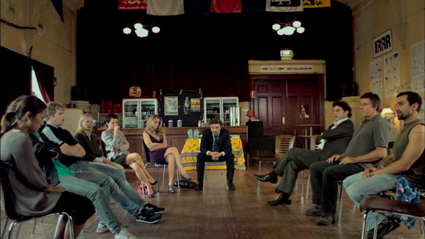
Face to Face
Face to Face was born out of Rymer’s encounter, via his friend David Moore, with the alternative approach to crime resolution known as Restorative Justice. They both thought it would make the basis for some incredible drama. So did playwright David Williamson and he wrote a play based on the idea. To some Williamson is a ‘national treasure’; to others he is someone who grasps abstract issues better than real characters. Rymer says Williamson can sometimes get depressed about those accusations. He told his friend not to worry as he would surely outlast his critics. Rymer took on the challenge of converting the play to the screen whilst avoiding staginess. He showed the drafts to Williamson and was pleasantly surprised how smoothly it all went. “I was a little bit nervous showing it to him but he was very generous. He must have liked what I did as he didn’t change much at all.”
We talk about some of the other plays to film adaptations. Rymer recalls Robert Altman (a big influence) coming to his film school and showing them Streamers (1983). More recently there was Nicolas Hytner’s filming of his stage-directed History Boys (2006). The best analogy for Rymer though is Sydney Lumet’s first film: “I love that. I would like to think of this film as an Australian contemporary Twelve Angry Men (1957).”
The look of the film is very much down to its location. Apart from a few strategic flashbacks to open it up, the whole shoot was done in a big Trades Hall in central Melbourne. Rymer turns out to be a pretty good location scout too: “I knew I had to find a place that had great texture and light. That is the look of the whole movie. It was actually a working bar too so at night we had to pack up the whole shoot!”
The film was shot using available light. Rymer was initially worried as the film was pioneering the use of new compact digital cameras—the Canon D series. “I remember we had to wait for a special patch to convert to film frame speed.” Although the cameras were forgiving, the rapid intense shoot does make one nervous. As Rymer says, “the one thing with that kind of shoot is that there is no margin for error. If just one of the actors had not been on form, or if something technical had gone wrong, then you are in trouble.”
Rymer’s strong suit is his amazing cast with at least four well-known names and some excellent support players. Rymer was canny about this aspect too. It helped that some of the cast lived in the city where it was shot and that the shoot took only about two weeks of their busy lives. “The trick is to ask people really late. If you ask them too early—and there’s little money in it—they are unlikely to block out that period of time or avoid better paid work.” Given that the film is about victims and perpetrators confronting the past and each other, it can get very intense. Rymer describes the shoot as a ‘crucible’: “I am a believer in the idea that what happens behind the camera affects what’s in front and vice versa. We benefited from an intense shoot I think. We didn’t have time to rehearse too much and over-think it. You need very good actors to do that of course.”
Although the film has meaty roles for Matthew Newton and Vince Colosimo and Luke Ford (the up and coming actor from Black Balloon and Red Dog) it was actually anchored around Sigrid Thornton. “She was first person on board and that is important. She was a friend I had always wanted to work with. The movie doesn’t really belong to her character but she is so good, so generous. She even co-wrote a monologue (approved by Williamson) which adds to her character.”
There’s no big PR and marketing budget either so the film will depend a lot on word of mouth. Rymer was pleased the film got the audience vote at the recent Melbourne International Film Festival. He hopes the package as a whole will intrigue people: “It’s a home-grown film and privately funded. We just think we will take it to the ‘court of public opinion’.”
Face to Face, direction, screenplay Michael Rymer, from the play by David Williamson; distributor Australian Film Syndicate, 2011
RealTime issue #105 Oct-Nov 2011 pg. 24
© Julian Wood; for permission to reproduce apply to realtime@realtimearts.net
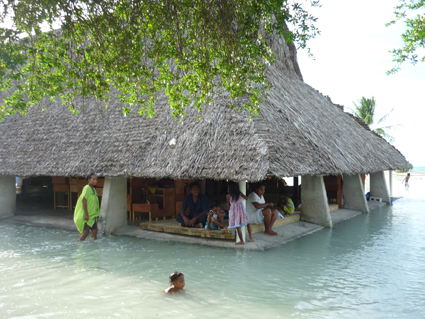
Tebekenikora Village, The Hungry Tide
IS THERE ANY GREATER SIGN OF AUSTRALIA’S GLIB ISOLATION FROM WORLD AFFAIRS THAN THE LOCAL ‘DEBATE’ OVER CLIMATE CHANGE? WHILE HUGE SWATHES OF THE WORLD’S POPULATION ARE ALREADY HAVING TO COPE WITH THE DIRECT CONSEQUENCES OF A WARMING PLANET, HERE IN AUSTRALIA THE QUESTION OF WHETHER GLOBAL WARMING IS EVEN HAPPENING IS STILL TREATED AS A SERIOUS ONE. INTO THIS DIVIDED DISCOURSE STEPS TOM ZUBRYCKI’S NEW FEATURE-LENGTH DOCUMENTARY, THE HUNGRY TIDE, A PORTRAIT OF SYDNEY-BASED ACTIVIST MARIA TIIMON AS SHE WORKS TO DRAW ATTENTION TO THE PLIGHT OF HER PACIFIC ISLAND NATION KIRIBATI, WHICH IS ALREADY BEING INUNDATED BY RISING TIDES.
“I’ve been following the climate debate for a number of years and became very interested in the countries on the frontline,” says veteran director Zubrycki. “Kiribati and its neighbor Tuvalu are expected to be the first nations in the world to disappear as a result of climate change, so this was the trigger and motivation to make the film. The next step was to personalise the issue and find a narrative.”
Into this breach stepped Tiimon, an advocate with the Pacific Calling Partnership NGO based at the Edmund Rice Centre in Sydney. As the film opens, she is preparing to journey to Copenhagen in late 2009 to represent her nation at the United Nations Conference on Climate Change.
“Kiribati seems at the very edge of the earth for most Australians, yet it is only just east of Bougainville,” Zubrycki says of Maria Tiimon’s homeland. The country’s 33 atolls are an average of only two metres above sea level. Given that even optimistic forecasts predict a rise of 0.8 metres by the end of this century, it’s likely that Kiribati will be virtually uninhabitable by the time today’s babies reach old age.
Despite the severity of the threat, Maria is initially quite shy in her advocacy role, and part of the film’s journey is her growth as a media performer over the 12 months Zubrycki follows her. “Maria was the total opposite of Ramos Horta,” the director says, referring to his 2000 film The Diplomat, a classic portrait of the East Timorese leader. “Horta was driven by ego and the unshakeable belief that history was on his side. For Maria, being an advocate for her country was something thrust on her. She was a little reluctant at first, even though she believed passionately in the cause.”
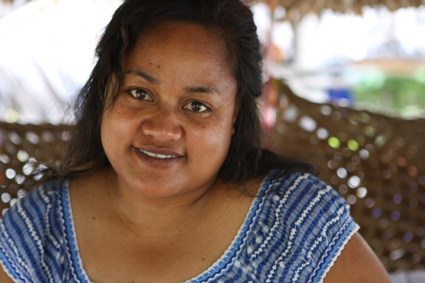
Maria Tiimon, The Hungry Tide
Despite Maria’s shyness, Zubrycki manages to build an easygoing intimacy with her, based on a mixture of observational footage and casual verbal interactions. It’s a style that has served him well over the course of more than a dozen films, lending a personal dimension to his broader socio-political concerns. Recalling his early days in Sydney’s community video movement and the influence of US documentarians like Frederick Wiseman and Richard Leacock, Zubrycki explains, “I was restricted by budget so I could never do ‘pure’ direct cinema. So I developed a signature style which was a mix of direct cinema, interview and montage.”
The personal encroaches on the political in The Hungry Tide as Maria is torn between her family in Kiribati and her role on the world stage. These personal conflicts provide an involving emotional sub-plot and counterpoint to the broader dilemma faced by her nation.
As we follow Maria home to Kiribati just before the Copenhagen conference, the stark global inequalities driving the climate change phenomenon become all too apparent. From the luxury of life in Australia we are plunged into the basic existence of the Kiribati people, where even the arrival of a television set in Maria’s brother’s home is a major event. “It was only when I got to know Maria better that I became aware of the pressures from her family back on the islands,” says Zubrycki. “She was supporting two families in fact—her extended clan on her home island of Beru and her brother and his eight kids in the impoverished, overcrowded Kiribati capital Tarawa. She was living two lives and trying to find a balance between them.”
The stark impression of a global pecking order is only reinforced by the scenes in Copenhagen. The Kiribati delegation is forced by budgetary restraints to stay two hours out of the city and Maria has to double as a dancer at the nation’s press conference because they can’t afford to fly in a professional troupe. As we follow the backstage machinations from the Pacific Islanders’ perspective, we hear of the intense pressure applied by Canberra to these nations to withdraw their demand for a legally binding treaty—a manoeuvre barely mentioned in the post-conference rush to blame the dismal outcome on China.
Meanwhile, back in Kiribati the tide steadily encroaches on coastal settlements, roads and agricultural lands. “It struck me as a great irony,” Zubrycki comments wryly, “that Kiribati has contributed least to global carbon emissions but has the most to lose in terms of its vulnerability.” Unlike The Diplomat, which concluded with Ramos-Horta’s dramatic return to an independent East Timor after 25 years in exile, The Hungry Tide documents an ongoing struggle that is both more complex and potentially more devastating in its outcomes. Yet as Zubrycki notes, “Kiribati is not even on the radar for most Australians.”
Despite the vital role documentaries like The Hungry Tide play in bringing under-represented issues to public attention, Zubrycki remains frustrated with what he sees as a reluctance on the part of local broadcasters to back films with a regional focus. “For reasons that are beyond me, broadcasters believe their current affairs teams can cover Asia and the Pacific much more efficiently,” he says ruefully.
The fact that Kiribati’s plight is barely known in Australia contradicts the broadcasters’ belief—and illustrates why long-form documentaries are so important. It’s a testament to Tom Zubrycki’s skill as a filmmaker that he has touched upon so many vital issues in his career, through such intimate portraits of personalities big and small. Reporting the facts is important, but it’s our understanding of the people behind the headlines that can sow the seeds of real engagement—and in the longer term, the possibility of real change.
The Hungry Tide, director, producer Tom Zubrycki, 2011, Melbourne International Film Festival, July 21–7 Aug 7; www.miff.com.au
The Hungry Tide will screen in Sydney and Melbourne cinemas in late November. A 52-minute version will be shown on SBS 9.30pm, Sunday, Oct 9.
RealTime issue #105 Oct-Nov 2011 pg. 25
© Dan Edwards; for permission to reproduce apply to realtime@realtimearts.net
IN DECEMBER LAST YEAR SYDNEY BECAME THE SECOND INTERNATIONAL CITY OF FILM, JOINING UNESCO’S CREATIVE CITIES NETWORK, A GLOBAL WEB OF KEY CITIES COMMITTED TO PROMOTING ECONOMIC DEVELOPMENT THROUGH THEIR CREATIVE INDUSTRIES. THERE IS NOW A MEMBERSHIP OF 27 CITIES FEATURING THE CULTURAL CATEGORIES OF LITERATURE (MELBOURNE, EDINBURGH), MUSIC (BOLOGNA, SEVILLE), DESIGN (SHENZHEN) AND FILM (BRADFORD AND NOW SYDNEY), AS WELL AS CRAFTS AND FOLK ART, MEDIA ARTS AND GASTRONOMY, WITH MORE THAN 20 CITIES ON A WAITING LIST TO JOIN.
The granting of this prestigious international title brought a flurry of media stories, including one that quoted filmmaker Gillian Armstrong saying that you have to feel slightly embarrassed about the fact that “we’ve been given this incredible honour: City of Film, and we don’t have a cinematheque, we don’t have a film centre. This should make us realise it’s time to move on that.”
a new initiative
And there has apparently been some movement. In late September another little burst of stories confirmed that progress had been made. Sydney’s Lord Mayor Clover Moore announced that $30,000 had been approved for a feasibility study which would consider the size, location and operating model for a film centre, and to establish its potential financial benefit to Sydney. “The feasibility study will help prepare the case to go to State and Federal Governments to seek their support in creating a centre.” Moore said.
Gillian Armstrong, along with Margaret Pomeranz, AFTRS head Sandra Levy, and departing Sydney Film Festival director Clare Stewart, had last year formed the Sydney Film Centre Committee to campaign for the proposal, while directors Dr George Miller, Jane Campion and Peter Weir, and actors Cate Blanchett, Bryan Brown, Toni Collette, Guy Pearce, Richard Roxburgh and Geoffrey Rush had all pledged their support.
The planned Barangaroo development in the CBD was seen as a possible site for the centre, and when the Barangaroo Delivery Authority called for cultural proposals late last year the committee made a submission. They proposed a permanent space with state-of-the-art facilities and year-round exhibition, focusing a cinematheque style of programming on the history of the moving image, including both international and Australian production, as well as innovative trends in screen-based media. Such a film centre could stage major festivals, host film classes and allow the public to watch films on demand, while the National Film and Sound Archive would be able to screen work from its collection.
Of course, this is only the latest in a number of attempts to establish a cinematheque in Sydney, even if it is now part of an ambitious and high profile project with major cultural support. So the point is not why it has taken so long for this idea to surface, but why the admittedly spasmodic and differing efforts over many years have never really delivered a permanent and recognised cinematheque.
what is a cinematheque?
What is a cinematheque, anyway? The name and the model come from the Cinémathèque Française in Paris, which has had a chequered history since it was founded in 1936 through the passion of the legendary Henri Langlois, who started collecting and preserving films in the 1930s (and had to smuggle huge numbers to unoccupied France to protect them during the war). Dedicated to rediscovering, restoring and conserving all sorts of cinema, to make it available for public screenings, it was the first and most famous institution of its kind, and is now a cultural icon in France.
It wasn’t always so; while the French government provided a small screening room, staff and a subsidy for the collection after the war, and many of those who had their film education through these regular cinematheque screenings went on to become the filmmakers of the New Wave, Langlois himself was fired as head of the Cinémathèque by Culture Minister André Malraux in 1968, sparking protests in Paris, worldwide shows of solidarity, and threats to withdraw films from the collection. He was reinstated two months later, and earned both an honorary Oscar and a César in 1974. But the Cinematheque and its collections moved all over Paris for years, and a fire damaged its Musée du Cinéma in 1997; it finally found a permanent home in 2005 in Frank Gehry’s madly skewed building, originally created in 1994 as the American Centre, but now wonderfully refurbished and housing four screening rooms, several floors of museum space, a multimedia library and a bookstore. The Cinémathèque makes the films from its collection of 40,000 available to the public, screening a rich and varied program of national cinemas and retrospectives devoted to various artists, as well as providing teaching activities and lectures.
There are now cinematheques in many cities, from the British Film Institute’s National Film Theatre in London, the Museum of Modern Art’s Film Department in New York and a number of centres in European cities. Most feature curated and changing programs of classic and current cinema, focussing on themes, genres, national cinemas and directors, and increasingly on innovations in screen practice.
australian cinematheques
There was much talk about a national cinematheque in many of the lively debates and discussions about film culture in Australia from the 70s and early 80s. It was argued that not only would audiences profit from regular screenings of films from other national cinemas, curated seasons of the work of particular directors, screenings of specific genres and of rarely seen gems, but that our own filmmakers, film students and audiences could benefit from being exposed to such a rich diversity of filmmaking practice.
There already was a successful local example; the Melbourne Cinémathèque had been doing something along those lines in its annual program of screenings, a program which continues today. Starting as the Melbourne University Film Society (MUFS) in 1948, and becoming the Cinémathèque in 1984, it’s run by a self-administered, non-profit, membership-driven group of committed cinephiles who every year program a challenging and diverse selection of classic and contemporary films, curating both retrospectives and thematic series from archival and new prints sourced from all around the world. (This year their program has included retrospectives of the work of Agnieszka Holland, Henri-Georges Clouzot and Masahiro Shinoda.) The huge benefit from such an uninterrupted screening history is the building of a loyal and committed audience, and for a number of years they’ve had the added advantage of screening at the well-equipped Australian Centre for the Moving Image, Melbourne’s own version of a film centre (which of course runs its own interesting film exhibition program, as well as providing studio, exhibition and workshop space).
For some years from early 90s the Australian Film Institute ran what was called a national cinematheque, taking the Melbourne Cinematheque program around Australia to a circuit of cinemas including the AFI’s Paddington Town Hall cinema, later to become the Chauvel, the Media Resource Centre in Adelaide and the Film and TV Institute in Fremantle. This venture was supported financially by the Australian Film Commission. In Sydney the AFI had handed management of the Chauvel to the idiosyncratic Alex Mescovitz, who refused to screen the Melbourne Cinematheque-curated program in its entirety, preferring to pick and choose, augmenting the program with many of his own favourite films – which included a lot of Kurosawa, film noir and Tarkovsky. However, when the AFI wanted to consolidate all its exhibition and run an enhanced national cinematheque, the AFC withdrew the funding, ran the project itself for several years, then watched it gradually dwindle away.
the mca cinematheque
The closest Sydney came to a dedicated, purpose-built cinematheque was through an initiative that started in the early 90s, centred in the newly opened Museum of Contemporary Art. As described by one of the instigators, director Dr George Miller, this visionary project involved an additional building which would house a cinematheque, designed to be “a national gallery, screening venue and study centre for film, video and computer-based media…a breeding ground for experimentation and discovery, a creative gymnasium, moving-image nerve centre and power plant.”
The new building was designed to look out across Circular Quay to the Opera House, and would contain three cinemas and a visual resource centre. David Watson, who had worked at London’s Museum of the Moving Image, was brought on board first as a consultant and then as cinematheque coordinator; he put together a challenging interim program of screenings, debates and talks in the MCA’s existing and not very film-friendly facilities. But, as he said, the new cinematheque would be “distinguished by its programming philosophy, standard of presentation and technical sophistication. Moving images will be shown as they were created to be seen, with precision and ambience.”
There followed years of meetings, workshops, the changing and development of the proposal, and the holding of architectural competitions. (The first was won in 1997 by distinguished Japanese architect Kazuo Segima, with a building like a glowing white box.) All the interested parties, the MCA itself, Sydney University, the NSW Government, the Sydney City Council and the Sydney Cove Authority, went through seemingly interminable negotiations. By 1999 it all came to nought; negotiations broke down, the money ran out, and the MCA cut back on staff, including the cinematheque coordinator. (Revised plans for the MCA’s future have conspicuously lacked any mention of a cinematheque.)
the goma cinematheque
David Watson took his expertise and experience north, where he became consultant to the film strand in the development of a gallery of modern art that was slowly but very surely taking place in Brisbane. The Gallery of Modern Art opened in December 2006, complementing the Queensland Art Gallery building in the inviting cultural complex on the Brisbane River. GOMA focuses on the art of the twentieth and twenty-first centuries, and its flagship project is the Asia-Pacific Triennial of Contemporary Art series of exhibitions, now a major event on the national and international arts calendar. In its two modern, state of the art cinemas, GOMA runs the Australian Cinematheque, presenting retrospective and thematic film programs and exhibitions, exploring the important lines of influence between the moving image and other areas of visual culture, and showcasing the work of influential filmmakers and artists.
GOMA’s Cinematheque has held several extensive and revelatory Asian programs, while the breadth and depth of the seasons it has held in the last five years is quite staggering, both in the size of each program and the strength of its curatorial expertise. Its current season is The Savage Eye: Surrealism and Cinema, which coincides with Surrealism: The Poetry of Dreams in the gallery. It’s a survey of the surrealist sensibility in cinema, and considers “films made under the rubric of the movement alongside popular cinema with similar themes”; its amazingly extensive program includes surrealist documentary and ethnographic surrealism, as well as French serials from the silent era, including the wonderful Les Vampires. The next program is Alfred Hitchcock: A Retrospective, an extensive survey which includes all 56 of Hitchcock’s films still in existence from a career that spanned six decades from early silent cinema to his masterpieces of suspense in Hollywood, and his work across a variety of genres, including a selection of his television programs. It will be one of the most extensive Australian retrospectives to date of Hitchcock’s work..
arc cinema, nfsa
In Canberra the establishment of the Arc Cinema with its state-of-the-art archival film projection system has meant that the NFSA is able to screen rare prints not only from its own collection but from other libraries and archives around the world, opening up access to films rarely seen in Australia. The NFSA is now running an exciting screening program that offers a range of classical and contemporary cinema as well as work from the NFSA’s moving image collection, highlighting strengths and key areas of development, works of national and international significance and important work that has emerged from the NFSA’s preservation and restoration activities and technical skill-base.
Of course, Sydney does have some cinematic pleasures, with the NSW Art Gallery running an imaginative program of free screenings allied to its exhibitions; various film societies screening to their loyal audiences in the city and suburbs, and several of the national cultural bodies offering screenings on an occasional basis. Even the Chauvel Cinema, now part of the Palace chain, has again programmed a regular weekly slot called a cinematheque that screens a rather eccentric, esoteric program. But what we don’t have is a year-round program of properly curated seasons, supported by serious documentation, screened in a permanent, dedicated space.
why, and who will come?
Barrett Hodsdon, in his important book Straight Roads and Crossed Lines: the Quest for Film Culture in Australia (Bernt Porridge Group, Sydney, 2001), says that a cinematheque “must be supported by a permanent high level of subsidy.” He argues that “the fluctuating fortunes of local efforts to build a cinematheque represent more than the issue itself. To some extent these fortunes reflect an inability to come to grips with what is at stake…(as) a properly constituted Cinematheque, with a permanent site and a continuous, well-received program, could act as a long-term magnet in the accrual and development of audiences. But in order to do so, a cinematheque must have a reasonable chance to develop a meaningful identity.”
And then there’s the question of whether younger audiences in particular will actually come to the cinematheque. There’s been much debate lately on the future of film festivals, with claims that audiences will decline as film enthusiasts increasingly find much of what they need on DVD, video on demand and streaming from the Internet, and this also applies to a cinematheque. The counter claim is always that people want to watch good films in good cinemas, that the communal experience of watching movies on the big screen in the dark just can’t be matched, no matter how good the home cinema. But the next generation of audiences are so wedded to their computer screens, which just get better each year, while the promise of superfast broadband and huge bandwidth offers enormous potential for their private viewing experience. Will they even consider coming to the cinematheque? Will the new cinematheque, if it actually happens, face an immediate challenge of proving its relevance to this next generation?
But I prefer to think what American film theorist and critic David Bordwell has argued on his blog, “the cinephile loves the idea of film. That means loving not only its accomplishments but its potential, its promise and prospects. It’s as if individual films, delectable and overpowering as they can be, are but glimpses of something far grander. That distant horizon, impossible to describe fully, is Cinema, and it is this art form, or medium, that is the ultimate object of devotion. In the darkening auditorium there ignites the hope of another view of that mysterious realm. The pious will call Cinema a holy place, the secular will see it as the treasure-house of an artform still capable of great things. The promised land of cinema, as experimentalists of the 1920s called it: that, mystical as it sounds, is my sense of what the cinephile yearns for.”
This is what a cinematheque promises; the question is, will it actually happen this time? A friend of mine, who has been through or observed several past campaigns, was recently heard to mutter, “don’t hold your breath.” I would prefer to be positive, but I do have some concerns. First of all, why this insistence on being beside the Harbour? The attractions should be inside, on the screen, not the view. Surely the best location would be somewhere central; the more easily accessible the better, I would have thought. ACMI, on Melbourne’s Federation Square, has the sort of central city location that seems ideal. And while Barangaroo might have much to offer, just how long will it actually take to come into being? Sydneysiders are notoriously fickle; a cinematheque, starting from scratch, is going to need all the help it can get to attract and build the sort of loyal and committed audience it will need. I can only hope there are enough cinephiles out there, people who, like me, still want to explore that promised land of cinema.
RealTime issue #105 Oct-Nov 2011 pg. web
© Tina Kaufman; for permission to reproduce apply to realtime@realtimearts.net
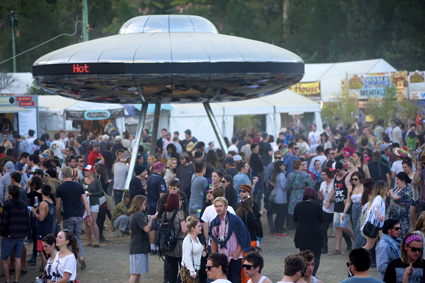
Splendour in the Grass, Close Encounter, Jordana Maisie
photo Brenden Allen
Splendour in the Grass, Close Encounter, Jordana Maisie
FOR SEVERAL YEARS NOW, ARTIST CRAIG WALSH HAS OVERSEEN AN ARTS PROGRAM AT THE LARGE-SCALE ROCK FESTIVAL SPLENDOUR IN THE GRASS. THE INCLUSION OF CONTEMPORARY ART AT SUCH AN EVENT HAD PREVIOUSLY BEEN SOMETHING OF AN ANOMALY IN THE AUSTRALIAN MUSIC FESTIVAL LANDSCAPE—OR AT LEAST AT THE MORE ROCK’N’ROLL, GEN Y-ORIENTED END OF THE SPECTRUM—SO SPLENDOUR’S INVESTMENT IN THIS AREA IS AN INTRIGUING AND NOTEWORTHY PHENOMENON THAT HAS THUS FAR FLOWN LARGELY UNDER THE RADAR OF MAINSTREAM AUSTRALIAN ART DISCOURSE.
From humble beginnings, the Splendour in the Grass Arts program has continuously expanded, in what seems like an ongoing investigation of just what exactly the possibilities for art might be in this spectacular, pop culture-oriented event. Walsh is an experienced media artist and a leading proponent of the creation of work for non-gallery environments, so he is a fitting choice to head up this project. Particularly interesting amongst these creative possibilities has been the development of the Splendid Arts Lab: a program inaugurated in 2009 and largely funded by the Australia Council’s Opportunities for Young and Emerging Artists initiative, in partnership with Splendour itself and a consortium of regional galleries and organisations situated close to the festival’s original site of Belongil Fields, in the Northern Rivers of New South Wales (the festival has relocated to Woodford, Queensland, for the past two years). In 2009-2011, the Splendid Arts Lab has supported a group of young and emerging artists to attend Splendour in the Grass and a connected art-making laboratory that is designed around the conceit of making a site-specific, interdisciplinary, collaborative work to intervene into this loaded environment. Following the lab and a development period, the artists propose their works to a curatorium, and several works are selected to be made for the following year’s festival.
On paper it seems like a no-brainer, particularly from a funder’s perspective. Gen Y artists, making work for a Gen Y festival, in a groundbreaking, cross-disciplinary style. But the realities of making art for this context are more complex than those tick-boxes would suggest. Firstly, the field of site-specific and socially engaged practice is somewhat under-resourced and underdeveloped in Australia, with few of our major arts institutions supporting the development and presentation of this mode of work. Secondly, as far as situations for site-specific work go, you couldn’t get a site more specific than Splendour in the Grass. A clear-felled, rambling area in the middle of the bush, usually occupied by an annual folk festival, being temporarily overtaken by a massive rock festival, replete with 30,000-odd (mostly white, mostly twentysomething, mostly intoxicated) punters, food stalls, amusements and of course the dozens of bands, DJs and musicians across genres that everyone is there for in the first place.
In short, Splendour is like a mini-city, built around the particular desires of a particular demographic, designed to solicit their interaction, enjoyment and, of course, their cash. Such a setting would be a challenge for any artist to grapple with, and for a young emerging artist who is launching into their practice, the complexities of such a proposition might be especially daunting. Having been employed by Splendid as a Provocateur on the 2010 Lab, I have a particular attachment to these artists and to the developmental process that they undertook. It was encouraging to see them respond to the abovementioned challenges with unflinching rigour, enthusiasm and curiosity. Opportunities to focus on process, and really unpack the complexities around making work—particularly site-specific work—are rare, and so Splendid has provided an important service in this regard. For this year’s festival, three artists from the 2010 Splendid Arts Lab were selected to create work: Jordana Maisie, Jimmy McGilchrist and Matthew Kneale, although Kneale’s performance intervention was unfortunately abandoned due to logistical uncertainties—a real shame considering the rich potential for performance practices in this arena.
Jordana Maisie’s sculpture Close Encounters provided a meeting point at the festival’s Mix Up Stage. Taking the form of a large-scale UFO, its gleaming metallic surface hovering over the crowd, Close Encounters offered an inverted reflection of the ground-level spectacle of the punters themselves. Embedded in its side surface was an LED screen, the kind beloved by lottery kiosks and Jenny Holzer alike. Through an SMS service, festival goers could “talk to the aliens” and have their short-form communiqués broadcast on the screen for all to see. Unsurprisingly, there were a lot of jokes and friends shouting out to other friends, a kind of banal toilet-door-graffiti talk. But these were punctuated by the odd message that was genuinely eccentric or heartfelt. Meanwhile, the artists were concealed behind a nearby fence, sending the punters’ messages to the screen and posting their own replies, presumably from the aliens’ perspective, creating micro dialogues. These text-based interactions were an odd reflection on the ‘heightened’ state of the festival audience, and became mini portraits of the strange modes of socialisation that were taking place around the festival. Despite the technical wizardry, my favourite part of the work was its central shaft—a cylindrical mirrored portal at the centre of the UFO that visually transported punters away from this tangle of crowd and (mis)communication, into the uninterrupted calmness of the sky. A moment of quietness and the sublime amidst the relentless spectacle.
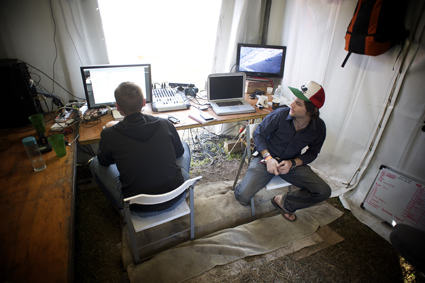
Behind the scenes, Curious Creatures
photo Brendan Allen
Behind the scenes, Curious Creatures
The other work commissioned through the Splendid program was Jimmy McGilchrist’s interactive shadow projection Curious Creatures. Half-concealed up a hillside, people were drawn towards the work by the strange animal-like noises it emanated, and the soft white glow of the projection screens. Across a panoramic screen surface, the shadows of several peculiar, children’s story-book animals roamed a sparse, alien landscape. As viewers approached the screen, their own shadow appeared in the scene and the creatures were drawn to it, running over to interact in vicious, loving, or baffling ways. This deceptively simple effect was in fact a complex programming feat, operated by McGilchrist and his collaborators behind the scenes. Though markedly different in their aesthetic and conceptual strategies, it is interesting to note that both McGilchrist’s and Maisie’s works harnessed digital, interactive technologies to engage the distractible festival-goers, suggesting a potential-laden way of connecting art with a transient crowd such as this.
Beyond the Splendid program, Walsh has been exploring other ways to activate the festival site and its audience through artistic intervention. This year, the Cream program, curated by Annemarie Kohn, brought three artists working with ephemeral, street-based practices together to create temporary interventions into the festival landscape of Splendour. The masking-tape murals of Buff Dis; Oliver in the Sky’s cardboard pop sculptures; and Fernando Llanos’ projections onto a customized blimp provided a counterpoint to Maisie and McGilchrist’s tech- and material-heavy works. Installed responsively throughout the three-day festival, the execution of these temporary works gained an extra performative edge in the heightened but highly contained festival site. Fleet-footed and engaging, the Cream program hinted at exciting approaches yet to come in the Splendour Arts context.
Splendour in the Grass, Splendour Arts program, Woodford, 29-31 July, http://splendourinthegrass.com; Splendid Arts Lab, Lismore and Woodford, www.splendid.org.au
RealTime issue #105 Oct-Nov 2011 pg. 3
© Jeff Khan; for permission to reproduce apply to realtime@realtimearts.net
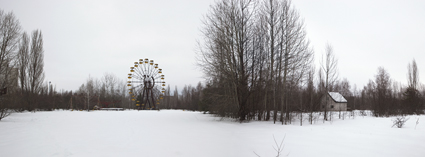
Precarious, Merilyn Fairskye
COMBINING A CINEMATOGRAPHIC FLAIR FOR MOMENTUM AND A PHOTOGRAPHIC EYE FOR THE MOMENT, MERILYN FAIRSKYE HAS, IN PRECARIOUS, HER FIRST FEATURE-LENGTH FILM, CREATED A CHILLINGLY BEAUTIFUL ACCOUNT OF THE AFTERMATH OF THE CHERNOBYL NUCLEAR REACTOR DISASTER OF APRIL 26, 1986 IN THE NOW INDEPENDENT UKRAINE, BUT EFFECTING IN ONE WAY OR ANOTHER LARGE PARTS OF THE POPULATION, ECONOMY AND ECOLOGY OF THE FORMER USSR. WE ARE TOLD IN THE OPENING TITLES, “OVER 600,000-700,000 PEOPLE KNOWN AS LIQUIDATORS TOOK PART IN THE CLEAN-UP.”
These people from across the USSR, along with the plant’s workers, locals and the citizens of nearby towns continue to be the victims of the Chernobyl catastrophe with an expected surge of cancer cases in 2011—25 years after the fire.
Precarious opens with a bleak winter landscape viewed through, but not visibly framed by, the passenger window of a moving car—dark, leafless trees and now and then apparently deserted houses glide by, the sky as white as the snow on the ground. We will learn later what this place is. The sense of desolation is reinforced by Robert Hindley’s haunting sound score (Fairskye had asked the sound designer to “put himself inside the reactor”).
Our gaze is focused on the landscape while we listen to five people—a former helicopter pilot, a scientist, a medical specialist, an information officer, a researcher and a former Intourist worker). They remain unseen and the filmmaker’s questions elided. Their accounts (in Russian and spare English, subtitled) of the event and its consequences are woven through the body of the film. One of them, a former newspaper photographer, speaks of his frustration at being denied access to the incident site during the crisis. An oncologist in Kiev speaks about his commitment to rehabilitation and the prevention of radiation poisoning. Another voice tells us that the layer of contaminated surface material in the region is buried in snow, making the place relatively safe in winter. The mesmeric ride through this grim landscape and these calmly spoken but disturbing testaments create the first of an increasing number of polarities.
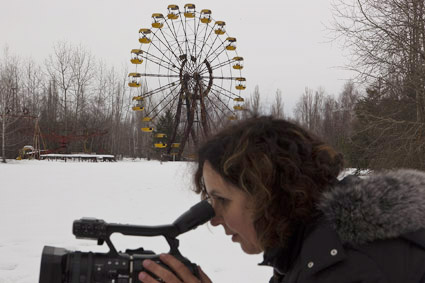
Precarious, Merilyn Fairskye
We find ourselves on the boardwalk in Alushta gazing at the contaminated Black Sea, the movement now in the waves and the sound of their fall; the camera is still, framing the water, the immediate coastline walkway and buildings from various points. People amble by. One of the intreviewees recalls “respectable men using means legal and illegal to get through the checkpoint,” to flee the disaster. Families, not trusting government assurances, soon sent their children away—sometimes “trainloads of children were turned back.” But many did go to other parts of the USSR. Alushta was now “[a] city without children…it was like an unpleasant science fiction film.” As for today, one interviewee simply says, “we’ve got to live; adjust somehow.” Meanwhile night comes on and sea and sky fill the screen, this time enveloping us with barely contrasting Rothko-ish deep and deeper grey-blue.
Taking in the elegant, elderly city of Yalta, we hear of the 8,000 workers who continue to flow into Chernobyl and the city of Prypiat for one-off three-week shifts and of the young firemen who battled the Reactor 4 blaze in 1986 only to “quietly disappear from life.” One of two eerie satellite images in the film closes in on the region, indicating the direction of the flow that will come with Spring of contaminated water from Chernobyl to cities and into the Black Sea.
In a grey Kiev the camera tilts to take in the golds, greens and blues of Orthodox churches and then fixes on a distant view of the city from a park as we listen to recollections of a warm, sunny, cheerful May Day parade. The government had issued no news about Chernobyl—there were only rumours almost a week after the event, only dignitaries sending their children away. And then came the news and advice: take charcoal and iodine and drink vodka. Kiev becomes a city inhabited only by men. The helicopter pilot speaks for the many liquidators: the job was an honour, there was no choice, “We were educated to be like this.”
Now we’re on the road to Chernobyl, on the edge of the Exclusion Zone where residents are banned from hunting, fishing and gathering berries and cannot sell their produce: “Ten years of our lives have been stolen from us.” Soon we’re inside the zone, the camera closing in on the rusting “sarcophagus” of Reactor 4, its new containment as yet still not built. An aerial view suspends us above the Reactor’s inadequate cooling pond. A line of trees is described as the Red Forest because after the explosion its summer leaves turned red—the soundtrack flutters as if to evoke in the distance “the crazy singing of Geiger counters” that one interviewee spoke of earlier in the film.
Within the Exclusion Zone we drift through the ghost city of Prypiat, its streets full of wild new growth stilled temporarily by Winter. But we know liquidators will be somewhere here while, around the city, displaced locals illegally search the zone for fish, animals and scrap metal. The helicopter pilot, like many others has received a Badge of Honour but his illness drives him away to Israel. The camera pans to rest on a never-to-be-used Ferris wheel, due to begin operating at the time of the fire, adding the faintest touch of colour, not to mention irony, to the otherwise black and white scene. In the Stills Gallery, a large, wide photograph of the wheel dominates our gaze as the film plays out on the mezzanine.
Precarious, says Fairskye at her artist’s talk, was “never planned, but came out of a Black Sea holiday [because] of a long term fascination—I had to go to the Crimea.” She went alone in 2009, staying in “an otherwise empty 5-star hotel in a deserted town [Alushta] on the edge of contaminated water.” There she picked up a silk map of the region, “once restricted information from 1947.” A name grabbed her attention—Chernobyl. She felt she must go there and, once through the checkpoint, found herself “immersed in another world, faced with a remarkable opportunity and provided with an official driver and a guide heading into the heart of Prypiat,” 18kms from the Chernobyl nuclear power plant and inside the Exclusion Zone. It was after being taken to see the Ferris wheel that Fairskye felt like she was “at the end of the world. There was not a sound. That’s when the film began to take shape. Before that I’d been shooting randomly and when I got home to Australia the material looked patchy.”
So, at exactly the same time a year later, Fairskye returned, this time with her Russian-speaking partner as interpreter and plenty of research behind her about the consequences of the Reactor 4 explosion in the Chernobyl Nuclear Power Plant. She was anxious that the promised new containment of the reactor might provide imagery quite different from that of her first visit, but the government had not followed through on its promised spending, “so, ironically, I got continuity.” All that can be done with Chernobyl is containment while 35% of the GNP of Russia, Belarus and Ukraine goes towards remediation, health and the 8,000 workers who manage the zone.
Fairskye thinks that “there’s a national state of mind that the site is a force that cannot be contained. At its centre is the so-called ‘elephant’s foot,’ 200 tonnes of festering fuel.”
For her interviews, Fairskye’s strategy was to ask a simple question or two and let people speak, which they did: “they wanted to tell their stories. But none of the speakers appears onscreen. I had no desire to be dramatic—we just listen and watch.” She found herself “humbled by the stoicism” of the people she spoke with, the effort evident in their tone “to be nice, to make things normal, even though there is no end in sight.” She was struck by the strangeness of Prypiat “taken over by dense curtains of foliage and vines,” and the heavy covering of snow—”snow and ice damp down the radiation, so the bleaker the landscape the safer.”
As for her filming, “I have a fondness for the pan—to take it all in and see what’s there.” In the car, “I had the camera on all the time, handheld, but I wasn’t looking through it.” She speaks of a sense of “looking out,” which we share with the people who wander through the Kiev scenes, like tourists. Sometimes she used a tripod, panning and not knowing how it would turn out. At times “it was a real nightmare, the camera and the tripod freezing in the cold, making some material unuseable.” Although shot in colour, the effect is monochromatic because of the Winter weather: “I’ve always admired Kieslowski’s Decalogue where he almost pulls out all the colour, but in this case it was natural.”
Was Precarious made as a statement about nuclear power and political irresponsibility, I ask. Fairskye is firm: “I had no political intention. I was just taken by it all. Life was tapping me on the shoulder, saying look at this.” Nevertheless, as Edward Scheer writes in his fine accompanying essay, “In the year of the meltdown at Fukushima [the film’s images] provoke some reflection, not only on the nuclear question, which is everywhere in the public discourse, but also on the status of the image to both reassure and to trouble the way we think about a disaster as fundamental as a tear in the fabric of the natural world.”
As the film speeds us away from this haunted zone, the sun appears low in the sky, partly veiled in swathes of grey and white cloud, an almost Baroque vision with an abstract expressionist overlay: trees blurring past, black verticals as if grimly brush-stroked in, apt accompaniment to the final sad sentiment as a woman quietly says, “We don’t learn from our mistakes.”
Precarious, conception, camera, editing Merilyn Fairskye, sound design & mixing Robert Hindley, online editor & grading Greg Ferris, Plus+Minus Productions, 66mins, 2011, www.precarious.com.au; Stills Gallery, Aug 3-Sept 3, artist’s talk Sept 3
RealTime issue #105 Oct-Nov 2011 pg.
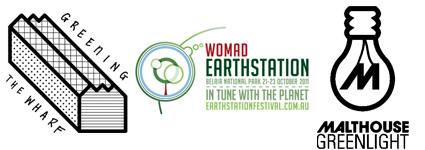 WHILE REAL TIME HAS RECENTLY DOCUMENTED A NUMBER OF MEDIA AND VISUAL ARTS PROJECTS DEALING WITH ISSUES OF SUSTAINABILITY (RT103), THERE HAVE BEEN FEW REPORTS OF THEATRE, MUSIC OR DANCE PRODUCTIONS TACKLING GREEN TOPICS. WITH A FEW EXCEPTIONS, THE PERFORMING ARTS SECTOR SEEMS LESS INCLINED TO INCORPORATE THE CONTEMPORARY DISCOURSE OF CARBON TAX DEBATES INTO STAGED PRODUCTIONS.
WHILE REAL TIME HAS RECENTLY DOCUMENTED A NUMBER OF MEDIA AND VISUAL ARTS PROJECTS DEALING WITH ISSUES OF SUSTAINABILITY (RT103), THERE HAVE BEEN FEW REPORTS OF THEATRE, MUSIC OR DANCE PRODUCTIONS TACKLING GREEN TOPICS. WITH A FEW EXCEPTIONS, THE PERFORMING ARTS SECTOR SEEMS LESS INCLINED TO INCORPORATE THE CONTEMPORARY DISCOURSE OF CARBON TAX DEBATES INTO STAGED PRODUCTIONS.
If all things sustainable have not yet infiltrated the rehearsal room, they have started to change the producing structures. Sydney Theatre Company, for example, is positioning itself as a world leader, with its Greening the Wharf program, “believed to be a first of its kind for any theatre company in the world in its scale and comprehensive approach to sustainability” (sydneytheatre.com.au/visit/greening-the-wharf). The rainwater harvesting, solar power, waste reduction and programming of science and art talks (The Wentworth Talks series) makes STC a model for engagement with green issues.
Malthouse Theatre in Melbourne is another production house that is engaging with sustainability in major structural and program changes. Malthouse Greenlight includes an innovative recycling program for the many industrial lights used throughout the building and on the stages (malthousetheatre.com.au/page/MALTHOUSE_GREENLIGHT). A carbon surcharge on tickets, educational programs with green themes and the hosting of the very successful Tipping Point meeting in 2010 all contribute to a lively and multifaceted corporate engagement with sustainability.
Other major organisations in Australia engaging with infrastructure change include Queensland Theatre Company who launched the Green Theatre Initiative in 2008 and The Australian Ballet who are reducing the carbon footprint across their operations. City of Melbourne venue and producer Arts House has a very popular Green Tix for Nix project (melbourne.vic.gov.au/ArtsHouse/Program/Pages/GreenTixForNix.aspx) where those who travel by public transport, foot or bicycle receive free tickets to a weekend matinee.
These initiatives and many more are listed in Greening the Arts, the online resource published by Tipping Point, an international organisation that “energises the cultural response to climate change.” In Australia it is led by Angharad Wynne-Jones who is now the Creative Producer for Melbourne’s Arts House. Greening the Arts surveys sustainable arts and culture activities in Australia and is still the most comprehensive resource for the sector. When taken in conjunction with the many international publications to which it links, such as the Green Rider or the Green Mobility Guide created by Julie’s Bicycle, the pioneering London based organisation “making environmental sustainability intrinsic to the business, art and ethics of music, theatre and the creative industries,” this document will assist most arts organisations in achieving carbon neutrality while starting to introduce dialogue around green matters into their programs and projects. See on-the-move.org/files/Green-Mobility-Guide.pdf; tippingpointaustralia.com/resources, and juliesbicycle.com/resources/jb-green-riders.
Since the guide was released in 2010 there have been a few new initiatives, such as Earth Station, a satellite event to WOMADelaide. Earth Station is “both forum and festival” and includes a full program of performances and art works as well as panels and debates over three days. Art works dealing with sustainability topics such as Stan’s Café’s installation, Of All the People in All the World, are accompanied by speakers such as former Al Gore chief of staff Roy Neel and Giselle Weybrecht, author of The Sustainable MBA as well as Cate Blanchett and Andrew Upton. Perhaps inspired by international projects such as A Greener Festival, where leading music festivals have prioritised camping, reduced waste and emissions and incorporated discussion and debate, this new addition to the Australian festival sector will hopefully inspire other forward thinking festivals to follow suit. For details take a look at earthstationfestival.com.au and www.agreenerfestival.com.
So, as old buildings are renovated to reduce their carbon footprint and organisations strive to be carbon negative, artists are starting to explore new ways of making their work and taking it to their audiences. In a rousing article in Greening the Arts, Wynne-Jones looks forward to a new cultural entrepreneur: the artist-as-producer. “Who better than artists-as-producers to re-imagine the cultural infrastructure, funding frameworks and networks we’ll need in a zero carbon future, who better than those for whom the bottom line has never been the motivator.” Wynne-Jones writes about the need for a “fit-for-purpose infrastructure” where the artists-as-producers design a new set of tools for creating art and taking it to audiences. She imagines alternative forms of artistic encounter, where “our virtual capacity needs to be imaginatively maximised.” She writes of “face-to-face as a privilege” and has followed through on these thoughts in her Tipping Point commissions. In Home Art (homeartproject.com) in partnership with City of Melbourne, Lucy Guerin has been commissioned to create a series of art works in the homes of audiences, taking the art out of the infrastructure and into another form of connection. In Riot, the Tipping Point/Dara Foundation/Malthouse Theatre Climate Commission, Torque Show will stage a riot in which popular dissent and direct action become a form of performance.
Tipping Point is also partnered with the Australia Council’s IETM Collaboration Project on a climate commission with Kaaitheater in Brussels. Entitled Time’s Up: Control of the Commons, this project by Tim Boykett takes a series of watercourse journeys in Australia and Europe, investigating water usage, attitudes to water and kinship/friendship networks. The presentation at the Burning Ice Festival at Kaaitheater in June 2012 will include direct documentation, interviews, photography and video mapping.
Long term artist-producer, David Pledger, the outgoing Director of the Australia Council IETM Collaboration Project, contextualises this project in a European dimension in his blog on the Australia Council website entitled Do Nothing Do Something. Pledger is working with Julie’s Bicycle to measure the carbon footprint of his entire program. Pledger’s blog responds to the second of the Slow Boat conferences, initiated in 2009 by The British Council and Arts Admin to consider sustainable arts touring and perpetuated in 2010 by Kaaitheater in Brussels. He wrote of the conference’s problematising of cultural exchange and mobility as “a motivation and opportunity for artists, programmers and presenters to rethink what we do, and evolve cultural production imaginatively by developing new dramaturgical templates to create new work and new producing environments in which that work can happen” (www.australiacouncil.gov.au/special_projects).
The Slow Boat conference challenged the value of mobility with questions that included: “How can we genuinely reduce the ecological footprint of all our travels and tours?”; “Would better and more efficient co-operation and networking be a way of bringing down CO2 emissions?”; “Are such terms as ‘relocalising’ and ‘permaculture,' which crop up increasingly in the debate on a transition to a sustainable society, relevant to the arts too?”; “Is the nomadic existence many artists lead still desirable?” (vti.be/en/projects/slow-boat-2).
With the current political, social and financial turmoil in Europe and North America many Australian artists will be rethinking their touring plans and hopefully, inspired by Greening the Arts and other publications and initiatives, they will begin to explore more inventive routes to audiences, whether in their own communities or internationally via new media. Having recently collaborated on a publication examining the trend for international co-productions and in these same pages reported upon the growth in the international activity of Australian artists and companies, it is interesting to note that the tide that has to date so favoured mobility and exchange may now be turning. Ironically, the restrictions imposed upon artists often lead to the most impressive art, so there is great hope that straitened times might lead to longer residencies, works remaining in repertoire, more participatory projects, more innovative communications over distance between artists, more inventive exchanging of scores and other performance 'texts' and a general flourishing of the inspired and dynamic artist-as-producer.
Sophie Travers and Judith Staines edited the International Co-Production Manual, subtitled “the journey which is full of surprises,” published by KAMS (Korean Arts Management Services) and IETM (International network for contemporary performing arts, March 2011. For more information go to IETM
(http://www.ietm.org/index.lasso?p=information&q=resourcedetail&id=125&-session=s:5B5591691638313D99iHmODC7F11) or download a PDF version of the manual (http://www.ietm.org/upload/files/2_20110615110511.pdf).
RealTime issue #105 Oct-Nov 2011 pg.
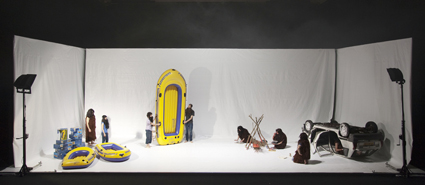
Big Bang
photo Martin Argyroglo Callias Bey
Big Bang
WE ARE LIVING IN UNCERTAIN TIMES. STABLE CLIMATE, LIBERAL DEMOCRACY, CAPITALISM AND THE GLOBAL DOMINANCE OF WESTERN CIVILISATION ARE ALL LOOKING LIKE THEIR TIME MIGHT HAVE PASSED. A SIMILAR SENSE OF IMPENDING CRISIS IS TANGIBLE ACROSS THE STATE FUNDED ARTS IN EUROPE. THIS YEAR’S EUROKAZ PROCEEDED IN A SPIRIT OF AUSTERITY, ITS BUDGET REDUCED BY A STAGGERING 30% AT THE 11TH HOUR.
With the program accordingly thinner, it was hard to escape the feeling that much contextualising of the remaining works had also disappeared. The curatorial thread of the festival was reduced to a dashed, disconnected line: successful works remained, but were significantly less eloquent about each other than is usually the case.
Between tableau theatre, Congolese performance, dance on science and an entire video retrospective on Christoph Schlingensief, critics had to deal with a cacophony. However, the highlights of the festival could be lined up as examples—if stand-alone—on how to speak, how to make a sound, on the future of the world.
noise
This year’s program-within-the-program consisted of four performances by emerging artists, created within the European Focus on Art and Science in the Performing Arts. Unfortunately, the majority of works presented could be dismissed as ‘Chunky-Move-on-a-Shoestring.’ The conceptual framework often appeared no deeper than placing a machine among the dancers and turning it on, but the machines—unlike Chunky’s often brilliantly innovative technology—seldom excited with their possibilities. So Santasangre’s Bestiale Improvviso (Beastly all of a Sudden) delivered dancerly twitching to harsh sounds and stormy lighting, atmospheric but hardly thought-through. Technology in this context, disappointingly, was largely interpreted as noise and flashing lights, a well-worn metaphor for impending catastrophe. In contrast, WE GO vzw/Vincenzo Carta presented Gnosis #1, a research-driven work, the main thrust of which was the dancers’ states of mind activating stage lights of different colours. However, while this resulted in fairly opaque stage business, the mechanics of the translation of mind to light was never explained sufficiently, leaving the audience sceptical as to the exact method employed and unable to judge its success or failure.
I would single out Dewey Dell’s Cinquanta Urlanti Quaranta Ruggenti Sessanta Stridenti (Furious Fifties, Roaring Forties, Shrieking Sixties) as the most successful in this program—not because it offered significantly greater dramaturgical thrust (it did not), not even because it engaged with technology beyond the obvious (it did not), but because its sheer strangeness was unapologetically devoid of either facile catastrophism or technophiliac laziness. Three young women, the next generation of the Castellucci family, appear on stage in padded black unitards that exaggerate their thighs, white-painted arms and faces in similar blistering white, but with central black circles, resembling the traditional Venetian moretta (or ‘mute maid’—a small, round woman’s mask, held in place by biting onto the button on the underside). A series of very simple movements—arms slicing, small hops, upper body swaying—rigorously correlates with Demetrio Castellucci’s music, a rhythmic bunch of roaring, shrieking noises, every so often embracing a broad tune, such as a two-tone siren wail. But instead of attempting to illustrate a tragedy, Dewey Dell create a dark, childishly primal pantomime of a badly remembered nightmare. There are seas, shipwrecks, maidens in distress and sandmen in this show, all executed in an aesthetic realm halfway between Lemony Snicket and Michel Gondry’s music video for Daft Punk’s “Around the World.” Vaguely built around the mystical harshness of the Antarctic winds, the performance lacks the maturity of Societas Raffaello Sanzio’s adult works, but is powerfully visceral in the best sense of the word.
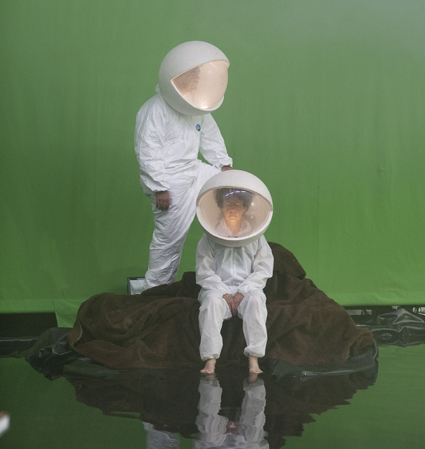
Big Bang
photo Martin Argyroglo Callias Bey
Big Bang
silence
From these relatively superficial explorations of a noisy cataclysm, Philippe Quesne and Vivarium Studio proceed to play with silence. Big Bang, defying expectations, opens with a woman reading at a table, silently constructing the word BANG from wooden letters. The end of the world again. However, instead of pathos, Quesne offers soft, benevolent humour. The evolution recommences. Amoeba-like creatures, crawling on barren land, rise into hairy apes around a fire and surprisingly quickly evolve into humans sitting in an upturned car, reading Chris Ware’s comics and drinking beer from cans. A lake appears, as do astronauts, and someone is always walking around with a sketchbook, finding aesthetic pleasure in the cataclysm. The scale shifts between miniature and lifesize, a number of performers in green overalls walk around unperturbed, setting the scene and a small island is formed from the debris upstage.
Quesne’s background is in set design, and the work builds as a series of gradually shifting tableaux; the dramatic structure is entirely unencumbered by words. His professed aim is to develop a new dramaturgy that evolves around an almost anthropological observation of the human microcosm, sidelining the simplistic inquiries of text-based theatre. Ambitious, but Big Bang—despite sometimes gruelling slowness—is never hostile to the spectator; Quesne has quickly become an audience favourite in France. His post-Bang trajectory from plankton to postmodernism is gentle, melancholy and humorous and we are quietly entertained despite having sat through the end of the world—twice. However, Big Bang also plunges one into the sludge of First World resignation, no less genuine, or troubling, for its Tati-like sweetness. Watching it almost feels like making peace with despair—or perhaps walking into and through it.
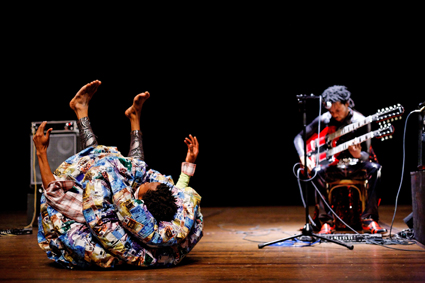
More more more future
photo Agathe Poupeney
More more more future
talking
Faustin Linyekula and Studio Kabako’s More more more…future begins where Quesne ends, with impotent silence at the end of the world. Linyekula starts at a real, non-metaphorical place of catastrophe: his native Democratic Republic of Congo, still blistering from the biggest war in African history. Trying to use the social power of music, Linyekula wants to marry ndombolo—hugely popular Congolese pop music, wild and energetic and profoundly escapist, carrying with itself a culture of bling—to the political spirit of punk. The show is structured as a musical performance, centre-stage given over to the Kinshasa guitar sensation Flamme Kapaya. He performs a powerful mix of hip-swinging ndombolo and raging rock to the seething lyrics of poet Antoine Vumilia Muhindo, a political prisoner in Kinshasa and Linyekula’s childhood friend.
So far, so predictable. But the emotional trajectory of this concert is devastating. Muhindo’s lyrics unravel the history of Congo, from clinging to tradition, idols and ideology to the revolution against Mobutu, and the illusory promise of democracy that ends in civil war. Muhindo weaves in Zarathustra’s thoughts on the ever-turning cycle of history, but continues to invoke a break to the pattern: “more than a glorious past, give us the future.” The future here stands not even for a time in which our optimistic plans come to fruition, but a time in which optimism has a chance to exist. It is a call for hope, the same one spoken about by Deo Masugi in SBS’s documentary Go Back To Where You Came From (director Ivan Mahoney). After 10 years in a refugee camp, “we can’t ask for anything more than tomorrow.”
While the musicians are dressed in ‘authentic’ ndombolo glitter and gold, the three dancers wear frilly, ballooning outfits made from refugee bags [cheaply made sacks of woven nylon fibres. Eds]. They begin with simple ndombolo dancing. As the music heaves and grows in anger, it also transforms into trance, madness and, finally, violence. The energy on stage is numbing. Why not live for today, if there is no tomorrow? “Carpe diem, even if it’s the middle of the night.” And then, after the physical fighting has subsided, the thread of the performance is slowly picked up again.
Writing on political performance, cardinal Flemish dramaturg Marianne Van Kerkhoven has said, “A process of truly interiorising the social options is for the ‘political artist’ probably the most important artistic deed.” This is a profoundly political work, agitating without propaganda and empathetic without resignation. In a Gramscian sense, it couples pessimism of intellect with optimism of the will. Unlike others in the program, it is not a romantically apocalyptic narrative, but an attempt to articulate a way out of a real cataclysm. Linyekula does not romanticise the political power of music, nor African sensuality, but neither does he cerebrally avoid them. Instead, he acknowledges ndombolo’s agonistic tendencies, seeks to uncover its generative potential and allows it to disintegrate as it naturally would. Yet the performance does not end in despair, but with sombre, tenacious hope. Linyekula goes that one step beyond Robyn Orlin’s Dressed to Kill…Killed to Dress… (RT 87,p38), not simply staging a culture of escapism and excess, but pushing it to come to its own catharsis.
An ethical question that increasingly troubles me at Eurokaz is the misplaced colonialism of the continuous importation of First World melancholy and cynicism, through art, into a culture of a developing country. It is often genuinely unsettling to see the apathy of a consumer society, in which all of one’s insignificant wishes are a priori sated, performed in front of an audience of precariously-employed, politically disenfranchised, economically doomed citizens of an unstable democracy. Last year’s Ballad of Ricky and Ronny (RT98) was one such instance, this year’s Big Bang another. The high value accorded to such art, its forms and ideas, always teeters on the possibility of creating an educated apathy where it is least needed and imports melancholy as a baseless fashion. There is a place for melancholy performance, and for apocalypse, but there is also a somewhat conspicuous excess of both in the world today—perhaps a natural extension of the general state of crisis we are living through. There is a lot more to take home—from the kind of questioning to the cathartic path out—a lot more that is intelligent, emotionally rich and, ultimately, new from the work of Faustin Linyekula.
Bestiale Improvviso, Santasangre, authors Diana Arbib, Luca Brinchi, Maria Carmela Milano, Pasquale Tricoci, Roberta Zanardo, MSU, June 28; Gnosis #1, WE GO vzw/Vincenzo Carta, concept, choreography Vincenzo Carta, concept, soundscape Ongakuaw, MCUK, June 29; Cinquanta Urlanti Quaranta Ruggenti Sessanta Stridenti, Dewey Dell, choreography Teodora Castellucci, performers Sara Angelini, Agata Castellucci, Teodora Castellucci, sound design Demetrio Castellucci, set and light Eugenio Resta, MSU, June 29; Big Bang, Philippe Quesne/Vivarium Studio, concept, direction Philippe Quesne, artistic and technical collaboration Yvan Cledat, Cyril Gomez-Mathieu, production Vivarium Studio, ZKM, July 4-5; More more more… future, Faustin Linyekula/Studios KABAKO, author Faustin Linyekula, music Flamme Kapaya, Patou ‘Tempête’ Kayembe, Le Coq, Cédric ‘Béton’ Lokamba, Patient Mafutala Useni, dancers Dinozord, Papy Ebotani, Faustin Linyekula, text Antoine Vumilia Muhindo, production Studios Kabako, Dance Centre Zagreb, July 3, 5; Eurokaz festival, Zagreb, June 27-July 5
RealTime issue #105 Oct-Nov 2011 pg. 4
© Jana Perkovic; for permission to reproduce apply to realtime@realtimearts.net












































































 WHILE REAL TIME HAS RECENTLY DOCUMENTED A NUMBER OF MEDIA AND VISUAL ARTS PROJECTS DEALING WITH ISSUES OF SUSTAINABILITY (
WHILE REAL TIME HAS RECENTLY DOCUMENTED A NUMBER OF MEDIA AND VISUAL ARTS PROJECTS DEALING WITH ISSUES OF SUSTAINABILITY (



